

7 Popular Sailboats with Two Masts (With Pictures & Prices)
Sailboats can come with one, two, or even more masts. You can also have different-sized masts placed on the front, back, or middle of your vessel.
Below, I have listed popular sailboats that have two masts.
Let’s get started!
Table of Contents
Check also: Average sailboat price examples .
Things to Know About Sailboats With Two Masts
When looking for sailboats with two masts, you should know what you are looking for. A Ketch is one type of sailboat with two masts.
Knowing this term can help you to nail down your search when looking for a boat with two masts.
These boats come in many shapes and sizes as well as many different types of designs. Generally, these types of boats have the taller mast being forward and the smaller mast near the aft.
Yawls are also boats that feature two masts.
These also come in multiple types and designs. The difference between the Ketch and the Yawl is that the Yawl has the larger mast in the aft instead of forward. They also have smaller sails and can be easier to handle.
Another type of sailing ship that features two masts is a Brigantine.
This ship has mixed sailing rigs which commonly features squared sails on the front part of the ship and triangular sails on the back of the ship.
These boats are often larger and require more people to handle them.
7 Great Used Boats with Two Masts
There are many benefits to used boats including a lower cost. You can get a larger boat for a lower cost if you choose to buy used.
When looking at used boats, you need to make sure you look at the boat and its features thoroughly to make sure everything is in great working order.
If you do not feel confident that you can properly look over a used vessel, you can even hire a marine inspector to look it over and let you know of any potential issues or needed repairs. You can use this assessment to decide what is worth it, or if the needed repairs fall into the budget.
It is much more common for a used boat to have more than one mast. This is because the newer sailboat models are creating their new designs with just one mast.
One mast ships are easier to handle and manage so new designs are trying to optimize design and ease of sailing.
Below are great used sailboats with two masts which I have arranged by price .
1. 1976 Westerly Center Cockpit Ketch

This 1976 Westerly Center Cockpit Ketch is a small 36-foot long sailboat with two masts. This is a solidly built cruising vessel that features a center cockpit ketch layout.
This boat has a small 38 horsepower engine perfectly fit to navigate its smaller size.
The interior features 1 single berth and 3 double berths all in 3 cabins. This boat also has 2 full heads onboard.
You also have a full galley with a 4 burner stove, refrigerator and freezer, stainless steel sink, and microwave oven.
This boat makes great use of limited space and offers many amenities in a much smaller frame.
Price: $37,000.00
2. 1978 Jeanneau Gin Fizz

The 1978 Jeanneau Gin Fizz is a trusted and popular two-masted design capable of crossing the Atlantic Ocean .
This boat is also very spacious for a boat that is only 38 feet in length. This model also won an award for “security, comfort, ease of handling, and ability to handle varying conditions.”
This particular used model has been well maintained and upgraded over the years.
This boat is great for family cruising, offshore passages, and even racing.
This boat features a 50 horsepower engine to help navigation.
Inside you can find 2 cabins and 1 head. You will be highly comfortable with air conditioning and other interior luxuries.
Price: $46,000.00
3. 1979 Freedom 40
The Freedom 40 is a classically designed centerboard ketch with two masts. This boat is a great sailor loaded for cruising on the wide-open blue water.
This sailboat is 40 feet in length and features accommodations for six people that include a double-v berth, another double berth, and two single berths.
There is also a full head that can be accessed both from the main salon and aft cabin.
This boat was recently painted and features newer interior fabrics, forced air heating, and much more.
You can find a dinette with separate freezer and refrigeration compartments, a stove with an oven and broiler, a double stainless steel sink, plenty of storage, and other interior features.
This boat also comes with an outboard motor with 50 horsepower and a hard bottom inflatable dinghy.
Price: $54,900.00
4. 1977 Puma 38 Ketch

The Puma 38 Ketch is a two-masted sailboat built for racing like the rest of the Puma sailing line. This brand prides itself on speed and maneuverability.
The 1977 Puma 38 is 34 feet in length with a backup diesel engine that can help you get where you need to go as well as docking into a slip. This motor features more horsepower than the average sailboat with 45 horsepower.
Features on this vessel include autopilot, electrical and manual bilge pumps, a full marine head, running hot water, and refrigerator.
This boat is made of fiberglass with teak finishes and looks well kept. You can find this boat in Spain if you are interested in purchasing it.
Price: $66,099.00
5. 1973 Morgan Out Island 41
Originally designed by Charley Morgan, the Morgan Out Island 41 is a center cockpit shoal-draft cruiser that features two masts.
This larger boat is 41 feet 3 inches in length and features many amenities.
This boat is the tri-cabin version and features interior heating, pressurized hot and cold water, a 2 burner gas oven, and a fridge.
This boat also seats up to 7 in the 3 cabins and the saloon. There are also 2 full heads on this vessel.
This boat is even equipped with an inboard motor . Inboard motors are easier when it comes to navigation including backing up, which is generally hard for sailboats to do.
Price: $68,596.00
6. 1970 Hinckley Bermuda 40

This 1970 Hinckley Bermuda 40 is a gorgeous two-masted boat painted with a mixture of desert sand and oyster white on the exterior and features a beautiful and well-kept deck.
This boat has previously had all her systems replaced and upgraded and features a 40 horsepower engine that was new in 2014.
This boat features a mahogany interior and sleeps up to 6 people in 2 cabins. You can also find a 3 burner propane stove with oven, fridge and compressor, new countertops and plenty of storage.
This boat is a stunning and highly upgraded “must-see” at a very reasonable price.
Price: $129,500.00
7. 1995 Amel Super Maramu

A newer model of sailboat is the 1995 Amel Super Maramu sailboat. This sailboat has two masts and is very long at 53 feet.
This boat features an aft deck, steps molded right into the hull, well-protected cockpit an many other features. This boat has a large 76 horsepower engine which is more than the average sailboat is equipped with.
Inside, this boat features 2 cabins and 2 heads with showers. There is also plenty of storage, air conditioning , and electric heaters. There is also a nice salon and galley with a refrigerator, dishwasher, chest freezer, microwave oven, 3 burner stove, and other appliances.
This boat is great for multiple days out on the water and is new and updated. Because of the year, this was manufactured and the features, this boat has a larger price tag than the previous models.
Price: $299,990.00
Final Thoughts:
Sailboats are a great way to enjoy a day out at sea. Most sailboat models come with sleeping arrangements and even a kitchen. This makes them ideal for trips that will take more than a day.
Having multiple masts allows you to harness the power of the wind better and can increase your speed and directional capabilities.
There are many great choices when it comes to boats with two masts, but newer models are starting to steer away from double mast designs. This does not mean that you cannot get a good boat with two masts.
Used boats can be great choices when it comes to purchasing a boat. This is even more true with large, yacht boats such as the ones listed above.
Just make sure when you buy a used sailboat you check that everything is intact and in good working order and if it is not, you have allotted space in the budget to fix what is needed.
Your new double-masted sailboat should provide you with plenty of long-lasting memories and adventures out on the water while you connect with the wind and the sea.
Click to share...
Yachting World
- Digital Edition

Best catamaran and multihull: We sail the very best yachts on two and three hulls
- Toby Hodges
- March 20, 2024
Toby Hodges takes a look at all the nominees and the winner of the best catamaran and multihull category in the much-anticipated European Yacht of the Year Awards
There are many categories in the European Yacht of the Year awards, from the best luxury yachts and performance yachts to the best yachts for families and event a best specialist yacht category. But with multihulls rapidly increasing in popularity, the best catamaran and multihull category was possibly the most hotly anticipated.
The small number of entrants in this category in no way reflects the rich range or huge demand for multihulls. Many new models were launched by the big yards in the preceding years and they’re struggling to keep up with bulging order books.
However, these three shortlisted represented a choice pick of the latest fast cruisers and each, in their own very different ways, are responding to this insatiable demand for high end space and pace cruising.
Best catamaran and multihull
Best catamaran and multihull winner 2024 – outremer 52.
My highlight test of 2023? Sailing this Outremer 52 for 200 miles over two days and nights! Quite how such a large vessel, one that is capable of doing laps of the planet in true comfort, is also capable of providing such enjoyable sailing is the secret sauce that helps scoop this prize.
And it was pushed hard for this award by the disruptive HH. But the Outremer is such a well rounded, measured and thought out yacht for bluewater cruising at a reliable speed – it’s the full package, a dream boat for family bluewater sailing and arguably the French yard’s best and most refined model to date.
Designer VPLP was tasked with replacing the popular and well proven 51 with more comfort and stowage, while maintaining the performance. It says it took the best of the 55 (which won this award two years ago), and the best of the 51’s deck plan to create this 52. The result means too many good features to point out here, from the variety of helm positions, including a completely protected position inboard using the swing pedestal, to the well conceived spaces. I’d therefore recommend reading our full test report online or in YW’s June 2023 issue!
Neel continues to enjoy its cruising trimaran niche, using the wow factor of bridgedeck accommodation combined with the type of sailing enjoyment and feedback monohull sailors appreciate.
The impressive lightwind performance and direct feel of a Neel I am used to. But I don’t think I’ve ever been so surprised by the amount of cabins or space as I was on this 52. It’s available with four to six cabins plus the option for two crew cabins aft! Some of this maze works well, other areas, such as the forward cabins in the main hull not quite so well. Horizon and rig sightlines and some finishing also leaves room for improvement.
The HH44 seemingly manages to achieve the space and pace balance in a compact 45ft package, while also being one of the most innovative and exciting new production yachts I have sailed. From its looks to layout, to practical on deck solutions such as swing pedestals, side gates through the bulwarks and transom gates that double as swim platforms and boost cockpit security, it’s packed with fresh thinking.
And on the subject of ‘fresh’, the natural ventilation encouraged into the yacht through those massive forward facing coachroof windows which open – a feat made possible thanks to a stiff carbon composite structure – negates any aircon requirements.
With its deep carbon boards and tall carbon rig the HH44 is a powerful, reactive animal to sail. However, it’s the incorporation of the first parallel hybrid electric drive units which really makes this high tech high performance cat stand out. The electric motors are attached to the aft end of conventional diesel engines, not only providing silent power, but renewable energy through regenerative drives while sailing.
Best catamaran and multihull 2023
Best catamaran winner – nautitech 44.
If the very best catamaran delivers the ideal comfort to performance compromise, here’s a catamaran that seems to strike the perfect balance.
For those who cite a lack of visibility and protection as reasons not to choose this aft helm route, try sailing this first – direct steering brings so much more helming pleasure that you get the enjoyable feeling and communication more associated with a monohull. The attention to keeping weight low and central, vacuum infused vinylester build and a low coachroof and boom all aid this performance. The fine entry Lombard-designed hulls allowed us to properly point upwind at 8 knots (in 13), but it was the hands-on steering sensation that really stayed with me.
While there’s no real inside/outside boundary – the saloon bridges both – the Chedal-Anglay interior design works well. It is not as voluminous as some, but is certainly enough to be smugly comfortable at anchor, finished to a good quality, with walnut Alpi trim as standard. The layout option for a ‘smart room’ office/laundry/bunk room or stowage cabin is indeed really smart.
Out of all the multihulls nominated or sailed last year, this cat impressed me the most under sail. It’s the ideal size to go distance sailing, with good performance, low draught and space for family and friends. It had me dreaming.
Balance 482
I was drawn to the Balance 482, thanks to the combination of good looking modern design, high average speeds and, chiefly, the profusion of clever thinking and practical ideas that it brings. The South African build uses a foam core with E-glass laminate and cored furniture for a light weight of 11.3 tonnes, but also with the ability to take a generous payload.
An electric furler option combined with screecher sail helps offer effortless handling and fun sailing, although the 482 prefers a breeze in the double figures. Smart options such as load cells on the rigging, a bowsprit camera to monitor the anchor chain, plus engine room and mast cams all help for maintaining vigilance. Other features we like include the solar panels properly installed on raised brackets, raincatchers built into the coachroof, and how all sheets and lines are led to the helm station. But the prize solution is the VersaHelm, which allows you to swing the wheel inboard, close off the helm station, and stand watch and steer from a fully protected position.
Catana Ocean Class
The Catana Ocean Class is a bulky model which is geared more towards creature comforts than the higher performance of its predecessors. That said, it uses carbon in the structure and roof, foam cored furniture, the tanks are mounted low in the hulls and it has daggerboards and fine entry bows. The weight savings help it offer a massive 5.5 tonne cruising payload, plus there’s capacious stowage and large tank, refrigeration and laundry capacity.
Positioned between Lagoon and Outremer, the Catana echoes a bit of its sister brand Bali’s concept with its internal cockpit-cum-saloon layout while providing good ventilation via large sliding doors and opening windows. We liked how it’s easy to handle solo from one helm station, including the electric remote control of the boards, plus the layout of the galley and navstation.
Those chasing speed and helming pleasure should perhaps look to the C-Cat 48, as it’s as close to helming a fast monohull as a cruising cat is likely to get and one of the rare times we enjoyed sailing upwind in light breezes on a multihull! This is largely thanks to a lightweight, stiff build – the Comar yard has managed to save 1.7 tonnes over the first boat (9.5 tonnes light) and increased the draught of the curved daggerboards to 2.95m.
A carbon roof and rig comes as standard, as well as an epoxy hull, full carbon deck, bulkheads and compression beam. It is a little quirky with comparatively small volumes, but this François Perus design will outperform most other performance cats and monohulls of a similar length.
The Excess 14 shares that direct sensation you get from aft helms and some of the performance of the C-Cat, but in a more balanced, voluminous layout for cruising. The Excess 14 benefits from the research of VPLP’s Vannes racing office, where attention was focused on weight reduction, with savings particularly in furniture, on improved stiffness (PET foam cored sandwich for main structural bulkheads), and the efficiency of deeper fixed keels.
The result is telling on the water, as it should be for any best catamaran contender, where you can log easy miles: we clocked late 7s upwind, reached in the late 8s and regularly averaged 9 knots with gennaker in 12-15 knots. Clear glass windows give acceptable visibility from the helms through the coachroof and the comparatively minimalist interior. In short it offers a good mix of volume, reasonable performance and enjoyable sailing – see our full review last month.
Sailing performance was another key facet in the battle of the big cats from the big cat yards, Lagoon and Fountaine Pajot. Both models offer luxurious amounts of space for home from home comfort, as watersports bases for long term cruising.
The decision to push the mast to the front of the coachroof to allow for a larger genoa than its recent preference for self-tacking jibs has paid off on the Lagoon 51. It helped us sail efficiently into the waves (albeit not pointing too high) before clocking double figures reaching with the code sail in 15 knots.
The Lagoon’s large flybridge with dual access is a USP at this size that will be a hit or miss deal breaker for many. The 51 offers unrivalled accommodation volume in three, four or six cabins, and relaxation zones, and good circulation through these big spaces. Once again the jury applauds Lagoon for thoroughly testing the prototype model during a six month tour. Over 100 have already sold.
We saw in our December issue how the experienced owners of the Fountaine Pajot test boat choose to live and work full time aboard their Aura 51. It’s a design that promotes space, enough to take friends, family and crucially for them, all the toys to enjoy at anchor. Its capability of averaging 8-10 knots also appeals, although the single side helm and hydraulic steering result in scant connection to the sailing in light winds (the same applies to the Lagoon).
The fact the yard already offers this in a hybrid version and has an electric and hydrogen model in the pipeline could sway some, but the decision between the FP and the Lagoon will likely come down to preference between a central flybridge or offset bulkhead helm together with interior design and layout.
If you enjoyed this….
Yachting World is the world’s leading magazine for bluewater cruisers and offshore sailors. Every month we have inspirational adventures and practical features to help you realise your sailing dreams. Build your knowledge with a subscription delivered to your door. See our latest offers and save at least 30% off the cover price.
Yachting Monthly
- Digital edition

Best multihulls: We pick the best two and three hulled yachts
- Rupert Holmes
- June 29, 2022
Rupert Holmes picks the best multihulls for cruising focussing on the most popular and interesting mid-size multihulls from 37-43ft

Few of us can have failed to see the rapid growth of interest in multihulls and this formerly niche sector is now a mainstream part of the new boat market.
Much of the appeal is obvious and is unchanged from the reasons for the popularity of Prout and other catamarans in the 1970s and 1980s, including spacious single-level living spaces offering great views. Today’s boats are also characterised by expansive outdoor seating and entertaining areas. These areas benefit from the near-universal adoption of the same fabric technology that enables motor yachts to leave cockpit cushions outside in all weathers.
Superior space
The full forward cockpit featured on a number of heavier and larger designs may appear to be a gimmick at first sight, yet they are practical in a number of ways. Firstly, a separate area can be ideal when sailing with larger complements of people on board – teenagers for instance may value a separate area. Other popular attributes include the amount of stowage on deck – ideal for those who want to carry a lot of watersports equipment.
In addition to decent cockpit lockers, you can expect to find a pair of deep lockers at the front of the bridge deck, plus further stowage in the bows. On boats above 42ft these areas are often large enough for conversion to single cabins, although it’s worth remembering that putting too much weight forward will compromise performance and the motion of the boat at sea.
Easy handling both under sail and power is an equally important theme. Twin engines make a cat easy to spin in its own length and handling in reverse is as easy as going ahead. This set-up also offers a degree of redundancy – if one engine fails you will often be able to reach port using the other one.
In some cases the nav station in the bridge deck saloon is an ideal place from which to con the boat while on watch in inclement conditions, making these boats as good as a conventional motor sailor in this respect, but with the potential for much better sailing performance. However, some designs lack the all-round visibility to make this feasible.
The International Multihull Show, which takes place in April at La Grande Motte, France, is a must for anyone serious about buying a new or recent boat. Although the show has a compact feel, it’s the only place in the world where dozens of multihulls of the same size can be compared side by side.
The impact of COVID
The British brokers I met at the show were universal about their experience of the UK market, which has changed considerably post Covid.
Their biggest client base for multihulls are now owners with plans for long-distance cruising. The increase in people working from home is also attracting a younger clientele than typical boat buyers, which is helping boost demand to unprecedented levels.
‘We’re seeing a big change in the way people are buying boats and what they’re looking for,’ Graham Laver of Ancasta, Lagoon’s UK agent, told me. ‘Most are not weekend sailors and don’t need a permanent berth – they have a lot more time on their hands.’
A scarcity of suitable berths in parts of the UK is therefore not a hindrance on this part of the market.
The major catamaran builders largely disregarded boats under 40ft for many years; however, there are welcome signs this attitude is changing. The Excess 11, unveiled at the 2020 Düsseldorf boat show, is a 37-footer by a new Groupe Beneteau brand that’s aimed at a younger audience than typical buyers of this value. It’s Excess’ first all-new design – the earlier 12 and 15 were based on the bottom third of Lagoon hulls, although almost everything above the waterline was new.
As with the two older models, there are helm stations aft in each hull, with wheels positioned right above the rudder stocks to produce the most direct feel possible.
The boat also has excellent visibility from the helm and is noticeably better in this respect than most cruising catamarans. Interior accommodation includes a well-proportioned bridge deck, with very generous headroom. There’s space for a decent galley, a full-size internal saloon area and a forward-facing navigation station.
On the downside, it lacks space for the ease of circulation of people seen on some larger boats and will therefore have more of an ‘excuse me’ factor when sailing with a full complement of crew.
Sensibly no attempt has been made to create peninsula beds in the aft cabins, so despite the boat’s relatively modest size both double beds measure a massive 2m by 2m. The huge stowage volumes under the bunks are easily accessed thanks to hinged top panels supported by gas struts, which enables far more of this space to be reached easily than the typical single drawer in the bunk front.
On the three-cabin design the starboard hull is given over to the owner’s suite, which includes a good desk/dressing table area and lots of extra stowage. Perhaps surprisingly, this doesn’t have the feel of living in a narrow tunnel – it’s a wide rectangular area that offers more comfort and practicality than many larger yachts.
Excess is also engaging directly with its client base via the Excess Lab. The online element of this discusses key issues that impact design choices, allowing the boating public to present its views in a way that helps inform development of new models. Recent topics include the balance between draught and windward performance, self-tacking jibs vs genoas, and refrigeration.
Excess 11 specifications
Price: €310,660 ex VAT LOA: 11.42m / 37ft 5in Hull length: 11.33m / 37ft 2in Beam: 6.59m / 21ft 7in Draught: 1.15m / 3ft 9in Displacement: 9,000kg / 19,800lb Builder: excess-catamarans.com
The chances are that if you’ve sailed multihulls of around 40-44ft at least one of them may have been a Lagoon. More than 800 Lagoon 42s have now been delivered, with the model proving equally popular with private and charter owners. It offers lots of space, even by multihull standards, in three- or four-cabin layouts.
Large platforms aft make boarding from a pontoon, quay or tender easy, while the big cockpit has multiple seating areas and plenty of space for easy circulation of people. There’s also a neat lifting system for the dinghy. The boat is sailed from a raised helm position on the port side, which has direct access to the winches. The two-person helm seat is configured to work well both when seated and when standing.
While this ease of sail handling is a key attraction for owners of most cruising- oriented multihulls, a downside of some raised helm stations is they can feel very removed from other people on board.
This can make others on board feel like passengers who are not fully involved in the sailing. Unlike a number of boats of this size, there’s no forward cockpit, but there is foredeck space for sunbeds that forms a separate area for socialising.
Interior bridge deck accommodation includes a decent galley to starboard, plus a generous forward saloon. This has a great view forward and to the sides, although vision is obstructed on both quarters, which limits the usefulness of the forward chart table as a place from which to con the boat when on watch in bad weather.
Even by the today’s standard of catamaran, accommodation in the hulls is very generous. The boat at La Grande Motte had the classic four-cabin, four-bathroom charter layout. Both aft cabins rival those of the owner’s cabin of many 50ft monohulls thanks to big peninsula beds and plentiful stowage. These are also airy and very well lit spaces, with an overhead hatch, big hull window and wide stern window.
Lagoon 42 specifications
Price: €426,600 ex VAT LOA: 12.80m / 42ft 0in Beam: 7.7m / 25ft 3in Draught: 1.25m / 4ft 1in Displacement: 12,100kg / 26,700lb Builder: cata-lagoon.com
The Neel range of trimarans is one of the most eye-catching of modern multihulls. The basic philosophy is hugely appealing – use performance trimaran hull shapes to create a platform for a spacious cruiser, while keeping the boat as simple as possible. Weight is also minimised, but in a practical way that doesn’t resort to eye- wateringly expensive high tech solutions.
I sailed one of the first 43s from La Rochelle last summer and found it a surprisingly rewarding boat to sail, with a feel on the helm akin to that of a monohull, yet it was significantly faster. On a reach in 14 knots of true wind we made a very relaxed 10 knots of boat speed reaching under only mainsail and jib. When the breeze picked up to 16-17 knots we were hitting a consistent, but relaxed, 11.5 knots at a true wind angle of 115º with an asymmetric spinnaker set.
Heel angles are greater than for a catamaran, as lifting the windward ama out of the water is an enormous help in reducing wetted surface area. However, monohull sailors will find the heel very modest and once it reaches 12-14º the boat is rock steady, even in gusts.
The amas of the 43 are too small for accommodation, so this boat has a largely open-plan layout, although the owner’s cabin is in a separate area to starboard on the bridge deck. There’s also a double berth to port that would make an ideal den area for kids, plus a further small double cabin forward at a lower level in the main hull.
A key feature of all Neels is a separate engine room and technical area below the saloon in the main hull, which is ideal for maintenance and fault-finding.
These are often thought to be expensive boats, yet the 43 is priced at a similar level to many other multihulls of this size. It’s perhaps no surprise they are leaving the factory at the rate of one a fortnight.
Neel 43 specifications
Price: €359,000 ex VAT LOA: 12.9m / 42ft 4in Beam: 7.4m / 24ft 3in Draught: 1.5m / 4ft 11in Displacement: 9,000kg / 19,800lb Builder: neel-trimarans.com
Nautitech open 40
This innovative boat set new standards when it was first launched and was a key influence in establishing the DNA of the open concept, with a big indoor/outdoor area aft under a hard top, combined with a smaller saloon forward. The effect is to create a huge outdoor living space that provides shelter from the elements – whether intense sun or rain.
Today’s version still has the original hull shape, marrying this with an updated and restyled deck, plus improved interior design. Twin aft helm stations that provide excellent visibility by multihull standards are also an important element. They also enable easy contact with the rest of the crew while you’re steering and there’s little barrier to stop them pitching in to help with deck work. This is therefore a sailors’ boat, with relatively narrow, easily driven hulls, high bridge deck clearance and deep rudders, even though it has fixed keels and not daggerboards.
Of course the nature of this boat means there’s less space for fully enclosed bridge deck accommodation. Nevertheless, it has a decent galley and in cold weather you can retreat into a cosy forward saloon, which has space for four to six people, plus an optional full-size drop-down dining table that makes a huge day bed. With an almost unobstructed 360° view, this also makes a good spot from which to con the boat in poor weather.
There’s a spacious and bright owner’s cabin in the port hull with a large double bed plus a dressing table/desk area. The starboard hull has a large double cabin aft and smaller one forward, which share a well appointed mid-ships toilet and shower. On some boats fitted out for long-term cruising the forward starboard cabin has been configured as office and/or workshop space.
Other boats in the range include a new 44 Open, which is based on similar principles, but has space for an impressively large galley and more volume in the hulls.
It also has numerous small improvements, including moving the mainsheet traveller from the hard top to the aft beam, which gives more precise sail control.
Nautitech open 40 specifications
Price: £404,795 ex VAT (sail away price) LOA: 11.98m / 39ft 4in Beam: 6.91m / 22ft 8in Draught: 1.35m / 4ft 5 in Displacement: 8,500kg / 18,700lb Builder: nautitechcatamarans.com
Marsaudon composites orc 42
A criticism often levelled at catamarans is that they lack feel on the helm and therefore aren’t fun to sail, but that’s not universally true. Lightweight boats with easily drivenhull shapes can be both quick and rewarding, with little of the noisy turbulence at the transoms and lack of pointing ability that can be associated with overweight models with grand accommodation and inefficient shallow keels.
This is the smallest in a range of three performance catamarans and was originally named the TS42. All three boats have direct tiller steering, combined with comfortable helm seats. They provide a great view of the sail trim, though the coachroof partially obstructs the view to leeward.
Despite offering 20-knot performance and the ability to cross the Atlantic in only 10 days, these boats also have lots of interior space. The 42, for instance, has a big bridge deck saloon, with a surprising large galley, plus an excellent forward-facing navigation station. When the weather dictates, this area is enclosed from the outer cockpit by canvas screens, thereby avoiding the need for heavy sliding doors. Equally, there are no moulded headlinings, though the deckhead can be faired to create a high-gloss finish that doesn’t add weight.
Both aft cabins have big double berths, while further forward the layout is flexible – owners can choose from additional double or Pullman style bunks, extra stowage, or extra-large heads and shower areas.
On the downside, these boats are built in small numbers on a semi-custom basis and lightweight construction, decent sails and quality deck gear are all expensive.
Marsaudon composites orc 42 specifications
Price: €520,000 ex VAT LOA: 13.05m / 42ft 9in Beam: 7.42m / 24ft 4in Draught: (fixed keel version) 1.5m / 4ft 11in Displacement: 6,400kg / 14,100lb Builder: marsaudon-composites.com
Fountaine-Pajot ISLA 40
Although launched last year, this model started life as the Lucia in 2016. However, it benefits from updates including a revised helm station that increases stowage – a move welcomed by many potential buyers looking at a boat for long-term cruising.
It’s raised up on the starboard side, with the wheel next to the halyard and sheet winches, making sail handling a simple matter when on watch alone. Steps up from the helm station give access to the hardtop for handling the mainsail, but there’s no option on this model for sunbeds up there.
There’s a large cockpit aft under the hardtop, with a substantial table on the port side. The foredeck has provision for sunbeds, but not a full forward cockpit. Stowage on deck is more restricted than on Fountaine-Pajot’s larger Astrea 42, but still far exceeds what’s available on most monohulls and includes two big bridge deck lockers, plus further space in the bows of each hull.
Bridgedeck accommodation includes a surprisingly large internal saloon, although this is achieved at the expense of a separate navigation station. The example at the show was a four-cabin, four head boat, but without separate shower stalls. Even so, to achieve this on a 40-footer is an impressive feat.
Both aft cabins have large peninsula beds, although floor space and stowage are reduced in size to give space for the two heads in each hull. Forward cabins have a double bed that tapers significantly at its forward end, but these are still far larger than the triangular forecabin vee berth of many monohulls.
Fountaine-Pajot ISLA 40 specifications
Price: POA LOA: 11.93m / 39ft 2in Beam: 6.63m / 21ft 7in Draught: 1.21m / 4ft 0in Displacement: 9,500kg / 20,900lb Builder: catamarans-fountaine-pajot.com
This 2020 design is another model that’s extremely popular in charter fleets. However, they are also sought after by private buyers and the numbers in the hands of individual owners will of course swell dramatically when they are sold on from charter operators.
As soon as you step on board this cat, it feels like a big boat for its size, with plenty of options for easy circulation of people. There’s arguably more separation between interior and exterior spaces than on many catamarans.
However, the Leopard 42 has a feature that few others offer in this size range. A full height door in the front of the saloon gives direct access to the large forward cockpit, which opens up the accommodation in a different way to most. This is also a semi-flybridge model, with an additional seating area on the hardtop that’s intended for use in port and at anchor.
A huge and very well appointed galley takes up almost half the saloon area and there’s further space under the floor to stow a considerable amount of dry supplies. There’s also a very good forward-facing navigation station/desk, although the internal seating area is relatively small.
The models that feature a three-cabin layout have a very impressive owner’s suite, which includes a large desk/dressing table, plenty of generous stowage and expansive floor space.
The other hull houses two double cabins, each with its own en suite and separate shower stalls. However, the downside of this arrangement is that there’s less scope to provide generous easily accessed stowage in these cabins.
Leopard 42 specifications
Price: POA LOA: 12.67m / 41ft 7in Beam: 7.04m / 23ft 1in Draught: 1.4m / 4ft 7in Displacement: 12,467kg / 27,485lb Builder: leopard catamarans.co.uk
This French yard set a standard by which all multihulls have subsequently been judged when it launched the Bali 4.3 Loft. It blends indoor and outdoor areas into a single vast space that can be closed off with the garage door-style aft bulkhead.
Since then the format has been greatly refined and the 4.2 offers impressively spacious layouts in both charter and owners’ formats. There’s also a full-size door to a spacious forward cockpit, with sunbeds extending the entire length of the solid foredeck.
Bali 4.2 specifications
Price: €424,780 ex VAT LOA: 12.84m / 42ft 1in Beam: 7.07m / 23ft 2in Draught: 1.22m / 4ft 0in Light displacement: 11,400kg / 23,100lb Builder: bali-catamarans.com
Aventura 37
This 20-year-old French-run but Tunisian-based company is one of the few that has actively addressed the market for smaller catamarans. The 37 is a semi-flybridge design with a big aft cockpit. It was launched a few years ago and is aimed at cruisers who want a spacious boat in a relatively compact package.
Nevertheless a key design criteria was an ability to sail at 7 knots in only 10 knots of true wind. The spacious accommodation includes lots of stowage, which includes a small walk-in wardrobe in the owner’s suite on three-cabin boats.
Aventura 37 specifications
Price: €237,500 ex VAT LOA: 10.9m / 35ft 9in Beam: 5.94m / 19ft 6in Draught: 1.2m / 4ft 0in Displacement: 7,900kg / 17,400lb Builder: aventura-catamarans.com
Enjoyed reading this?
A subscription to Yachting Monthly magazine costs around 40% less than the cover price .
Print and digital editions are available through Magazines Direct – where you can also find the latest deals .
YM is packed with information to help you get the most from your time on the water.
- Take your seamanship to the next level with tips, advice and skills from our experts
- Impartial in-depth reviews of the latest yachts and equipment
- Cruising guides to help you reach those dream destinations
Follow us on Facebook , Twitter and Instagram.

What Is A Boat With 2 Masts Called?

Two-mast sailboats hold special places in many sailors’ hearts. In addition to being dignified and majestic, a two-mast sailboat offers a perfect balance that can be easily achieved by adjusting the masts in many different ways. Let’s look at the different types of two-mast sailboats.
Whether you’re a sailboat fanatic or an interested observer, there’s something special about two-mast sailboats. In most cases, the first thing you’ll notice about a sailboat is the two masts. Generally, the mainmast is often taller than the aft-mast, which is often referred to as the mizzenmast. The mizzenmast is like a trusted old friend. It not only helps in stabilizing the sailboat under power but can also act as a bow thruster in certain scenarios. There are many reasons why sailors sing a lot of praises as far as two-mast sailboats are concerned. In heavier winds, you can break down the main mast and use the mizzen mast to give you a more balanced and comfortable sail even in the worst of conditions. But what is a boat with 2 masts called?
There are several sailboats with two masts. The most common ones include yawl, ketch, schooner, and brig. In most cases, the designs of the masts do vary but the main idea remains the same. They can have the extra mast either behind or in front of the mainmast. If the additional mast is in front of the mainmast, it’s known as a foremast but if the additional mast is behind (aft of) the mainmast, it’s known as a mizzenmast.
Let’s take a brief look at these two-mast sailboats.
Table of contents
A yawl is one of the most common types of two-mast sailboats. It has two masts: a mizzenmast and the mainmast. The mizzenmast is usually much shorter than the mainmast. This makes it an oblique type of a sailboat in the sense that the mainmast is located in the front of the boat while the mizzenmast is located in the rear past or the boat.
The mizzenmast of a yawl is mainly used to increase the helm balance and is located aft of or behind the rudder.
It’s always easy to confuse a yawl with a ketch so it would only make sense to clear up before going any further. They both have two masts with the mainmast at the front while the mizzenmast is smaller. The difference between a ketch and a yawl comes down to the location of the mast. In a yawl, the mizzenmast is behind the rudder post while in a ketch, the mizzenmast if in front of the rudder post.
Again, the mizzenmast of a ketch is nearly as tall as the mainmast and is used to carry a mainsail. Its main function, however, is to drive the sailboat forward and can sufficiently sail the boat, especially in heavier winds. This is very different from the mizzenmast of a yawl, which is only used to increase the helm balance and cannot drive the boat forward. This means that the mizzenmast of a ketch is bigger than the mizzenmast of a yawl. In short, the mizzenmast on a ketch is technically a driving sail while the mizzenmast on a yawl is more of a balancing sail.
A ketch generally has an advantage over a sloop in downwind or in heavy winds. This is because it has a variety of setups than a typical sloop. The mizzenmast gives you a lot of options to depower in heavy winds and find the most perfect amount of canvas to fly. It can also help in stabilizing the sailboat under the power given that the mizzenmast is naturally in an excellent position.
In essence, a ketch has many practical benefits that can be ideal in most situations in the waters. In addition to sailing peacefully on a beam-reach, a ketch is easily manageable and can give you a lot of options in various weather conditions and situations.
When it comes to a two-mast schooner (a schooner can have two or more masts), the foremast is usually smaller than the aft most mast, which is essentially the mainmast. As such, the main characteristic of a schooner is that the masts are almost of the same height but the foremost mast is slightly smaller.
Even though a schooner is easier to sail than say a sloop (one-mast sailboat), it isn’t very fast. This is why most sailors prefer a sloop to a schooner but it’s a sight to behold, especially when under full sail. While a schooner with a square topsail is the most common, there are others with sprit rigs that run diagonally. Schooners with spritsails are not ideal in big seaways because the sprit rig cannot be lowered since it could become unmanageable. On the other hand, the sprit rig is ideal in coastal waters given that the topsail can catch a high up breeze.
Like the above-mentioned two-mast sailboats, the brig has two masts with the foremost mast squared. The mainmast can be squared, partially squared or triangular. Some brig sailboats have a lateen mainsail on the mainmast. Historically, brigs were used by pirates and were set in motion using oars. Its name is derived from the Italian word “brigantine,” which loosely translates to “pirate.” These types of sailboats were used by pirates the Mediterranean in the 16th century before they became sailboats.
The two most common types of brigs are:
Brigantine – The foremost mast is usually partially squared but the mainmast is triangular.
Hermaphrodite brig – It’s also known as the schooner brig or the half brig. The two masts are partially squared but the mainmast is gaff-rigged and topsail, which technically makes it half schooner.
When it comes to speed and maneuverability, brigs are easy to handle and maneuver and perhaps that’s why they were preferred by pirates. Again, brigs are generally larger than other two-mast sailboats or single-mast sailboats.
There you have it; there are various types of two-mast sailboats, so there’s not a single name that fits all. You can choose any of them as they’ll serve you perfectly, especially in heavy wind conditions.
Bon Voyage!
Related Articles
Daniel Wade
I've personally had thousands of questions about sailing and sailboats over the years. As I learn and experience sailing, and the community, I share the answers that work and make sense to me, here on Life of Sailing.
by this author
Learn About Sailboats
Sailboat Parts
Most Recent

What Does "Sailing By The Lee" Mean?
October 3, 2023

The Best Sailing Schools And Programs: Reviews & Ratings
September 26, 2023
Important Legal Info
Lifeofsailing.com is a participant in the Amazon Services LLC Associates Program, an affiliate advertising program designed to provide a means for sites to earn advertising fees by advertising and linking to Amazon. This site also participates in other affiliate programs and is compensated for referring traffic and business to these companies.
Similar Posts

Affordable Sailboats You Can Build at Home
September 13, 2023

Best Small Sailboat Ornaments
September 12, 2023

Discover the Magic of Hydrofoil Sailboats
December 11, 2023
Popular Posts

Best Liveaboard Catamaran Sailboats
December 28, 2023

Can a Novice Sail Around the World?
Elizabeth O'Malley
June 15, 2022

4 Best Electric Outboard Motors

How Long Did It Take The Vikings To Sail To England?

10 Best Sailboat Brands (And Why)
December 20, 2023

7 Best Places To Liveaboard A Sailboat
Get the best sailing content.
Top Rated Posts
© 2024 Life of Sailing Email: [email protected] Address: 11816 Inwood Rd #3024 Dallas, TX 75244 Disclaimer Privacy Policy
What Is A Boat With 2 Masts Called? (5 Options)
The mast is the tall vertical pole that supports the sails, and some sailboat designs can have one or more masts. These types of sailboats are often used for cruising and racing, and they come in a variety of designs. In this article, we'll help you easily identify the different types of boats with two masts.
Popular two-masted sailboats include:
Ketches and yawls are more stable, while schooners, brigs, and brigantines are faster and more maneuverable. Rigging configurations vary, with some having square sails on both masts, and others having fore-and-aft sails on one or both masts.
One of the most important features of a two-masted sailboat is its sail plan. A ketch has a mainsail and a mizzen sail, while a schooner has multiple sails on each mast. Let's find out the sail plan for other types of two-masted sailboats and what other features they differ from each other.

- The mainmast and mizzenmast have different functions, with the former propelling the boat forward and the latter providing balance and stability.
- If you're looking for a 2-masted sailboat that is comfortable and easy to handle, a ketch or yawl might be a good choice.
- If you're looking for a 2-masted sailboat that is fast and maneuverable, a brigantine or schooner might be your best option.
- A brig has square sails on both masts, while a brigantine has a square sail on the foremast and a fore-and-aft sail on the mainmast.
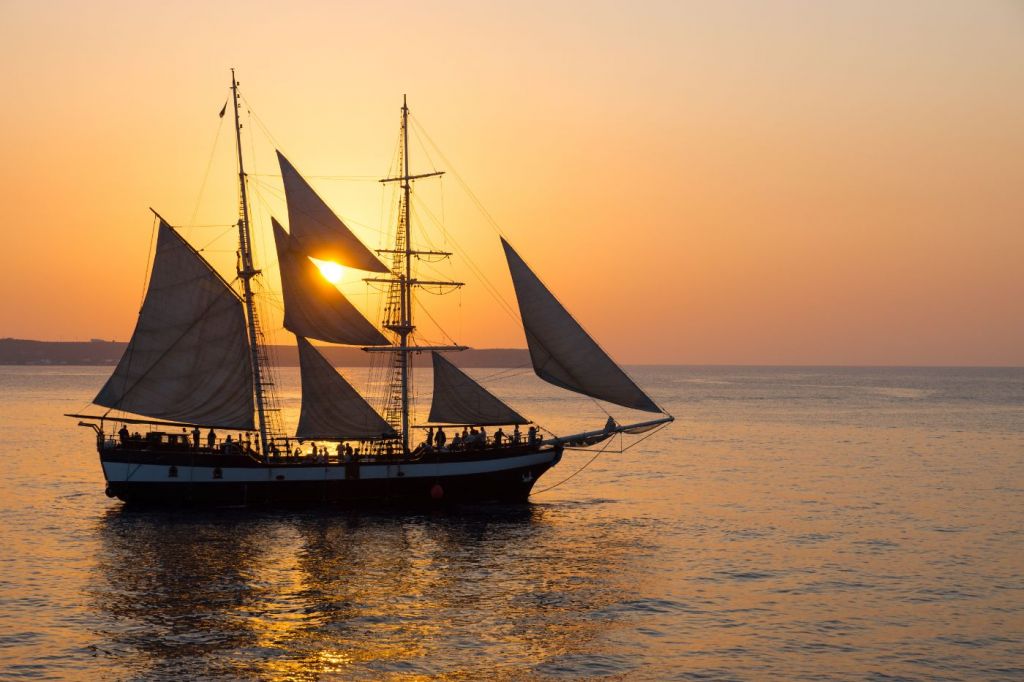
On this page:
How to recognize each sailboat, famous two-masted sailboats.
Below are the five most common types of two-masted sailboats and how you can quickly identify each:
| One mast in the front and one in the back | |
| One mast in the front and one in the back, with the mainmast in the back | |
| One mast in the front and one in the back, with the mizzenmast in the back | |
| Two mast masts, with the foremast being the taller of the two | |
| One mast in the front and one in the back, with square sails on the front mast and fore-and-aft sails on the back mast |
In a two-masted sailboat, the mainmast usually carries the driving sail, which is responsible for propelling the boat forward. Meanwhile, the mizzenmast usually carries the balancing sail, which helps to balance the boat and keep it stable in different wind conditions.
Some sailboats are designed for speed, while others prioritize maneuverability and ease of handling. If you're looking for a sailboat that is comfortable and easy to handle, a ketch or yawl might be a good choice. These sailboats are generally more stable and easier to handle than other types of sailboats.
If you're looking for a sailboat that is fast and maneuverable, a brigantine or schooner might be a good choice . These sailboats are generally more difficult to handle than other types of sailboats, but they offer a thrilling sailing experience.
You can read more on two-masted sailboats in this article.

How to recognize a ketch:
- a medium-sized sailboat (30 ft and up) with two masts
- a smaller mast in back
- a taller mast in front
- both masts have mainsails
- sails are fore-and-aft rigged
Sail design of a ketch
A ketch has two masts, with a taller mizzenmast located more towards the middle of the boat and behind the main mast. You can identify a ketch through this article.
The sail design of a ketch allows for more sail area options and versatility in different wind conditions.
The two masts allow for a variety of sail configurations that can be adjusted depending on the wind conditions, making the ketch more versatile and adaptable in different sailing conditions.
Performance and maneuverability of a ketch
A ketch can be efficient and fast, especially when sailing downwind, due to the mizzen mast helping to balance the boat and reduce load on the main sail. The smaller size of the mizzen sail can be useful in strong winds, providing a smaller area of sail to catch the wind.
Maneuvering a ketch can be challenging due to more lines and rigging, but skilled sailors can learn to handle it with practice.
Rigging configuration of a ketch
The rigging configuration of a ketch allows for more control over sail trim and balance, with the main sail attached to the main mast and the smaller mizzen sail attached to the mizzen mast. The sails can be adjusted independently of each other, allowing for versatility in different sailing conditions. The mizzen sail can be used to balance the boat and keep it on course in light winds, or reduce the load on the main sail in stronger winds.
The ketch rig also allows for finer control over the shape of the sails, with the mizzen sail used to adjust the angle of attack of the main sail and balance the boat when sailing close to the wind.

How to recognize a schooner:
- a sailboat with mostly two masts
- a smaller mast in front
- a taller mast in the back
- mainsails have gaff-rigging (spar on top of the sail)
Sail design of a schooner
A schooner is a two-masted sailboat with the mainmast taller than the foremast, and triangular-shaped sails. The sails on the forward mast are smaller than those on the aft mast. Here's how to recognize a schooner .
Schooners can be sailed with a smaller crew due to the ease of adjusting the sails, and are often used for racing due to their speed and agility.
Schooners can also be used for cruising, but are less maneuverable than yawls and ketches due to their size.
Performance and maneuverability of a schooner
A schooner can be fast, especially in light winds, and its rigging configuration allows it to sail close to the wind, making it a good choice for long-distance cruising.
Schooners can cover a lot of ground quickly due to their ability to sail at a greater angle to the wind than some other types of sailboats.
Maneuvering a schooner can be relatively easy with a skilled crew, as the sails can be adjusted quickly and easily, allowing for easier turning and maneuvering than some other types of sailboats.
Rigging configuration of a schooner
The rigging configuration of a schooner allows for a greater variety of sail configurations due to the two masts and different sizes of the sails on each mast. This allows for versatility in different wind conditions, with the sails set up in different ways to catch more wind or provide more power.
Schooners can sail faster and more efficiently in light winds due to the ability to adjust the sails on each mast. In stronger winds, the sails can be adjusted to reduce sail area and prevent the boat from being overpowered, through reefing or changing the sail configuration.

How to recognize a yawl:
- a sailboat with two masts
- a main mast in front
- a much smaller mast in the back
- back mast doesn't carry a mainsail
Sail design of a yawl
A yawl is a two-masted sailboat with a shorter mizzenmast located behind the mainmast, usually behind the rudder post. The smaller mizzen sail on the aft mast can be used to balance the boat and provide additional power in light winds, while the larger mainsail on the main mast can be used for more power in stronger winds.
The advantage of a yawl is that it allows for more flexibility in sail handling.
Performance and maneuverability of a yawl
A yawl can be slower than other types of sailboats due to the additional weight of the second mast and rigging, but can be more stable and easier to handle in rough seas.
Yawls are a popular choice for cruising and long-distance sailing due to their stability.
Yawls can be easily maneuvered even with a small but skilled crew, making them suitable for cruising.
Rigging configuration of a yawl
The rigging configuration of a yawl provides several advantages, including:
- Balance : The smaller mizzen sail on the aft mast helps to balance the boat and reduce weather helm (the tendency of the boat to turn into the wind). This makes the boat easier to steer and more comfortable to sail.
- Flexibility : The smaller mizzen sail can be used to help control the boat in a variety of wind conditions, while the larger mainsail on the main mast provides more power in stronger winds.
- Safety : The mizzen sail on the aft mast can be used as a backup sail in case the main sail on the main mast is damaged or needs to be taken down. This provides an added level of safety and security when sailing offshore or in rough conditions.
- Ease of handling : The smaller mizzen sail on the aft mast can be used to help turn the boat quickly and with more control, making it easier to navigate in tight spaces or tricky conditions.
| One in the front and one in the back | Main and mizzen sails | Fore-and-aft rigged mizzenmast, sometimes with a gaff-rigged sail | |
| One in the front and one in the back, with the mainmast in the back | Main and fore sails | Fore-and-aft rigged masts, sometimes with gaff-rigged sails | |
| One in the front and one in the back, with the mizzenmast in the back | Main and mizzen sails | Fore-and-aft rigged mizzenmast, sometimes with a gaff-rigged sail | |
| Two masts, with the foremast being the taller of the two | Square sails on the foremast, fore-and-aft sails on the mainmast | Square-rigged foremast, fore-and-aft rigged mainmast | |
| One in the front and one in the back, with square sails on the front mast and fore-and-aft sails on the back mast | Square sails on the foremast, fore-and-aft sails on the mainmast | Square-rigged foremast, fore-and-aft rigged mainmast |

How to recognize a brig:
- a square-rigged foremast
- a mainmast that is either square-rigged or square-rigged and gaff-rigged
Sail design of a brig
A brig is a two-masted sailboat with square sails on both masts. The square sails are used to generate driving force when sailing downwind and are typically made of heavy canvas or durable materials. The sails are attached to the masts and yards using a series of ropes and lines known as the rigging.
The square sails on a brig are divided into smaller sections known as "panels," which can be adjusted individually to suit changing wind conditions.
Brig may also have one or more triangular-shaped fore-and-aft sails attached to the foremast, which can be adjusted using running rigging. Here's how to identify a brig.
Performance and maneuverability of a brig
The square-rigged sails of a brig allow it to sail closer to the wind than other types of sailing vessels, making it easier to maneuver in tight spaces and change direction quickly. This makes a brig ideal for naval warfare and piracy, where speed and maneuverability are essential for success.
The design of a brig allows for a smaller crew than other types of ships of similar size, which can make it easier to operate and maintain. Fewer crew members also means less weight and less space taken up by supplies and equipment, contributing to the ship's speed and maneuverability.
Rigging configuration of a brig
The rigging configuration of a brig typically includes square sails on both masts, which provide significant driving force when sailing downwind. However, this type of rig can be less effective when sailing upwind, as the sails are not as efficient at generating lift as a triangular sail.
One advantage of the brig's rigging configuration is that the square sails can be adjusted individually to suit changing wind conditions. The fore-and-aft sails can be used to fine-tune the vessel's speed and direction.
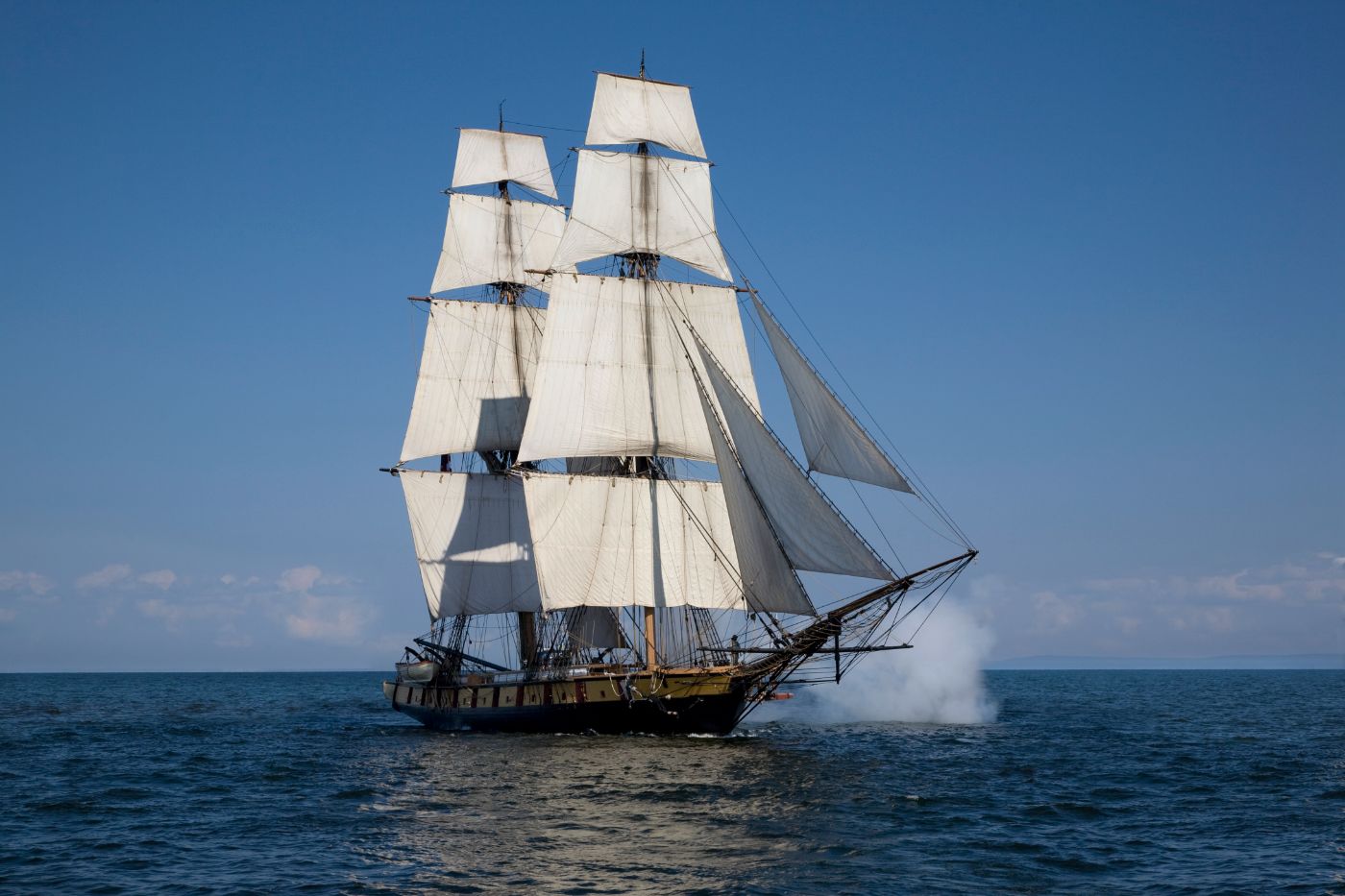
How to recognize a brigantine:
- a two-masted sailboat that is similar to a brig, but with a different rigging configuration
- a sailboat with a square-rigged foremast and a fore-and-aft rigged mainmast
- mainmast is typically taller than the foremast
- sails on the mainmast are fore-and-aft rigged, while the sails on the foremast are square-rigged
Sail design of a brigantine
A brigantine is a two-masted sailboat with square sails on the foremast and fore-and-aft sails on the mainmast. This configuration allows for a greater range of sail plan options. The square sails on the foremast can be used to drive the ship forward in strong winds, while the fore-and-aft sails on the mainmast can be used to maneuver the ship in more moderate winds.
Brigantines were used as cargo ships in the past and are still used for training and educational purposes.
Rigging configuration of a brigantine
The rigging configuration of a brigantine is complex, with multiple lines and cables used to control the sails and masts. The foremast typically has a topmast and a topgallant mast, while the mainmast may have a gaff and a boom to support the fore-and-aft sails. The rigging system includes shrouds, stays, and other lines that help stabilize the masts and sails and control their movement.
Performance and maneuverability of a brigantine
The combination of square and fore-and-aft sails allows for a greater range of sail plan options, which can help the ship maintain speed and maneuverability in different wind conditions.
However, the larger size and weight of the brigantine can make it more difficult to maneuver quickly or make sudden changes in direction, particularly in light winds.
For a better grasp of what each of these two-masted boats looks like , this article contains complete illustrations and pictures.
Here are some of the most popular two-masted sailboats that you might know:
| Yawl | 2 | Forward | Mainmast is taller than the mizzenmast | |
| Ketch | 2 | Forward | Mainmast is taller than the mizzenmast | |
| Ketch | 2 | Forward | Mainmast is taller than the mizzenmast | |
| Schooner | 2 | Forward | Foremast is taller than the mainmast |
The sloop-rigged Hinckley Bermuda 40
The Hinckley Bermuda 40 is a classic sailboat that has been around since the 1960s. This boat is known for its beautiful lines, excellent handling, and comfortable interior.
The Bermuda 40 is a yawl-rigged sailboat, which means it has two masts, a mainmast, and a smaller mast called a mizzenmast. The mainmast is located forward, while the mizzenmast is aft. This arrangement allows for better balance and maneuverability, especially in heavy weather.
The ketch-rigged Amel Super Maramu
The Amel Super Maramu is a luxurious sailboat that is designed for long-distance cruising. This boat is known for its innovative features, such as an electric furling system, a hydraulic bow thruster, and a self-tacking jib.
The Super Maramu is a ketch-rigged sailboat, which means it has two masts, a taller mainmast, and a shorter mizzenmast. The mainmast is located forward, while the mizzenmast is aft. This configuration allows for better sail balance, especially when sailing downwind.
The ketch-rigged Westsail 42
The ketch-rigged Westsail 42 is a popular cruising sailboat that was designed by William Crealock in the 1970s. This boat is known for its sturdy construction and seaworthiness, making it a popular choice for long-distance cruising.
The ketch rig is known for being versatile and easy to handle, as it allows for a variety of sail combinations to be used depending on the wind conditions. It also allows for a versatile sail plan that can be easily adjusted to suit a wide range of wind conditions.
The schooner-rigged Bluenose II
The schooner-rigged Bluenose II is a replica of the original Bluenose, a famous Canadian racing schooner. The Bluenose II was built in 1963 and is used primarily as a tourist attraction and sail training vessel.
The schooner rig features two masts, with the forward mast being taller than the aft mast. This rig allows for a large sail area and a high degree of maneuverability, making it well-suited for racing and coastal cruising.
Leave a comment
You may also like, how much does a sailboat mast replacement cost.
Now I won't ask why you are researching mast replacement - the story behind it is probably tragic and I don't wanna cry as I do whenever I see an injured sailboat. …

Guide to Understanding Sail Rig Types (with Pictures)

The Ultimate Guide to Sail Types and Rigs (with Pictures)

17 Sailboat Types Explained: How To Recognize Them
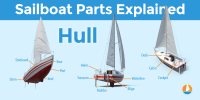
Sailboat Parts Explained: Illustrated Guide (with Diagrams)

What’s a Boat with Two Masts Called: Two masted sailing boat types
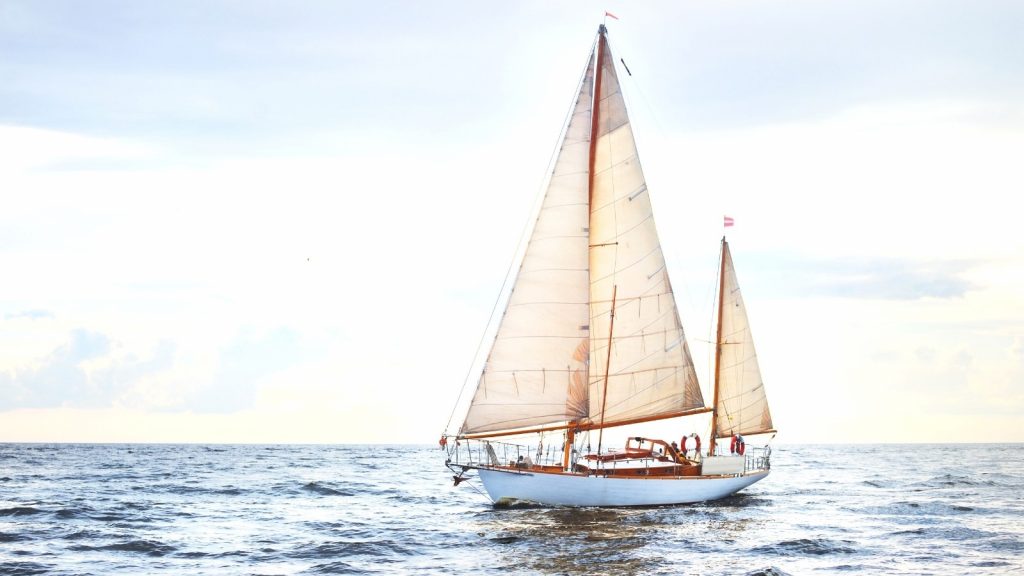
Two-masted sailing boats will always have a special place in the hearts of many sailors. Many sailors consider two-masted sailing boats to be the most attractive and graceful of all sailing vessels. They have an obvious elegance, but what do you know about these two masted sailboats? Let’s find out!
Among the most important aspects are the fact that two-masted sailing boats offer greater sail balance, engineless sailing and more heavy weather options.
Even if the two masted sailboats are not so common, the sailing world has a few of them and what is more, they represent a proof of the evolution and improvement of sailing boats over time. There are an almost endless number of ways sailors have arranged their sails on boats over the years.

Two-masted sailing boats are classified according to the size and position of their masts.
There are different two-masted sailing boat types and two of the most popular are schooners and yawls.
The origins of schooner-rigged vessels are unknown, however there is evidence of them in paintings by Dutch maritime painters dating back to the early 17th century.
Schooners were developed by Northern European countries, while yawls are believed to be descended from the fishing boats of England.
Sailboats with two masts include yawls, ketches, schooners and brigs (known as brigantines). Yawls and ketches are both types of sloops, which means they have one mast, but the difference between them is that the yawl has a second mast stepped at the bow.
Ketches and Yawls have a lower mast, unlike schooners that have a taller aft mast, which is also known as mizzen. Ketch sailing boats have something specific: the aft mast is located in front of the rudder post.
The yawl’s mizzenmast serves as a counterbalance for the jib sails, so that it doesn’t have to be hung from the forestay (the rope running from the top of the mast down to the deck). They’re usually smaller than ketches and have less rigging because they don’t carry as many sails as a sloop with two masts.
Yawls are faster sailboats than schooners because they’re lighter, more balanced and easier to sail upwind. They can also go faster because their shorter sails catch more wind. But schooners have larger payloads, which means more people or cargo — an important consideration for long trips without resupply.

Schooners are two-masted sailing boats, but instead of having a jib sail like yawls, ketches and most sloops, schooners have a fore-and-aft spanker sail like a gaff sailboat. These two-masted sailboats have at least two masts, the foremast being slightly shorter than the main mast.
Schooners are larger than yawls, ketches and other sloops and weren’t used very much in modern times because they were more difficult to handle. They’re still used in racing competitions today.
Schooners have a longer bow portion than yawls. The mainsail is aft of the mast, and either one or two foresails are in front of it. In a schooner, these are triangular sails; in a yawl, they’re trapezoidal. Yawls have bowsprits — poles that extend beyond the bow for the jib and stay sail to be attached. Schooners have small bowsprits that can support jibs but not large sails.

The term ketch derives from the word catch, which hints to how it got its name in the 17th century. Ketches were initially intended to meet the specific requirements of offshore net fishing.
Ketch is a type of sailboat that features two masts and two sails, commonly used as a racing and cruising boat. The mainmast of this two-masted sailboat is typically taller than the mizzen mast (aft-mast). Its name derives from catch.
Taller masts allow you to use larger sails, so ketch boats are able to achieve better speeds than similar boats with only one mast. Some ketch designs feature a gaff rig, which is similar to a yawl, while others feature a yawl rig, which looks like a traditional sloop.
Ketch boats may look easy to sail but the slightest mistake can lead to disaster. You must be careful when operating this type of boat because it does not have as much stability as other boats, especially when you’re manoeuvring in tight quarters or windy conditions.
A ketch may also be a small recreational boat with only one head-sail in use. Many modern designs have moved away from sail altogether and are powered by engine, while others use both sails as well as engines depending on circumstance.

The brigantine was once a tiny ship that carried both oars and sails. It was a favorite of Mediterranean pirates.
A brigantine is a square-rigged sailing boat with two masts, with a fully square-rigged foremast and two sails on the mainmast.
The mainmast is stepped forward of the deck, making it possible to sail into the wind using a triangular headsail known as a jib. The brig’s foremast is shorter than the mainmast.
The name of this type of boat with 2 masts is derived from the Italian word “brigantino”, which means brigand.
Also, this two-masted sailing boat type was most commonly used for coastal trade and pirate hunting. The brigantine had an advantage over other ships of the time because it could sail against the wind using both sails, making it easier to travel against strong winds.
Faster and easier to manoeuvre than a sloop or schooner, it was used for piracy and espionage.

FAQ: Two-Masted Sailboats
What do you call a two-masted sailboat.
Two-masted sailboats are of several types: yawls, schooners, ketches or brigantines.
Why do some sailboats have two masts?
The vast majority of sailboats feature a mainsail and a jib. These two-masted sailboats provide several advantages in terms of speed and maneuverability. These two masts may be configured in a variety of ways.
The foresail directs air beyond the back of the mainsail, generating greater power from the wind. In order to help menouvering, the foresail can be backed. So, adding sails makes things simpler for bigger boats, making them easier to handle in heavy winds.
What is the difference between a ketch and a yawl sailboat?
Because they are lighter, more balanced, and easier to sail upwind, yawls are faster sailboats than schooners. They can also go at a faster speed since their shorter sails collect more wind. Schooners, on the other hand, have higher cargoes, which means more people or freight – a crucial consideration for extended journeys without replenishing.
What is a one masted sailboat?
It's a sailing boat having a single mast roughly one-third the length's aft of the bow. A sailboat with a single mast usually has one headsail in front of the mast and one mainsail behind the mast.
What is a two-masted square rigger?
It's a brig with two square-rigged masts. A gaff-rigged fore-and-aft sail also called a "mizzen" is used in addition to jibs and staysails (stays'ls) before the foremast and staysails between the masts.
Leave a Comment Cancel Reply
Your email address will not be published. Required fields are marked *

24′ Double-ended voyager CAROL
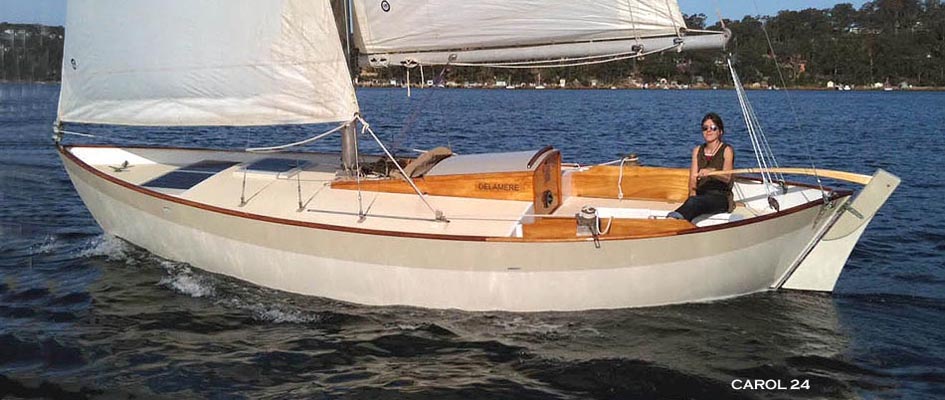
QUEEN BEE was built in Sydney, Australia.
FOR A VIDEO that shows the CAROL’s sailing qualities, click here:
| Dimensions | |
|---|---|
| LOA | 24′ 4″ |
| LWL | 20′ |
| BEAM | 7′ 11.5″ |
| DRAFT | 3′ 6″ |
| DISPLACEMENT half load | 5,709 lbs |
| BALLAST (LEAD) | 2,700 lbs |
| SAIL AREA (100% foretriangle) | 324 sq ft |
| D/L RATIO | 319 |
| SA/DISP RATIO | 18.0 |
CAROL is in many ways my favorite pocket cruiser— a scaled-down and flatter-deadrise version of my popular FRANCES . She evokes an adventurous spirit that prevailed in the happy times of the late ‘70s when I designed her. At 24 feet she’s as small as a prudent sailor would ever think of taking to sea. CAROL is the ultimate in making do with less. Her hull is stable and easily driven, and her rig is simple and powerful. She can sail close to her hull speed of six knots when conditions are favorable, making for good sailing in moderate conditions. While no boat of this size can truthfully be termed comfortable in the open ocean, CAROL ‘s crew are at least free of great concern for her safety, or their own. With her small self draining cockpit well, raised deck, centerline hatches and strong self-righting tendency she is as seaworthy as the proverbial corked bottle. Her clear decks make it easy to handle her gear, and the recessed deck forward offers the crew security where it is needed most.
I designed CAROL in 1979 and something like twenty have been built so far all over the world. Thanks to her beautifully crafted building plans, anyone willing to work hard and with good carpentry skills can aspire to sailing over the horizon in something of high intrinsic value that they built themselves. With her very high quality of specified construction and perfected double-ender aesthetics she is a true legacy yacht, whose appeal will endure for generations. She’s neither easy nor cheap to build, though— fair warning.
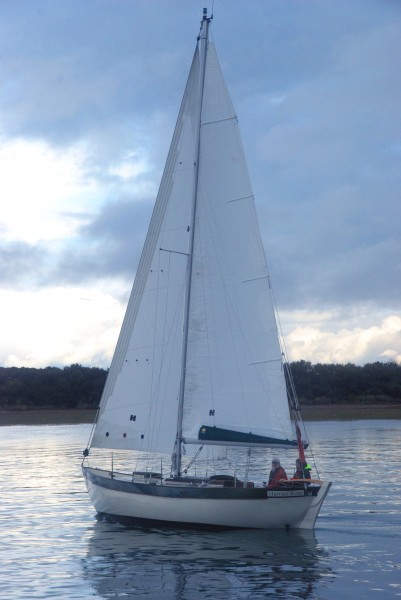
HARRIET ROSE sails out of Chichester, UK.
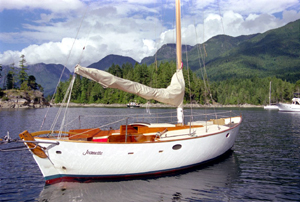
JEANNETTE was built near Victoria, BC. Now she sails on Monterey Bay, CA.
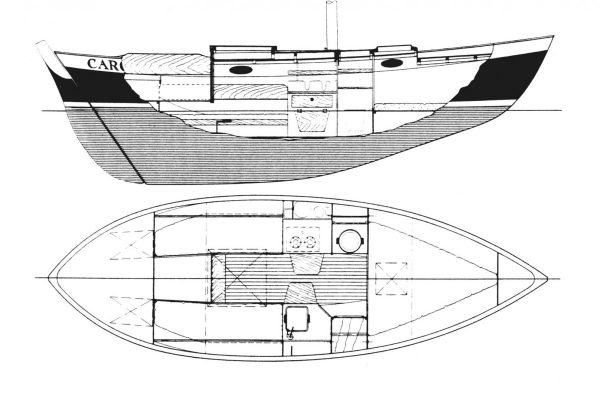
The interior arrangement is intended for two persons. They may share the double berth forward in harbor, or the off-watch partner can choose the leeward quarter berth when at sea. There is just the minimum sitting headroom in this design― indeed this was the pivotal factor that determined the overall size of this minimalist yacht. The design provides a place for the cook to sit, and a toilet to avoid having to go on deck for this necessity. A sea hood fitted over the companionway provides a place to stand up for pulling on one’s pants, at least when the weather permits you to open the hatch.
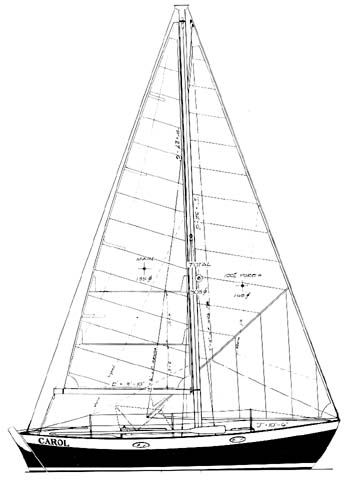
CAROL as originally designed had no auxiliary power, a pair of oars being shown for getting her home in a calm or maneuvering through a quiet anchorage. Quite a few have been fitted with small diesels, though, an idea that can be life-saving in difficult conditions and a lot easier than rowing when the wind fails.
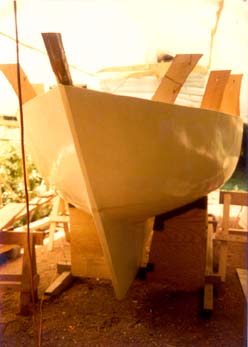
A CAROL hull under construction.

You laminate the cold- molded hull upside down. The deadwood is added once it is finished.
CAROL is narrow enough to trailer legally over the road in the USA, though at her weight she requires a lift or railway to haul and launch and a crane to step her mast. She was engineered to be built in WEST system cold-molded construction. She was designed in the hippie years, with many young people seeing the wonders of the world living in a tent. Quite a few more, who thought it fun, bought books on WEST system construction and saw the wonders of the sea living in a CAROL. You could too!
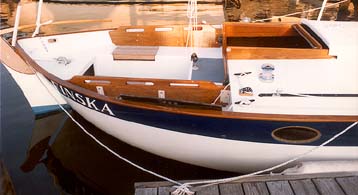
Note the varnished seatbacks, which make the cockpit very comfortable.
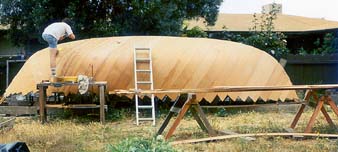
There’s lots of laminating to do.
Many variations have been built. JUNO LUCINA hails from the UK, and has been fitted with a small trunk cabin.
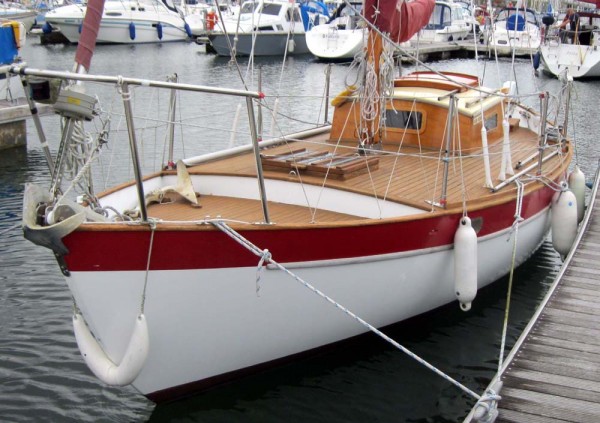
Bee fits very nicely into the cabin of her eponymously named yacht.
This design is featured in both of my recent books; MY YACHT DESIGNS and the Lessons they taught me, and THE BOATS I’VE LOVED— 20 Classic Sailboat Designs by Chuck Paine. Both are beautiful, full colored, first class books which give you lots more information on this design, and can be purchased on this website.
Study plans are available emailed to you in pdf format for US$ 25.00, Full printed plans including a full-size mylar hull lofting and right to build for US$ 3000.00
PDF Study Plans: $25
no shipping, sent via email
Further information may be obtained from:
CHUCKPAINE.COM LLC P. O. Box 114
Tenants Harbor, Maine 04860-0114 [email protected]
- BOAT OF THE YEAR
- Newsletters
- Sailboat Reviews
- Boating Safety
- Sails and Rigging
- Maintenance
- Sailing Totem
- Sailor & Galley
- Living Aboard
- Destinations
- Gear & Electronics
- Charter Resources
- Ultimate Boating Giveaway

10 Best Used Cruising Sailboats
- By John Kretschmer
- Updated: May 24, 2024
The appeal of offshore voyaging is difficult to explain to land people who can’t imagine life without basic human rights like copious quantities of hot water and unlimited data. It can even be challenging to explain to fellow sailors who think the notion of spending days or weeks at sea is a form of waterboarding, some kind of self-inflicted torture.
But for those of us who understand, who relish intimacy with the untamed wilderness that is the ocean and embrace self-reliance and individual expression while accepting the dispassionate whims of Neptune, this is the good life.
There are two essential truths about this life: One, money does not matter. Cruising budgets and lifestyles reflect bank accounts with variously positioned commas; it’s the passages and landfalls that add up, not your investment portfolio. And two, a good bluewater sailboat — not necessarily an expensive boat, but a well-designed, solidly built, imminently seaworthy boat that is only limited by your moxie and imagination — is the key to successful bluewater passagemaking.
– LEARN THE NAVIGATION RULES – Know the “Rules of the Road” that govern all boat traffic. Be courteous and never assume other boaters can see you. Safety Tip Provided by the U.S. Coast Guard
So, to that second point, I’ve compiled a list of interesting and affordable cruising sailboats for serious voyaging. A list of 10 sailboats for any purpose, much less world cruising, is sure to evoke outrage from strong-minded sailors, who by nature tend to be a bit opinionated. Stand by before hurling insults my way, and let me explain. I have decided to stay away from the sailboats we know by heart, the iconic old boats that usually populate a list like this: the Westsail 32, Tayana 37, Shannon 38 and Valiant 40 (the last of which, with a bit of searching, can still be found at or just below $100,000).
My list of some of the best liveaboard sailboats is eclectic and includes a mix of well-known and obscure manufacturers, but all the boats are linked in three ways: All are top-quality vessels capable of crossing oceans. They’re affordable, although in a few cases you have to look for older models in less-than-stellar condition to stay below $100,000. Indeed, in some ways, this list of used sailboats is a function of age; most of the boats were priced at more than $100,000 when new but have dipped below our self-imposed threshold in middle age. And finally, they’re all boats that I have encountered in the past few years in far-flung cruising destinations .
Island Packet 35
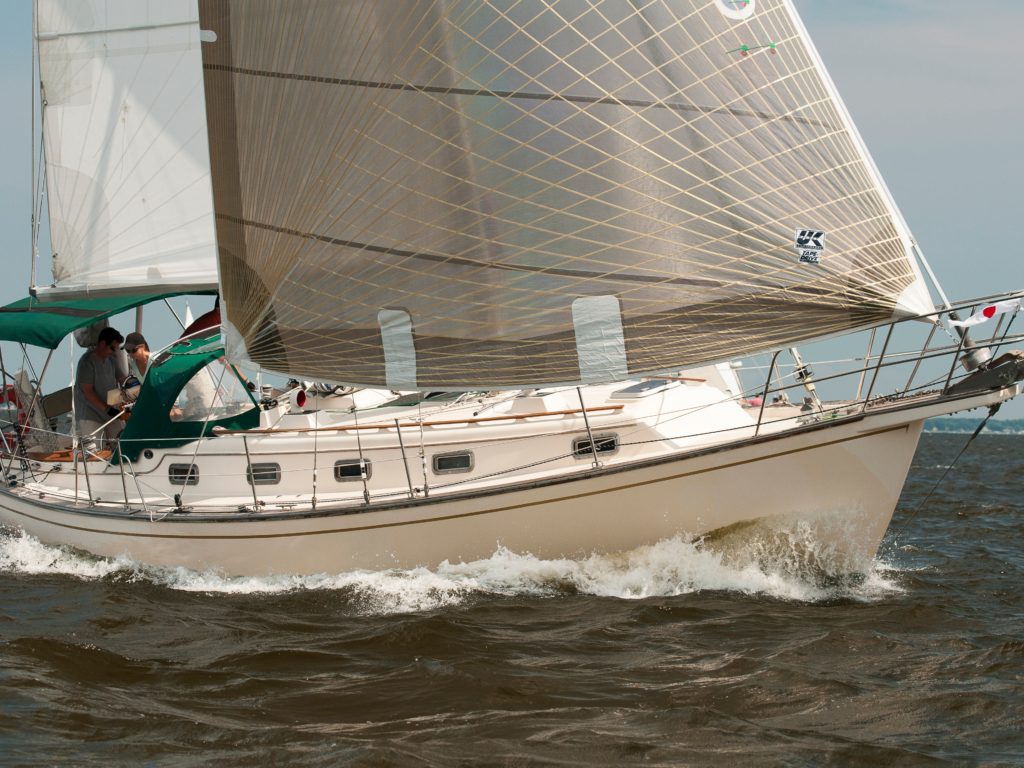
Love them or loathe them, Island Packets are everywhere. To some, the beamy, full-keel, high-freeboard hull designs seem quaint, to put it charitably. To others, the robust construction standards, roomy interiors and overall user-friendliness make them the ideal cruising boat. More than most, sailing vessels are compromises, and Bob Johnson and his crew at Island Packet were brilliant in prioritizing the needs of sailors. The IP 35 was introduced in 1988 and features a huge cockpit, an easy-to-handle cutter rig with a jib boom, and a clever, comfortable interior with the volume of many 40-footers. It might not be the fastest boat upwind, but the long waterline translates to good performance off the breeze, meaning the IP 35 finds its stride in the trade winds. In all, 188 boats were built before production stopped in 1994.
Don’t confuse the IP 35 with the IP 350, which was launched in 1997 and included a stern swim step. You won’t find a 350 for less than $100,000, but you will have a choice among 35s, especially those built before 1990. With two nice staterooms, the 35 is ideal for family cruising. I know of a couple of 35s that have completed the classic Atlantic Circle passage. It’s perfect for a sabbatical cruise because it holds its value and there’s a ready market when it comes time to sell.
Prout Snowgoose 37
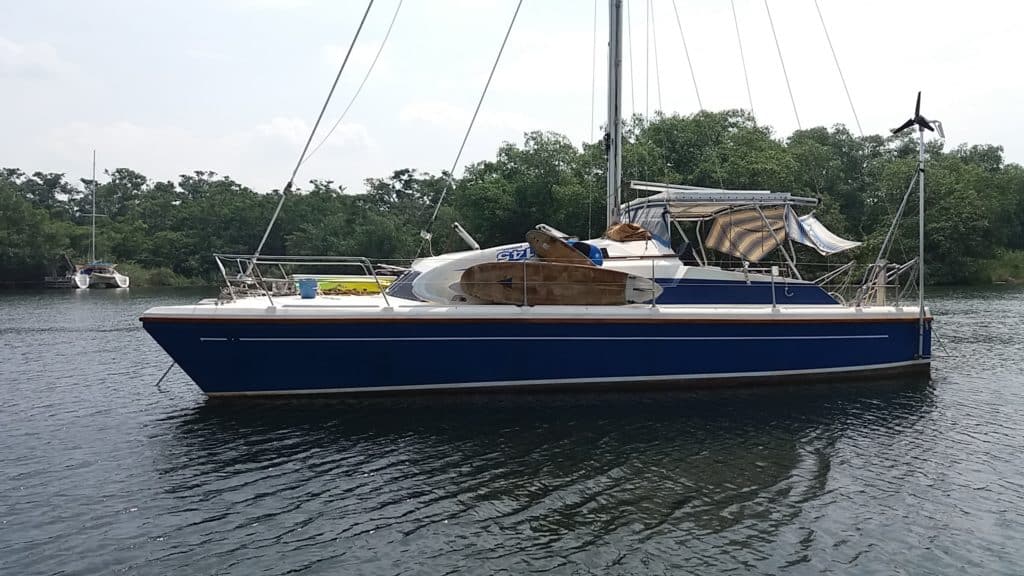
There’s no room for discussion: Catamarans are crossing oceans, and many sailors are choosing cats for world cruising. My last visits to the Azores and Canary Islands, the classic Atlantic waypoints, proved the point. I’m not much of a statistician, but by my count, at least a quarter and maybe a third of the boats I saw were catamarans. There would be more on this list, but they are just too expensive. Finding a quality catamaran for less than $100,000 is tough. One boat to consider is the classic workhorse multihull, the Prout Snowgoose 37.
When the Snowgoose 37 was launched in 1983, English builder Prout & Sons had already been in business for nearly 50 years. The 37 was an updated version of the Snowgoose 35, one of the most successful cruising cats ever. In 1986, the 37 was updated again; the Snowgoose Elite model included more beam and interior upgrades. These models are challenging to find for under $100,000, but it’s possible. A quick glance at yachtworld.com shows several of both models available for less than $100,000. Again, the strong dollar makes European boats an excellent value.
The Snowgoose 37 is not sexy like go-fast cats, and not roomy like modern cruising cats. It is, however, seaworthy. Of the 500 built, many have circumnavigated. Older boats have solid fiberglass hulls, and more recent models are solid glass from the waterline down and cored above. The cockpit is rather compact by catamaran standards, and the bridgedeck is solid (no tramp). Many 37s and all Elites were rigged with staysails, a big plus in heavy weather. The masthead-rigged Snowgoose 37 can be sailed like a monohull offshore, and it’s quite nice not having a huge, roachy mainsail to wrestle with in a storm. With a 15-foot-3-inch beam for the 37 and a 16-foot-3-inch beam for the Elite, it’s easy to find affordable dockage and yards for haulouts. Most boats have three double cabins, making the Snowgoose 37 an ideal family cruiser.
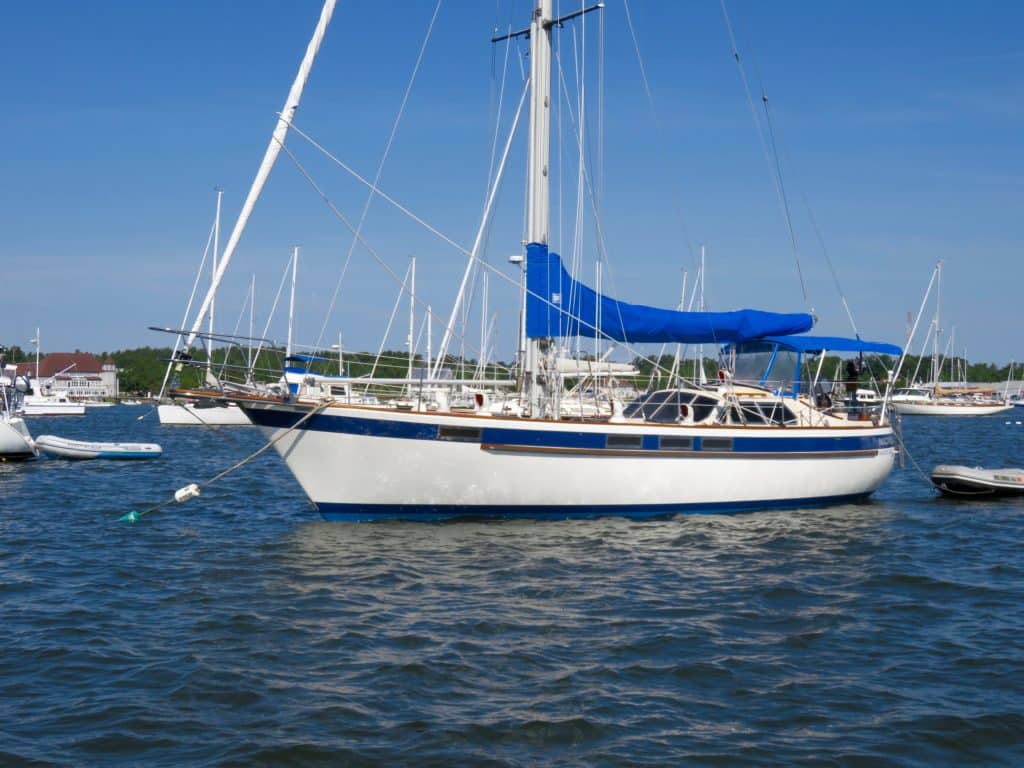
The Corbin 39 is not as well known as it should be. It’s a capable bluewater sailboat cruiser with many impressive voyages logged. My Quetzal spent several weeks moored alongside a handsome 39 in Corfu that had sailed around the world, and I also spent a winter in Malta in the same boatyard as another 39 that had recently crossed the Atlantic. A canoe-stern, flush-deck pilothouse cutter, the 39 was offered with either an aft or center cockpit. Designed by Michael Dufour and constructed by Corbin les Bateaux in Canada, hull number one was launched in 1977. Built in various locations in Quebec, 129 boats were launched before a fire destroyed the deck tooling in 1982. A new deck with a larger cockpit was designed, and 70 more boats were laid up before production ceased in 1990.
The rub on the Corbin 39 is that the majority of boats were sold as kits with owner-finished interiors. Kits varied from just hull-and-deck to “sailaway,” with everything fitted except the interior. Only 15 boats were finished at the factory. Not surprisingly, the interior quality is unpredictable, from rough-hewn lumberyard specials to beautifully handcrafted gems finished by marine professionals. The difference is reflected in the price. A nicely finished, well-equipped model from the mid-’80s typically sells for between $60,000 and $80,000.
The hull shape features a long fin keel and skeg-mounted rudder. The hulls are heavily laid up and include Airex coring. Early decks were plywood-cored, but most boats have Airex in the deck as well. Ballast is 9,000 pounds of internal lead, translating to a 40 percent ballast-to-displacement ratio. The wide flush deck is spacious, and the sleek pilothouse usually includes inside steering. Massive double anchor rollers are incorporated into the bowsprit in later models. Most boats include a double-spreader spar, and almost all were set up as cutters. There’s plenty of freeboard, which becomes obvious below. While interior arrangements vary considerably, there’s a lot of room to work with. I prefer the post-1982 aft-cockpit 39s; they’re generally of a higher quality than earlier boats.
– CARRY A BEACON – Satellite beacons such as EPIRBs or PLBs allow boaters to transmit distress signals and their exact coordinates from anywhere on the planet, no cell service required. It may be the best $400 you ever spend. Safety Tip Provided by the U.S. Coast Guard
Cabo Rico 38
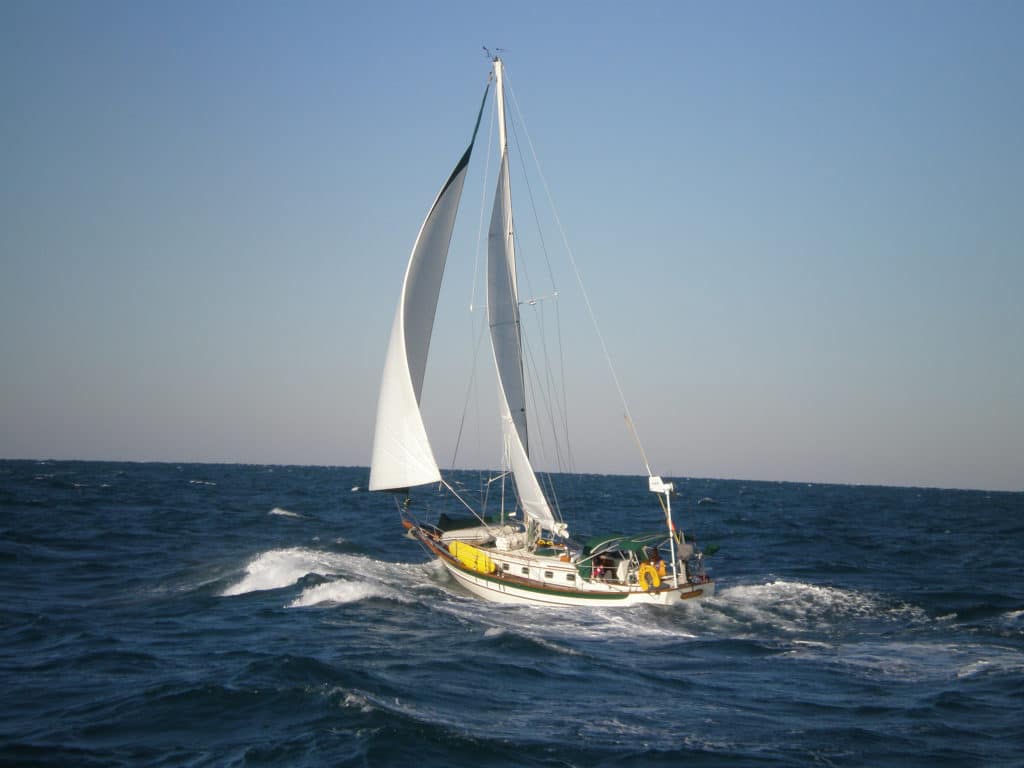
“The Cabo Rico 38 hull shape is the one in which everything came together best,” wrote Bill Crealock in his design notes. He might have changed his mind later in life, considering that the Cabo Rico was introduced in 1977 and he designed many boats after that, but few will dispute that this 38-foot cutter, built in Costa Rica, is flat-out beautiful. From the clipper bow to the sweet sheer to the abundance of honey-colored teak, the Cabo Rico 38 is a boat to inspire the most practical among us to quit their job, buy this vessel, and head for the South Pacific.
Not surprisingly, many people have done just that. Cabo Rico built 200 full-keeled 38s, with most of the production occurring in the 1980s. There’s always a selection of boats for sale for less than $100,000. Cabo Rico was an outlier among manufacturers of the time, building serious cruising boats in Central America instead of Taiwan, but quality control was always excellent. The full keel is slightly cutaway, and the rudder is attached to the trailing edge. The prop is in an aperture and totally protected, but not well suited to backing into a slip. Full-keel boats may make some younger sailors cringe, but the CR 38 has a very soft ride in rough seas and heaves to effectively. It also has a solid fiberglass hull with a layer of balsa for insulation. Sometimes it’s noted that the hull is balsa-cored, but it’s not. After about hull number 40, lead was used instead of iron for internal ballast. The deck is balsa-cored, however, and there’s a substantial bulwark. Items to be wary of are the teak decks (most 38s have them) and the fittings supporting the bobstay.
A true cutter rig, the 38 has just under 1,000 square feet of working sail area and performs better than most people suspect. The staysail was originally set on a boom that cluttered the foredeck and limited sail shape. Many boats have been converted with furling staysails sans the boom — a nice upgrade. When the wind pipes up, the 38 tracks nicely with a reefed main and staysail. I encounter 38s all over the Caribbean. They’re easy to spot; they’re the beautiful boats in the anchorage.
Tayana Vancouver 42
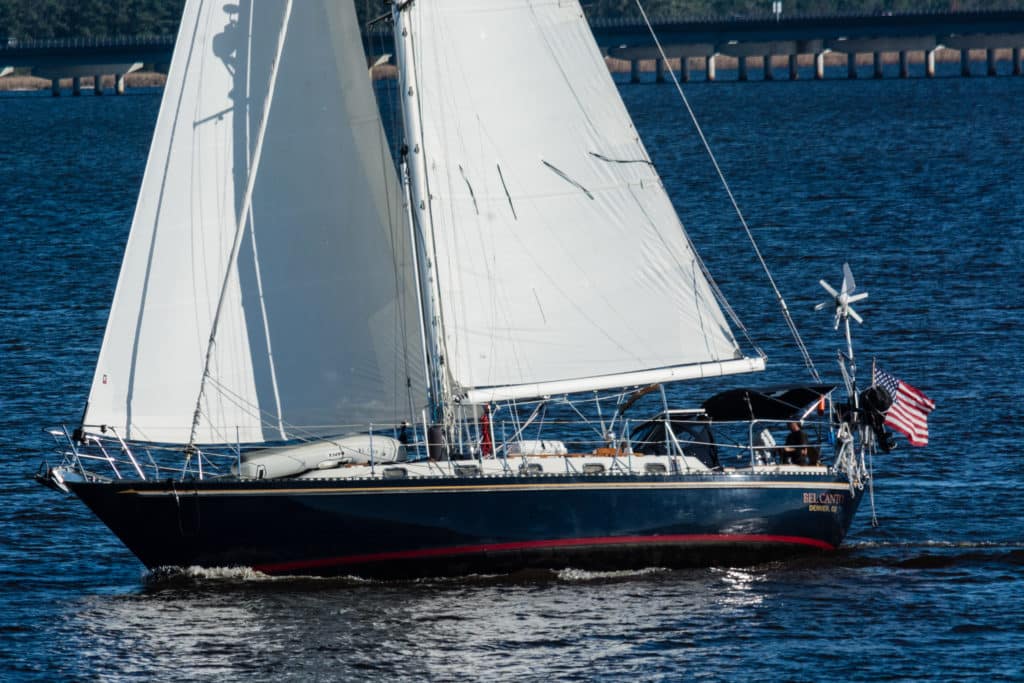
Ta Yang, builder of Tayana sailboats, has been building capable cruising boats forever, it seems. The Robert Harris-designed Tayana Vancouver 42 has been a mainstay of the serious cruising fleet since the day it was launched in 1979, and is still in demand today. The company built 200 boats, mostly in the ’80s and early ’90s, although a few V42s were built into the 2000s. With a bit of digging and some haggling, you can find boats for less than $100,000, but they’re likely to be older models. As of this writing, yachtworld.com has eight V42s listed, with three asking less than $100,000.
I’ve encountered the V42 all over the world, and in my yacht-delivery days, I had the pleasure of delivering a couple of 42s up the East Coast and down to the Caribbean. The double-ended hull shape with a fin-skeg underbody is stiff and seaworthy, if not wickedly fast. Considering the rugged construction, with a solid fiberglass hull and balsa-cored deck, nobody has ever accused Ta Yang of going light on its boats. Ballast is internal iron, a massive single casting that weighs in at 11,800 pounds. Ta Yang has evolved as a builder, and later models included upgrades like vinylester resin and larger Yanmar diesels.
A true cutter, the V42 has a double-spreader rig and is heavily stayed. The seagoing deck is cambered to shed water. Teak decks, with all their virtues and vices, were common; I’d look for a boat that’s been de-teaked. Like the Corbin 39, the V42 came with either a center or aft cockpit, although most boats were aft-cockpit models. The aft cockpit is deep and secure, if a bit tight due to volume sacrificed by the canoe stern. The center cockpit is cramped but offers excellent visibility. The interior is lovely, with exquisite Taiwanese joinery. Although interior arrangements vary because Ta Yang encouraged owner input, across the board, this is a friendly boat for living aboard. The aft-cockpit model includes one head and a traditional layout with excellent light and ventilation. The center-cockpit model features a large owner’s stateroom aft.
Wauquiez Pretorien 35
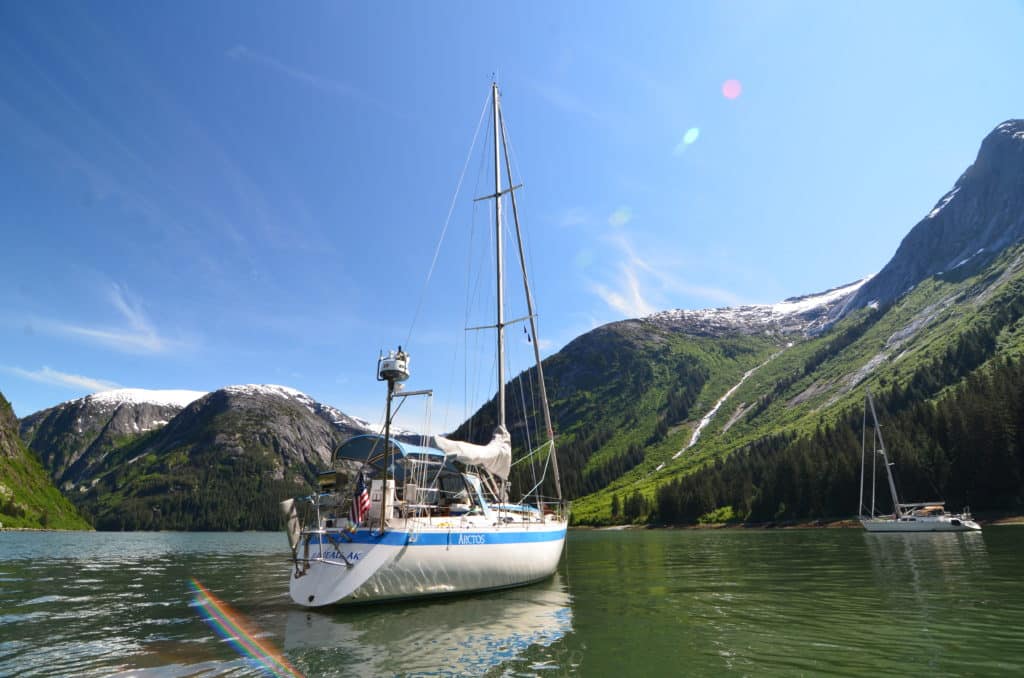
The Pretorien 35 does not pay homage to tradition. The Euro-style low-slung wedge deck and flattish lines were thoroughly modern when the Pretorien was launched in 1979. Sure, there are IOR influences in this well-proven Holman & Pye design, including a slightly pinched stern, cramped cockpit, and a high-aspect, short-boom mainsail that results in a large foretriangle. But a small main is easy to handle offshore, especially in squally conditions, and a large poled-out furling genoa provides a low-stress way to cross oceans. The test of a design is revealed long after the launch, and the Pretorien has aged brilliantly. It’s often mistaken for a Swan or Baltic. Famed voyager and author Hal Roth chose a Pretorien for his last boat.
Below the water, which is what really matters at sea, the Pretorien pushes the right buttons for serious sailing. A fine entry provides enough of a forefoot to prevent pounding in lumpy conditions, and as on the Valiant 40, the fin keel incorporates a stub to which the external ballast is fastened. The rudder is mounted well aft for excellent steering control, especially on a deep reach, and is tucked behind a narrow but full-length skeg. The Pretorien displaces 13,000 pounds, of which 6,000 pounds is ballast, translating to a stiff, seakindly boat.
The construction is superb. The solid fiberglass hull includes longitudinal stringers that stiffen the panels and encapsulate the bulkheads. Tabbing and fiberglass work is first-rate throughout. Wauquiez was one of the first builders to use solid laminate beneath high-load deck fittings. The side decks are wide and, with the chainplates well inboard, easy to navigate. The interior arrangement is conventional, but ample beam amidships helps create a surprisingly spacious feel below.
There were 212 Pretoriens built during a seven-year production run, so there’s usually a good selection of boats on the used market. Today’s strong dollar makes European Pretoriens an excellent value.
– SHOW THEM HOW MUCH YOU CARE – Nothing says ‘I love you’ like making sure the kids’ life jackets are snugged up and properly buckled. Safety Tip Provided by the U.S. Coast Guard
Gulfstar 44
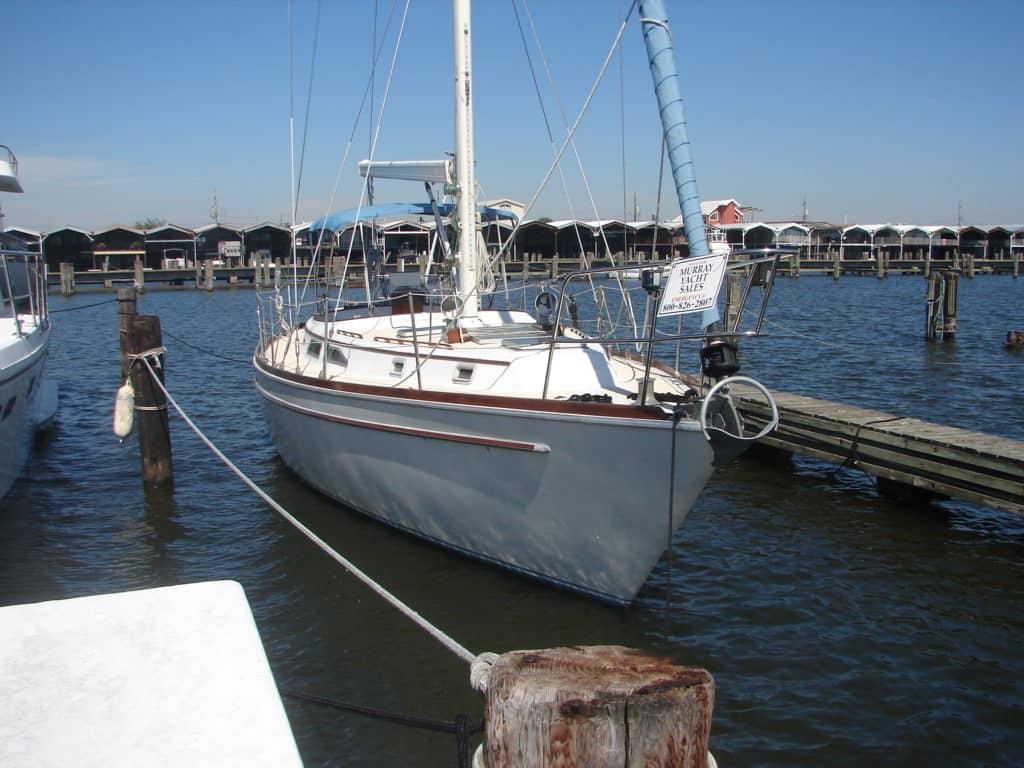
Gulfstar had a terrible reputation in the early ’70s: It was infamous for producing wide-body motorsailers with tiny rigs and chintzy Formica interiors. Company founder Vince Lazzara was adept at reading market trends and upped his game in the late ’70s and ’80s. Lazzara, who also founded Columbia Yachts, was a veteran of the production-sailboat wars and realized that buyers were demanding high-quality boats that sailed well. The Gulfstar 44 was launched in 1978, and 105 were sold before the company started producing the Hirsh 45 in 1985.
Some mistake the G44 for a Bristol, and it has a similar profile, right down to the teak toerail and raked cabin trunk. A sleek center-cockpit design, the hull shape features a 5-foot-6-inch fin keel, a skeg-hung rudder and moderate proportions. I know the boat well, having delivered one from Bermuda to Annapolis and another from Fort Lauderdale to Boston. It has a nice ride in lumpy seas and powers up when the big genoa is drawing on a reach. The construction is typical of the time, with solid fiberglass hulls and cored decks. Gulfstars were known to blister, and it’s likely that any 44 you find will have had an epoxy bottom job along the way — and if it hasn’t, it will need one. The keel-stepped spar has an air draft of 55 feet. Some owners have modified the sloop rig with a staysail. The cockpit is roomy, especially for a center-cockpit design, although there’s not much of a bridgedeck. All sail controls are led aft. Lazzara was an early proponent of this feature, and the boat is user-friendly overall.
The interior sells the boat. It’s nicely finished in teak, and the layout is made for living aboard. The aft cabin includes an enormous double berth with an en suite head and stall shower. The main saloon is spacious and well ventilated, although beware of the plastic opening portlights. If you are looking for a comfortable, well-built center-cockpit cruiser but can’t find one that you can afford, track down a Gulfstar 44; you’ll be pleasantly surprised.
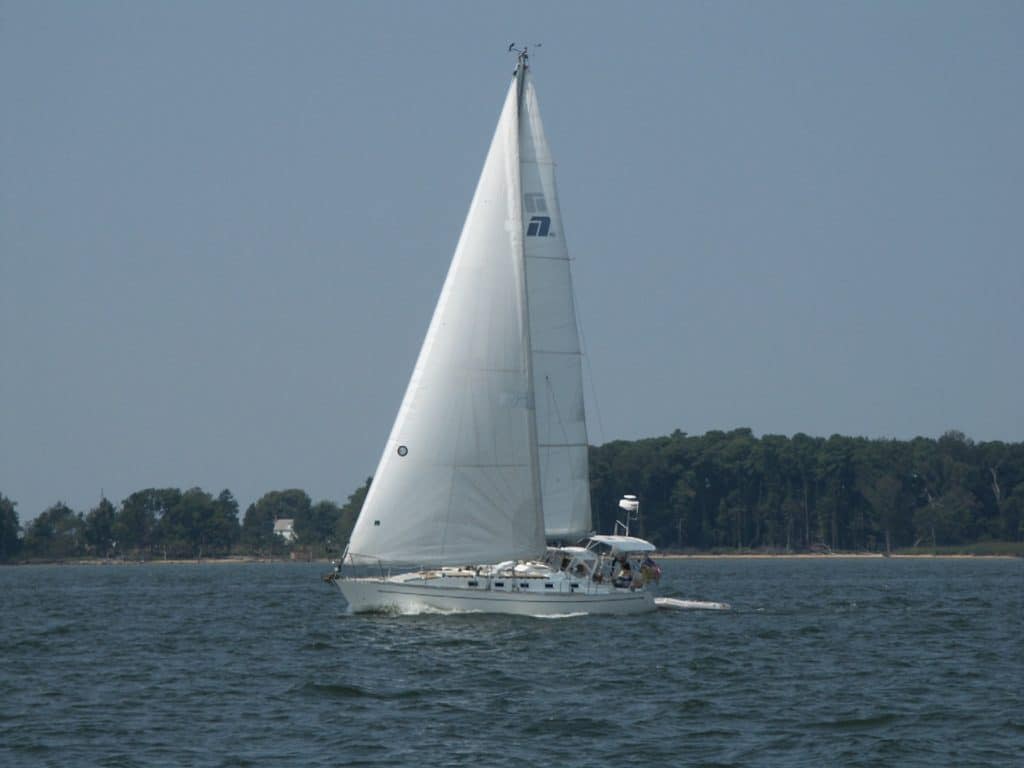
Any list of bluewater cruising sailboats must include a Robert Perry design. I could have easily put together nine Perry boats for this list. The Nordic 40 may surprise some, especially because 40 feet is an iconic length, bringing to mind such boats as the Valiant 40, Hinckley Bermuda 40, Bristol 40, Pacific Seacraft 40, Passport 40 and others. The trick is finding a 40-footer for less than $100,000. Nonetheless, the Nordic 40 and its larger sister ship, the 44, are among my favorite boats.
Based in Bellingham, Washington, Nordic produced world-class yachts during its brief production run in the 1980s. Only 40 Nordic 40s were launched between 1982 and 1987, but they’re worth seeking out on the used-boat market. The 40 features the classic double-ended Perry hull shape, with a fine entry, a deep and powerful fin keel, a skeg-mounted rudder positioned well aft, and a reverse transom. Freeboard is moderate and the sheer line is subtle, but to my eye, with its double-spreader rig and gently sloping deck line, the boat is poetry in the water.
The hull is solid fiberglass and the deck is balsa-cored, with solid laminates below loaded-up deck fittings. Original boats came with Navtec rod rigging and a hydraulic backstay, but many have been upgraded by now. Sail-control lines are led aft to the compact but functional T-shaped cockpit. The traveler is forward of the companionway, allowing for a cockpit dodger. The Nordic 40 is nimble in light to moderate breeze but can also stand up in a blow and heave to decently.
The interior is well suited to a cruising couple. It’s really a two-person boat, with a V-berth forward and large C-shaped galley aft, with plenty of counter space and a huge fridge. It includes the normal deft Perry touches — excellent sea berths, a separate stall shower and generous tankage. If you do find a Nordic 40 on the used market, be sure to take a hard look at the Westerbeke diesel and the V-drive transmission.
Pacific Seacraft 34
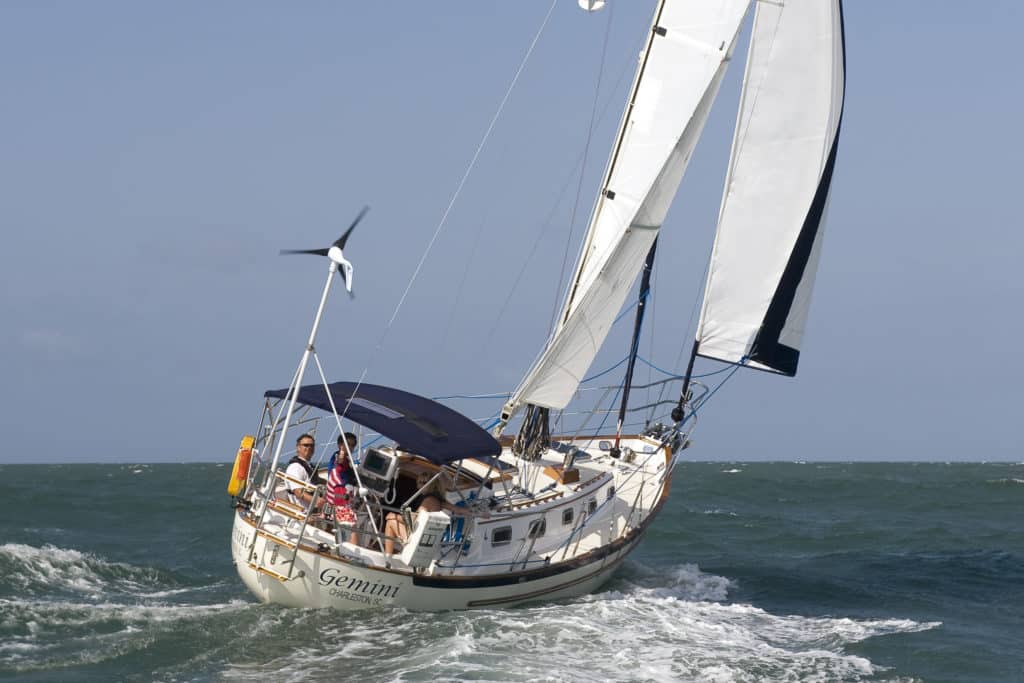
A handsome, nimble and capable double-ender by legendary designer Bill Crealock, the Pacific Seacraft 34 is well proven, with scores of ocean crossings in its wake.
After the boat was first launched as the Crealock 34 in 1979, Pacific Seacraft introduced a fifth model years later, a scaled-down version of the popular PS 37. Though expensive at the time, the 34 was another success story for one of America’s premier builders, and hundreds of boats were built in the company’s yard in Santa Ana, California. There is always a good selection of used boats available for less than $100,000. Another nice perk for used-boat buyers is that the 34 is back in production at the reincarnated Pacific Seacraft yard in Washington, North Carolina, providing an outlet for parts and advice. The company is now owned and operated by marine archaeologist Stephen Brodie and his father, Reid.
The 34 blends traditional values above the waterline with what was then a more modern underbody, with a long fin keel and skeg-hung rudder. A bit hefty at 13,500 pounds of displacement, the design otherwise is a study in moderation, and drawn with a keen eye toward providing a soft ride in a seaway and staying on good terms with Neptune in a blow.
The hull is solid fiberglass, and early decks were plywood-cored before Pacific switched to end-grain balsa. The hull-to-deck joint incorporates a molded bulwark that offers added security when you’re moving about on deck, and a vertical surface for mounting stanchions.
Most 34s are cutter-rigged for versatility but carry moderate-size genoas instead of high-cut yankees for more horsepower off the wind. Down below, the layout is traditional, but the 6-foot-4-inch headroom is a pleasant surprise. The Pacific Seacraft 34 is perfect for a cruising couple.
John Kretschmer is a delivery captain, adventurer and writer, whose own boat Quetzal , a 1987 Kaufman 47, has seen a refit or two over the years. His latest book is Sailing a Serious Ocean: Sailboats, Storms, Stories and Lessons Learned from 30 Years at Sea , also available on his website .
- More: classic plastic , DIY Sailboat Projects , Sailboat Reviews , Sailboats , used boat guide
- More Sailboats

Pre-Owned: 1988 Hylas 47

Catalina Introduces the 6 Series

Sailboat Preview: Elan GT6 Explorer

For Sale: 1984 Camper & Nicholsons 58

Galápagos: A Paradise Worth the Paperwork


Around Alone

Grease the Wheels of Your Boat: A Guide to Proper Lubrication

A Bowsprit Reborn: A DIY Renovation Story
- Digital Edition
- Customer Service
- Privacy Policy
- Terms of Use
- Email Newsletters
- Cruising World
- Sailing World
- Salt Water Sportsman
- Sport Fishing
- Wakeboarding
- Restored Boats For Sale
- 17' Deep V Center Console
- 23' Double Ended Sailboat
- 29' All Weather Inboard Launch
Norton Boat Works 535 Commercial Ave
Green Lake, WI 54941
920.294.3544 Shop 312.543.4689 Cell
Shop Hours Monday through Friday
7:30 am to 4:00 pm or by appointment
Recommend this page on:
Sakonnet 23 – 23' Double Ended Sailboat (LaLa)
Thi sis LaLa – the original Sakonnet 23. Designed by Joel White and built by Joe Norton III. We built the original boat that became the mold for the fiberglass Sakonnet 23 now manufactured by Edey and Duff. This is a time-proven design that we love dearly. Probably our most "famous" project, it has been featured in many articles and publications. Wooden Boat Magazine #126, Small Craft Advisor, Harken Bearings (Fall 1996), just to name a few, as well as countless other pages on the internet. There are even small-scale models based on this boat! Click the links below to read the articles. When you're done, give us a call. We'd love to build one for you!
Web View Mobile View
- Boats for Sale
Double-ender for sale (sail)
- Double-ender
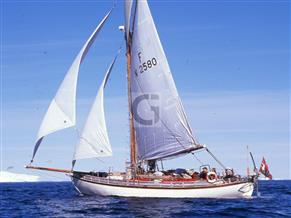
What is a Double-ender?
A sail double-ender is a type of sailing vessel that has identical bow and stern sections and typically carries a lugsail rigged on both masts. These vessels are designed to be able to sail quickly and efficiently in both directions and often have a narrow, shallow hull shape with minimum stability. They are often used in coastal and inshore fishing but can also be employed in short-distance cruising or racing. Historical examples of sail double-enders include cutters, luggers, schooners, and wherries.
Which manufacturers build double-ender sail boats?
Manufacturers that produce double-ender sail boats include Northstar , J W Miller & Sons Ltd , Ta Shing , Hardanger Fartøyvernsenter and LM .
How much does a double-ender sail boat cost?
A used double-ender sail boat on TheYachtMarket.com ranges in price from £29,900 GBP to £1,010,000 GBP with an average price of £324,000 GBP . Factors including the condition, age, model and specification will affect the price of a double-ender.
Sign up to our newsletter
By submitting this form, you agree to our Privacy & Cookie Policy
Change units of measure
This feature requires cookies to be enabled on your browser.
Show price in:
Show lengths, beam and draft in:
Show displacement or weight in:
Show capacity or volume in:
Show speed in:
Show distance in:


Sail Far Live Free
Double enders according to perry (guest post by bob perry).

| Baba 30 in Scotland |
| Baba 40 |
| Lafitte on a beam reach |
| Sawyer 42 |
| Baba 30 in slings |
- Sailboat Rigs According to Perry (Guest post by Bob Perry)
- Split Rigs According to Perry (Guest post by Bob Perry)
- Keels According to Perry (Guest post by Bob Perry)
- Top Ten Affordable Bluewater Sailboats
- Go Small, Go Now: 5 Pocket Cruisers to Take You Anywhere
- 50 Years of Cruising Sailboat Evolution by Ted Brewer
- Bluewater on a Budget: 5 Budget Cruisers for Crossing Oceans
I drove by Oceanus almost daily in a local yard. A very unique and beautiful boat. Unfortunately I was witness to her destruction by an excavator. The owner could not afford the insurance, yard fees, let alone the restoration. One of the most depressing sights I have ever witnessed.
Hi Bob, Loved the directness of your comments. Great to have you "de-mythologize" the double ender while making a point that I think is really important. Aesthetics matter: you own your boat to make you happy - and having the "prettiest fanny in the anchorage", the boldest bow or most elegant sheer or whatever turns your crank may just win out over the apparent logic of some other design choice. All the best from sailboat Wabi.
Well you have a point squatting at the stern slower etc etc. The way I see it the problem is getting the water flow to cleanly cleave off the stern not sucking the boat back or clinging on and climbing up the stern causing drag. My plans are doomed or are they. I remember seeing a valiant in a yachting magazine back in the day probably 1973 and thinking oh my God that is gorgeous one day I will have a boat like that. To find out that double enders are no good or in some way deficient is like discovering Santa (Saint Nicolas)isn't real. After seeing that boat I developed a disliking for transoms I don't like the way the lines of a boat flow beutifully and come that snap finnish. Here is my defence of a rounded stern: pionted structures whatever they are create stress pionts curved structures dissipate stresses eg. an egg. one good point. A lot of these boats are heavy full keel designs deep boats make deep waves, big drag but they don't have to be deep full keel jobs, if the stern runs flatter on the bottom I believe the water flow will cleave away better and the boat will be faster eg surfboards. I would also take issue with the idead that a boat should be pointy a the bow mayby and mayby not (complaints about V berths being small). I can't find the videos but have seen a skutsji being towed at 22 knotts, level and bolt upright in the water and I have also seen a tjalk being sailed at 11 knotts these things are fast. So what is my solution yet again the lemateraak.
Thanks for article. I'm no expert but canoe butts were built long ago when wood was fashioned; enabling strength of joins. I'm about to buy a canoe stern cruising yacht, for many reasons I'm going for a slower old girl design although she's of modern build. 1. We used to race Dragons and although the same weight, length and sail area of Etchell; Dragons loved the horsepower. Our last race was a rough one. Committee 40' power launch was with fear of capsize so start finish was routed to harbour Lee water. She was rough. Although we were juniors, we asked slip master if race cancellation suggestion was because of us and our open top sinkers if swamped but we're told race committee was with more concern regarding welfare of Etchell fleet, they'd be struggling. We didn't finish race. Only race we didn't finish. Collision at sea took out our shroud yet we launched without pop and hiked in on screaming reach with all colours. In a mad hurry because collision had paralyzed my forehand; lost muscle usage for 28 hrs. People that say long keelers don't plane don't understand high rythym and reflex. They plane gorgeously, just a bit loose and ready to spin like a ballerina. Without wide aft we have gone from balancing on a spear to balance upon a ball and turn can be substituted by yaw pitch. Ironic is sailing. Other choices of vessels included nice faster vessels with more volume aft. Eg 2 extra cabins and lots of extra space. Yet to stow brings slow whilst with older style of less volume, extra weight is loved as ballast. Some of my more or less experienced friends have never balanced an old bird, some have but went back to modern skiffing yachts. Way I see it is 100+ years ago there were no rescue boats, if you were caught out you battled for knots until blow had blown over or you rode something built for offshore and danced with a smile. We cruised a vertical tapered keel with spade for years. Almost outrun a 4 day 70 knot blow, were exhausted during 3 hours of ol' ship anyone spotted entrance yet. Yet with 1950s race boat, always full sail area. 2 mast positions; high and low. High during light wind, low during moderate, high again above 20knots because unlike modern designs, older designs usually have ability to discard excess horsepower and when she's blowing there's plenty of excess discard ratio to balance vessel with. Wider arts however want horsepower which is why they're are usually a lot faster but forcing horsepower is great during lesser conditions for lessons of less ons. Mother nature well above our strengths.. nice to feel our way sometimes.
Post a Comment
Popular posts from this blog, top 10 favorite affordable bluewater sailboats, go small and go now 5 pocket cruisers to take you anywhere.

Escape to the Sea: How to get from the Great Lakes to the Caribbean

Boat Profile
Caledonia Yawl II
An updated sail-and-oar classic
From Issue March 2024
W hen I happened upon a Caledonia Yawl II at the 2019 WoodenBoat Show in Mystic, Connecticut, it was love at first sight. The original Caledonia Yawl, a rugged 19′ 6″ double-ended beach boat designed by Iain Oughtred for clinker plywood construction, has four strakes; this second iteration has seven, and was originally commissioned by a customer in Germany in 1999. The new design proved more stable for sailing while possibly sacrificing some rowing efficiency. Iain based his design of the Caledonia Yawl on the seaworthy double-ended working boats of the Hebrides, Scotland, his adopted home.
I had built a Lumber Yard Skiff in 2017, a very simple 16′ design for first-time boatbuilders, and it was a major confidence-builder in my decision to take on the Caledonia Yawl II. That said, I don’t think previous building experience is a prerequisite; my skill level is at best described as a capable handyman around the house. Also, there are many tutorial videos available online that became indispensable during my project.
The plans arrived with 17 pages of notes and 10 blueprint-style sheets of drawings, including full-sized patterns for the molds and stems. Lines and offsets are also included with ample information to loft the boat, although lofting is not required. I purchased CNC-cut molds and planks from Hewes & Company of Blue Hill, Maine. The planks are delivered in 8′ sections and must be carefully scarfed together.
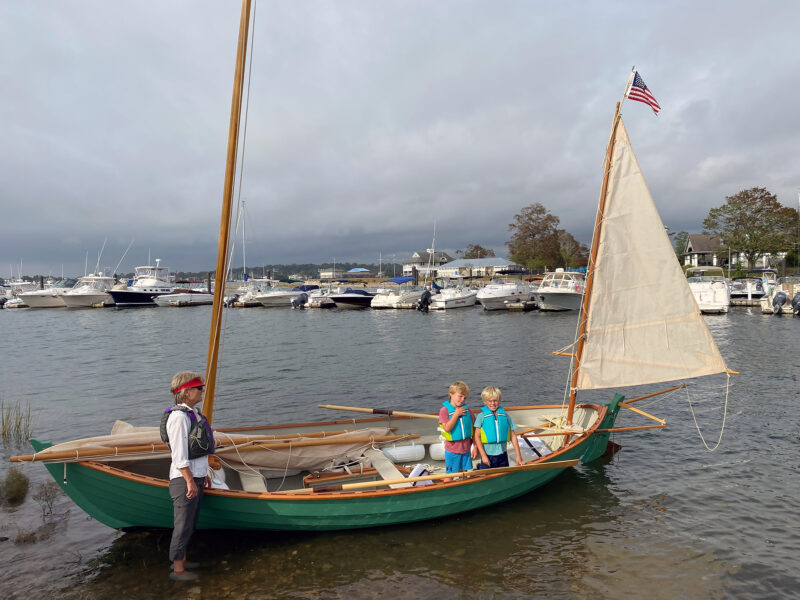
The Caledonia Yawl II has plenty of room for sailing with the whole family, especially with the open configuration. The decked version limits the cockpit area but provides covered storage areas and built-in flotation. The side benches provide a place to secure inflatable flotation like boat rollers or, in this case, a collection of fenders. The kick-up rudder blade is an option that makes beaching easy.
I built my boat to Iain’s specifications, which are impeccable in detail and readability. For a novice boatbuilder, the exquisite plans can eliminate many frustrations along the way.
The plans include options for the open-boat design or the decked-boat design, which adds built-in compartments in the bow and stern for storage and flotation. I chose the open-boat model, which has a real workboat look in keeping with its ancestry, and ample seating on three thwarts and two side benches. And while the plans call for the side benches to be 8″ in width, I would recommend adding an inch, or even two, for added comfort. The open-boat design requires adding flotation as an afterthought as it is not called for in the plans. The underside of the side benches provides a nice location to attach inflatable beach rollers. The sealed storage areas in the bow and stern of the decked version serve as its flotation.
Details for the oars—length and construction—are not specified in the plans, but Shaw & Tenney, a longtime supplier of oars for the Caledonia Yawl, provided recommendations, and I purchased my 11′ 6″ oars from them.
The plans come with three sailing rig options: a balance-lug yawl, a gunter yawl, and a balance-lug sloop. I chose the balance-lug yawl; it is a very popular rig for these small sail-and-oar boats, and I had once owned a yawl and love the way a boat lies head-to-wind with the mizzen sheeted in.
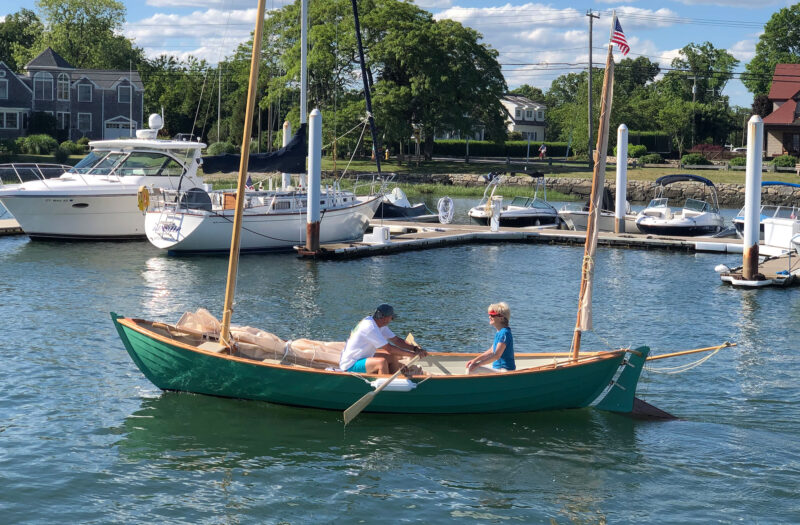
The Caledonia Yawl II tracks well under oar. The 11′ 6″ oars are long but a good length for the boat’s 6′ 4 ½″ beam. Shorter oars would be easier to stow, but would elevate the handles too much during the drive of the stroke.
T he plans arrived August 2019, and by January 2020 she was ready to launch. Our first summer with the Caledonia, christened SPARGE, was a time of learning.
For rowing, once I get a head of steam, the Caledonia Yawl II rows and tracks amazingly well for its size. However, when against both wind and tide, it’s a lot of boat for a solo rower, and I’m guaranteed a workout. For sailing, I had to get used to the Norwegian tiller, which passes to one side of the mizzenmast.
Because the luff of the boat’s rather large lug main is not attached to the mast, and the rig has a large yard, the sail can become unruly as you raise and lower it. We have found the quicker we raise and lower the main, the better it behaves. And the luff must be taut—very taut—for the best performance, especially to windward. I added a second block on the downhaul to create more purchase and tension.
Once we overcame these teething troubles, my wife Dawn and I enjoyed many good day sails and picnics on the boat, but we shied away from going out when the whitecaps appeared. On a warm August day in our first season, in 10 to 15 knots with a double-reefed main, we capsized. A large gust pushed the lee gunwale under the water, and before I knew it the boat was on its side and we were in the water (when back on the beach I was told that the sudden blast of wind had come out of nowhere and sent most of the umbrellas flying). Fortunately, the mainmast, with its hollow bird’s-mouth construction, had enough buoyancy to keep the boat from turning turtle.
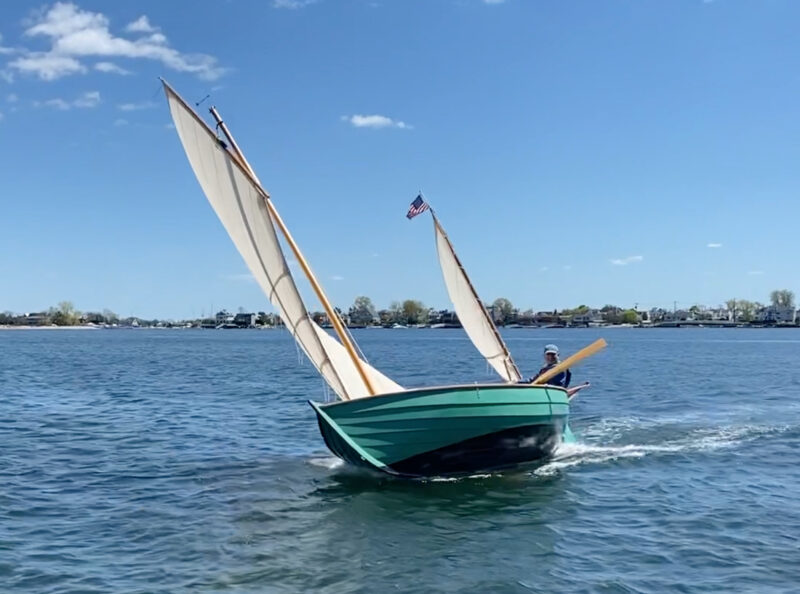
The Caledonia Yawl’s beam and full midsections stand up to the press of the sail in a good sailing breeze.
I had seen videos on how to recover from a capsize, and I was able to right the boat by standing on the centerboard, but with no built-in flotation the gunwales were at the waterline and the sea was breaking in with no hope of bailing. We were towed to a nearby beach by a good Samaritan and recovered there. The incident revealed the need to have the right amount flotation to keep the boat high enough to be boarded and bailed out in the event of a capsize.
In retrospect, I can point to our inexperience with the Caledonia Yawl and several mistakes that contributed to our capsize. First, my wife was comfortably sitting on the lee side of the boat; second, after reefing I did not sufficiently retighten the downhaul on the mainsail, making the upwind tack more difficult; and third, I don’t recall if the mainsheet was cleated or not, but I clearly did not react quickly enough to release the sheet in those conditions. Since then, I have human ballast only on the windward side except in very calm conditions, I never cleat the mainsheet, and I always keep the downhaul really taut.
T hat whole experience got me thinking about the alternative three-sail gunter-yawl rig: jib, main, and mizzen. I thought we would benefit from having a jib, which would allow me to drop the main altogether and sail happily on jib and mizzen when unexpected weather arrives. During the off-season I took almost all the steps necessary to convert the rig, including new boom, yard, mainsail, and jib. I elected not to move the mast partner aft for the gunter rig as shown on the plans because I wanted to be able to go back to the lug rig easily if desired. I do not think the gunter rig suffered any performance issues as a result.
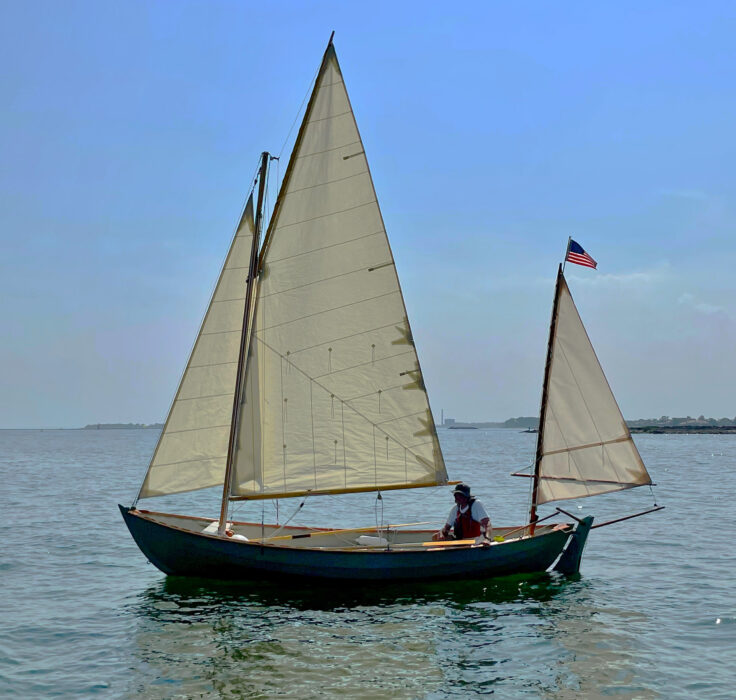
The gunter-yawl rig, one of three rigs detailed in the plans, provides several reefing possibilities when dealing with building winds. While this rig and the lug rigs have similar total sail areas, some may find it easier to manage the 108-sq-ft gunter main than the 136-sq-ft lug main. However, the forestay, shrouds, jibsheets, and two more halyards add a level of complexity that isn’t necessarily compatible with simple trailer-sailing.
We sailed the entire second season with the gunter yawl and enjoyed the benefits of the three-sail rig. I believe the boat pointed a bit higher than with the lug rig, and most important, she sailed quite well and balanced under jib and mizzen alone, which we enjoyed often when the weather presented itself and the wind piped up.
I also added the recommended flotation that winter, which should ensure the centerboard trunk opening is above the waterline after righting the boat in the event of another capsize.
What wasn’t obvious at the beginning of this conversion was how many additional parts and pieces I was adding to my boat. This list includes a forestay and two shrouds (the balance-lug rig requires no shrouds, just a free-standing mast), a peak halyard, a throat halyard, a jib halyard, a kicking strap, and two jibsheets, all detailed in the plans. If my goal was to simplify sailing in rougher weather, I sure created a lot more lines to worry about, and an additional 10 to 15 minutes of rigging and de-rigging time at the ramp. By the season’s end I was very happy with the new rig, its appearance, performance, and versatility, but I could not stop thinking about the less-complicated lug rig and suspected I had not given it a proper chance.
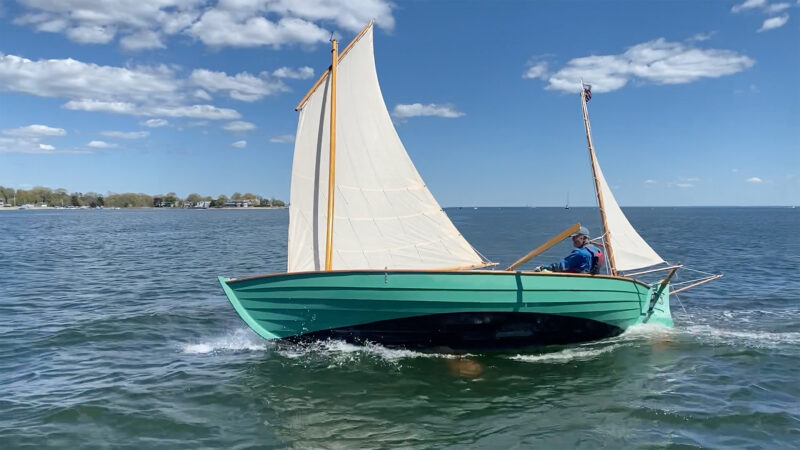
The lug main is a powerful sail but doesn’t require the standing rig that the gunter uses, so it’s easier to set up at the launch site.
For season three, I reverted to the simpler balance lug rig and set out to master it. I sailed alone in all kinds of weather. I added an outhaul on the mainsail, which, in addition to the highly tensioned luff, allowed the balance lug to perform at its peak. I now was sailing unreefed comfortably in up to 12 knots of wind. The balance-lug yawl rig is self-tending, so I need not touch a line when tacking. I go to a double reef in the main at about 13 knots and sail there comfortably up to 18 knots for pleasure. I can add a third reef if needed but have not yet had to; all three reefpoints are in the plans. The Caledonia Yawl is an amazingly dry boat, and other than inadvertently dipping the gunwale into the sea, I don’t believe I have taken on more than a teacup of water over the bow. And, I can confidently say that with my renewed effort to conquer the lug rig, I am regularly weathering gusts and seas in rough conditions without issue.
I have now just finished season four, and my Caledonia Yawl II is one of the fastest, prettiest boats on Long Island Sound. I often hit 8 knots on a broad reach, 6.5 knots on a close reach. And while it might have taken a while, the boat now exceeds even my wildest dreams. I trailer her from the same garage she was built in. I can rig and de-rig her at the ramp in 20 minutes, although it often takes longer as I take time to talk with interested bystanders who inevitably ask about the boat.
And while my bones are a bit too brittle for camp-cruising, something I did 25 years ago, four-to-five-hour gunkholing excursions and short-tacking up creeks are a delight with the Caledonia. The Norwalk Islands present many opportunities to go either by sail or by oar where many others cannot.
Donald Sullivan and his wife have sailed extensively throughout their 45-year marriage. They have owned a mahogany-planked 20′ Pennant Sloop, a 28′ gaff-rigged wooden sloop, an 18′ Drascombe Lugger, a 22′ Pearson Ensign, and a 1966 Hinckley Pilot 35. The boats each served a purpose well in their time, but at 71, Donald enjoys the simplicity of trailer-sailing, the performance of a great design, and the beautiful looks of a traditional boat.
Caledonia Yawl II Particulars
LOA: 19′ 9″ LWL: 16′ 1″ Beam: 6′ 4 1⁄2″ Hull weight: 450 lbs, all up 650 lbs Displacement WL: 1,090 lbs Sail area: 164 sq ft
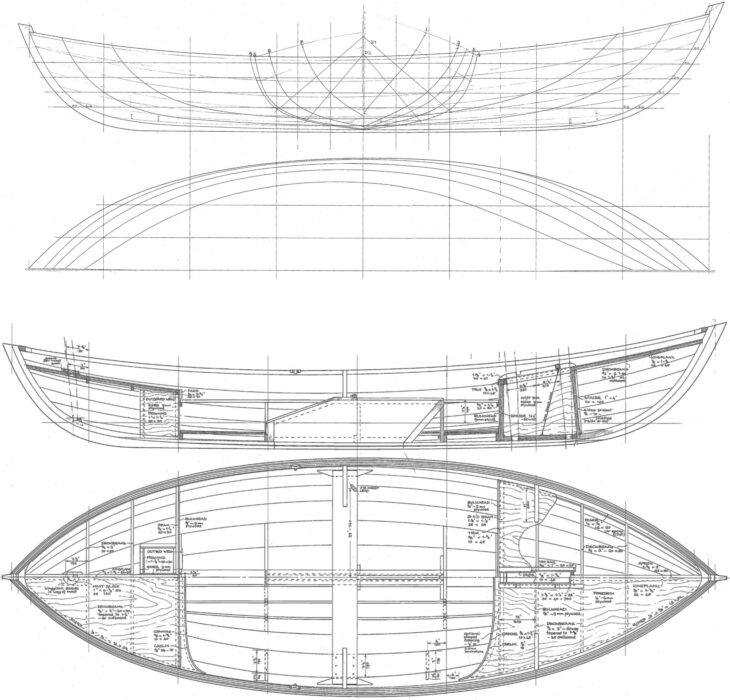
Is there a boat you’d like to know more about? Have you built one that you think other Small Boats readers would enjoy? Please email us.
Share this article
Join The Conversation
We welcome your comments about this article. If you’d like to include a photo or a video with your comment, please email the file or link.
Comments (19)
Donald – well done! Boat looks great. I am really pleased to find someone that has sailed both the lug and gunter version. I opted for the gunter on my CY and am preparing for my first season. One question: It looks like your boom on the gunter is on a gooseneck. Is that the case? If so, which one did you go for?
Cole, I went with the “jaws”, as drawn on page 5 of 10 of the plans called Sail Plan II. They’re just a series of laminated pieces, and it worked very well with a cord and some parrel beads.
You will be very happy with the Gunter rig.
Cole, I misspoke above, I was mistakenly referring to the laminated jaws on the yard. I also did jaws on the boom (much simpler) by just cutting out a shape on 3/4 marine plywood and gluing to the boom. I can send a pic if you’d like. Also closed this jaw with cord and parrel beads. A jaw in this application is nice because it slides up and down, some goosenecks are rigid. Sorry for the confusion.
Very lovely! Beautiful job; beautiful design. Ian will be sorely missed.
I was interested in your experiences with the two different rigs. I had a 12ft skiff that I first rigged with a lug rig, but found that tensioning the luff to give decent windward performance would cause the mast to bend substantially, due the compression load, which would then allow the luff of the sail to sag away again. I changed the rig to gaff; then the mast bend acted to flatten the sail in stronger winds, rather than get fuller as happened with the lug rig.
Andy, The birds-mouth construction of my main mast makes it amazingly stiff, so I haven’t had that problem, although I understand what your saying . . . a sagging luff on a lug rig can be very debilitating, whatever the cause. Sounds like you made a good solution.
A loop of parrel beads would help hold the lug’s yard against the mast. This is a common solution.
You did a beautiful job on your boat. I have owned the plans for 20 years or more, and now that I am past my mid 80s, I fear I may not get around to building. I do scan the classifieds from time to time hoping one might show up. I would be quite content with the 4-plank hull as opposed to the 7-plank one. I see some CYs with outboard motor wells, but it looks like your situation allows you to depend on oars; it;’s always nice to dispense with the stinky noise makers.
David, thanks for your note, I recommend offcenterharbor.com, they have a boats for sale section which often has one or two Caledonia Yawls in it.
And you are right, no outboard for me. However, I have seen folks add lightweight electric motors on nice simple brackets, something I may think about as well as I get older.
Nice boat. I also have a Caledonia II rigged with a balanced lug for simplicity and ease of set up. I have not added a mizzenmast yet but am interested in trying it to see how much difference it will make. I, like you, love cruising in it.
Wayne, I think you should try the mizzen, it will give you two wonderful things. First, with the mizzen sheeted in tight, she will keep the boat head-to-wind while raising and lowering the mainsail. And two, just slight adjustments to the mizzen will eliminate any weather helm and keep the boat very balanced. It’s also very good-looking.
Donald, interesting that you have tried both lug and Gunter versions. I built Oughtred’s Sooty Tern, which is a narrower version of the CY. On another matter: I too will be sailing on L. I. Sound. I noticed no CT registration number. I don’t really want to mar my boat with 3” numbers, but wonder about compliance. Any sailboat over 19’6” is supposed to have a vessel registration. Furthermore I worry that I’ll have to have a USCG inspection with possible annoyances like requiring built-in flotation. What’s your thinking on this? Malcolm Meldahl Deep River, CT
Don’s Caledonia finished shorter than the designed LOA and fell just shy of requiring registration. —Ed.
Malcom, in addition to Chris’ comment above, I did add inflatable boat rollers under the side seats as floatation, which more than covers the Connecticut requirements.
Hi Don We seem to have some common experiences with the CY2. I built mine in 2019 ( see AUDREY JAMES in the April 2020 Small Boats ). A very fun and delightful open-air driveway build. Once it hit the water the discoveries started. I also have the balanced lug with mizzen. I have since fabricated a short bowsprit for a roller jib. This has been a great improvement in handling and sailing abilities. I sail with 1 reef 80% of the time due to the southwest breeze kicking up pretty quickly here in Narragansett Bay, RI. I keep the mizzen reefed also. The jib makes up for the reefed main with less sail aloft. I have a double block downhaul and mainsheet. I put a single block purchase on the main halyard to ease the load while setting and striking ( have one hand free to grab the sail & yard). My small electric motor didn’t quite do the job so I have a 2.3 hp to keep me out of trouble. The motor also allows me to enter areas I normally wouldn’t go. No capsizes yet! I camp-cruise Narragansett Bay and some of the larger CT & RI lakes and salt ponds. Considering the Connecticut River this year. Perhaps we’ll cross wakes. Nice work! Marty Casey
Marty – can you share more information on how you set up your balanced lug/mizzen with the bowsprit/roller jib? Contemplating different riggings for my build, and this is an interesting addition without going full change to gunter yawl rig? Thanks! Jason
Marty, thanks for your note . . . your boat looks beautiful. If you have a picture of her under sail with the bow sprit and jib, please post.
No pics with jib set. Stay tuned…early lauching soon.
Great story, beautiful boat. I’m playing with boats on the other side of the Sound. I also had a 20′ Pennant Sloop, loved that boat.
I have found it a pleasant pastime to build scale models of the boats I like. My first was a solid wood model of an H28 (Herreshoff ketch) that appeared in one of the boat-building magazines. (I heard that GIs returning from WWII fell in love with that design). I built that instead of studying at my desk while in college. Later I built a Ted Brewer 22′ ketch designed for plywood construction, and planked it up with thin red cedar that I cut on the table saw. Have done the same with a John Gardner Swampscott dory, a Bolger double-chine outboard skiff, and also a 9′ round-bilge pram in Chapelle’s Small Boats . For that one, I lofted the lines and built a mold frame just as you would in building the real thing. Lining off the plank shapes for this lapstrake dinghy was an interesting task. As I was trying to bend in tiny ash frames, I got frustrated when the frames almost instantly cooled off from the teakettle steaming. That’s when I tried bending with dry heat; it was winter, and I was standing next to a hot stove pipe, when I got this inspiration. Oh, also did a model of a Bolger outboard skiff with a double-chine hull. All of these smaller boats I did at a 1″ to 1′ scale, just to simplify the math.
Though I made my own “lumber” on the table saw, hobby shops often have extremely thin plywood that should work very well.
I recommend anyone contemplating building a boat to build a scale model first. It should take you hours, or at most days, instead of months or years. You get to see what the 3-dimensional boat will look like, and can also deal with complications and dilemmas that might intimidate you on the full-size vessel.
I miss the days when boat-building magazines featured plans you could build from, though of course they wanted you to buy the actual blue prints from the designer. These included “Sports Afield’s Boatbuilding Annual,” “How to Build 20 Boats,” “Boats You Can Build” and “MoTorBoat’s Ideal Series,” which consisted mostly of Billy Atkin’s designs. One of his most intriguing is “Pocahontas,” a 12′ gaff-rigged, teak planked (lapstrake) sloop of 1400 lbs. displacement (!). Haven’t tackled that one yet, but it is tempting. It is really a little ship, with actual deadeyes instead of turnbuckles for the standing rigging.
Leave a Reply Cancel reply
Your email address will not be published. Required fields are marked *
Stay On Course
More From This Issue
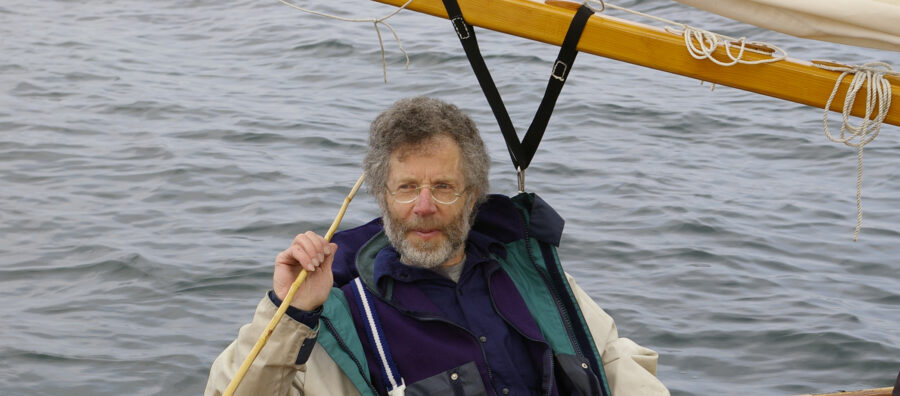
From The Editor
Iain Oughtred
Iain Oughtred, the Australian-born boat builder and designer whose boats frequently appeared in Small Boats, passed away on February 21, at the age of 85, in a hospital near his…

The original Caledonia Yawl, a rugged 19′ 6″ double-ended beach boat designed by Iain Oughtred for clinker plywood construction, has four strakes; this second iteration has seven, and was originally…
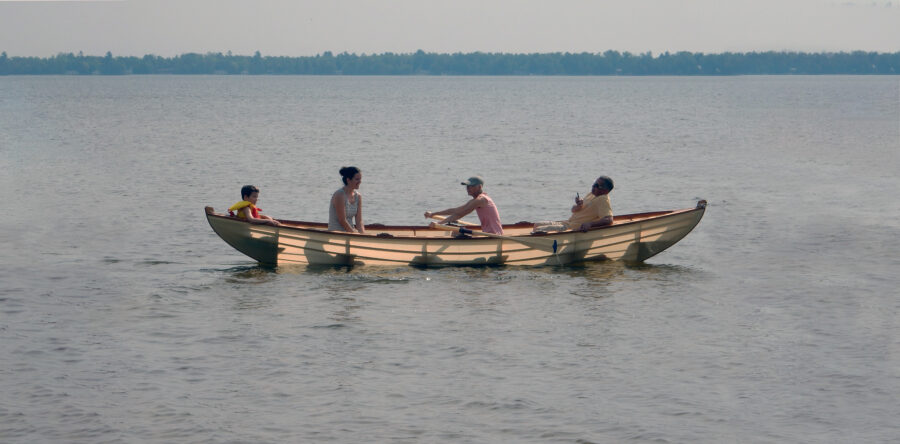
Chamberlain Gunning Dory
I looked online for an easy-to-build rowboat that we could use for exploring local lakes and rivers, and perhaps, some camp-cruising. I came across Dave Gentry’s Chamberlain Gunning Dory, based…

The Åland Islands
It was August, and under a brilliant blue sky we were off to explore the islands of Åland, the autonomous region at the southernmost tip of Finland where Swedish is…
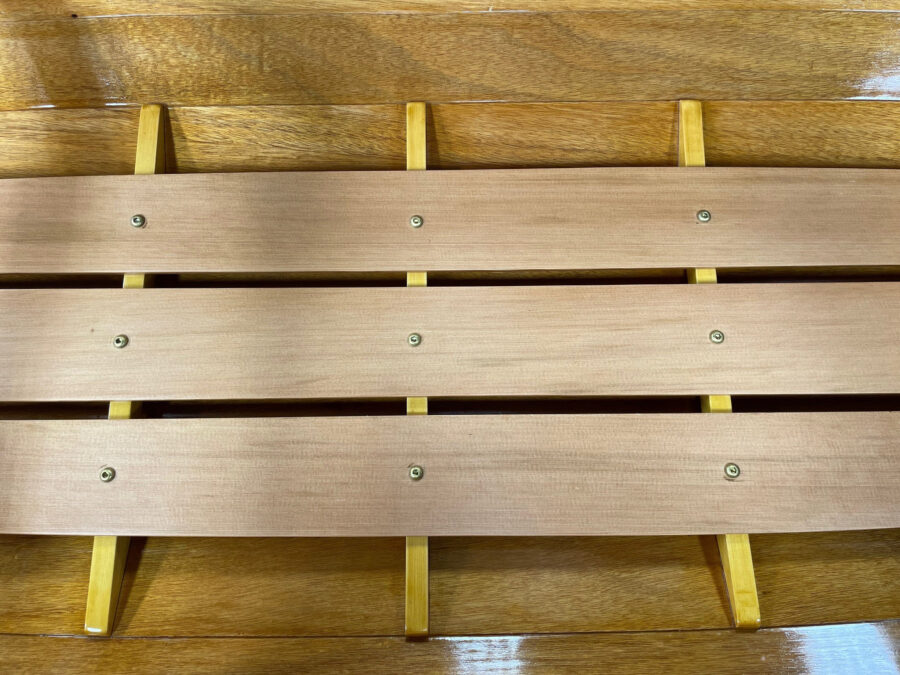
Fastening Floorboards
Wood screws can hold floorboards in place, but they’re not suited for being removed and reinserted. Wooden turn-buttons are an effective approach in many cases, but in smaller craft, where…
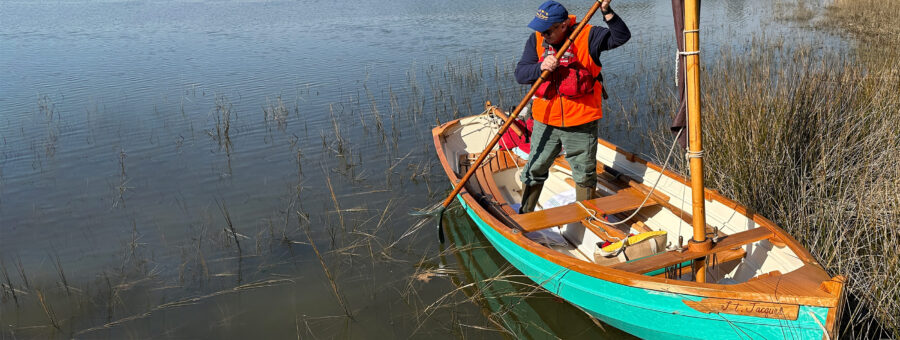
Product Reviews
A Duckbill for a Push Pole
The push poles used in the mudflats and marshes in the East Bay area have lengths ranging from 12′ to 18′. There are many different attachments for the bottom end…
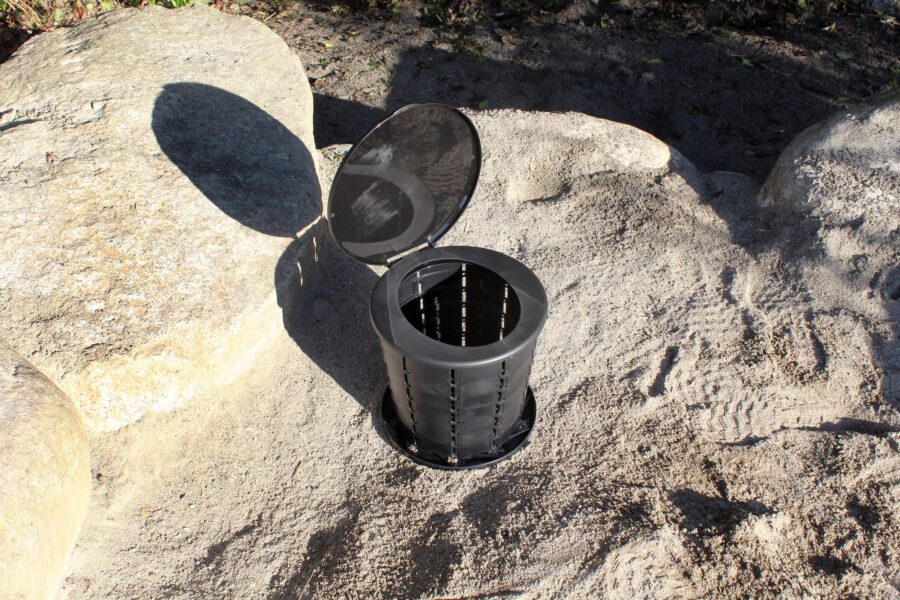
TripTips Retractable Portable Toilet
I’ve become accustomed to the comfort and convenience of portable heads, but they’re too big to carry aboard my canoes and small rowing boats. I’d still like to cruise in…
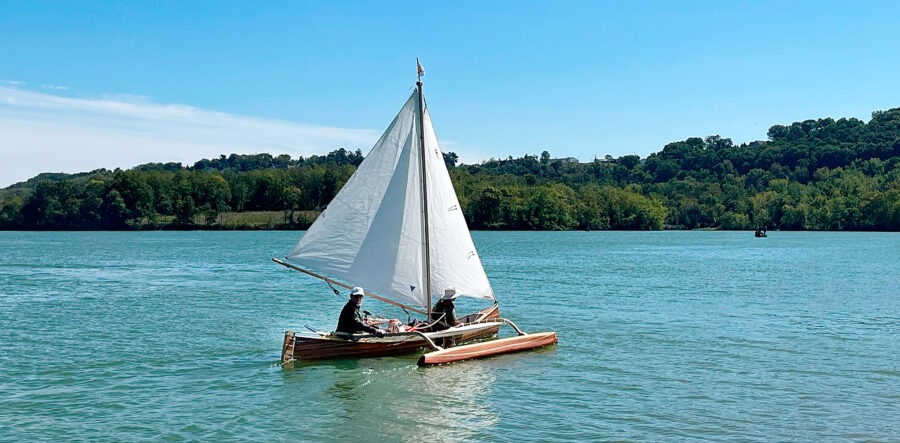
Reader Built Boats
Sailing DORCAS
Erik imagined putting a sailing rig on DORCAS, and as he developed the idea, he came up with some design parameters: The rig had to fit inside the back of…
More Boat Profile
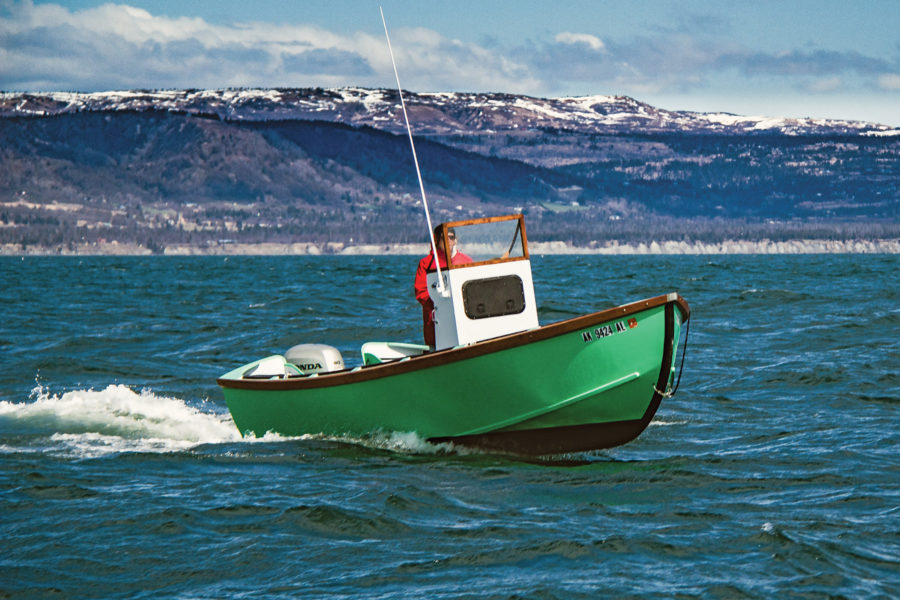
Dave Seaman designed ZEEK to be fast and comfortable in Kachemak Bay's choppy waters. A chop of 3' is not uncommon. The 90-hp outboard will drive her to a maximum…
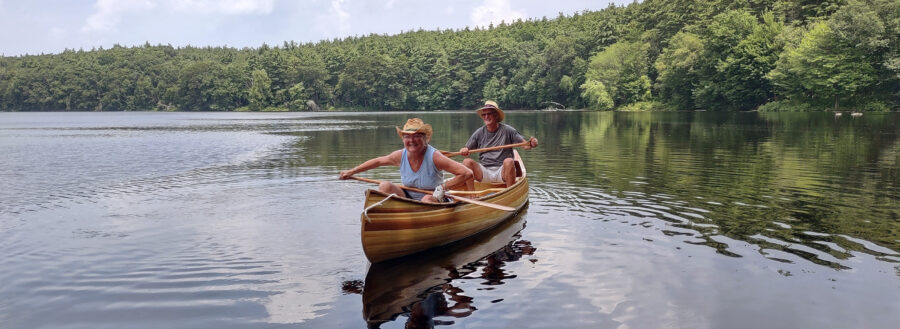
The Laker Canoe
The decision to build a cedar-strip canoe came about when a close friend loaned me Gil Gilpatrick’s “Building a Strip Canoe.” He thought it would be a nice wintertime project…
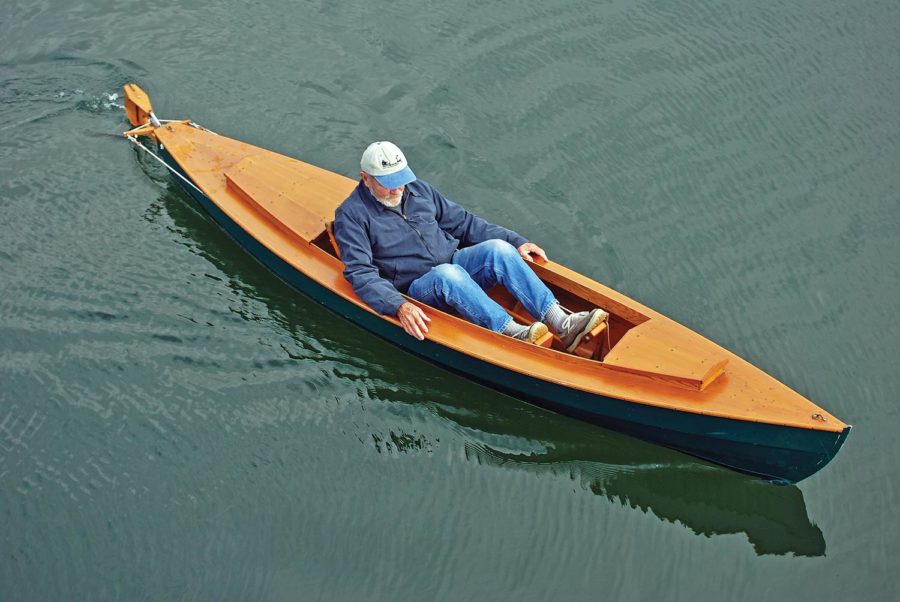
Harry Bryan’s 12’ Thistle is powered by a large rudder shaped like a fish’s tail and driven by foot pedals. With steady pedaling you can keep pace with about any…
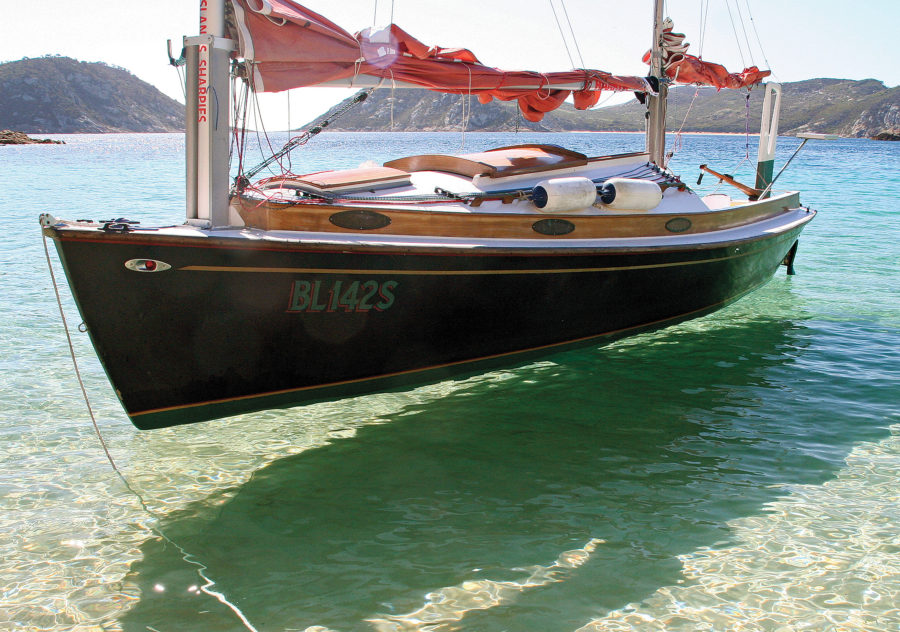
The Norwalk Islands 18 and Its Cousins
The Bruce Kirby–designed 18’ Norwalk Islands Sharpie is the latest and smallest in a family of boats ranging all the way to 43’.
Subscribe Today!
Become a subscriber today and you’ll recieve a new issue every month plus unlimited access to our full archive of backlogged issues.
Already a subscriber? Sign In
Subscribe For Full Access
Flipbooks are available to paid subscribers only. Subscribe now or log in for access.
Double ender boats
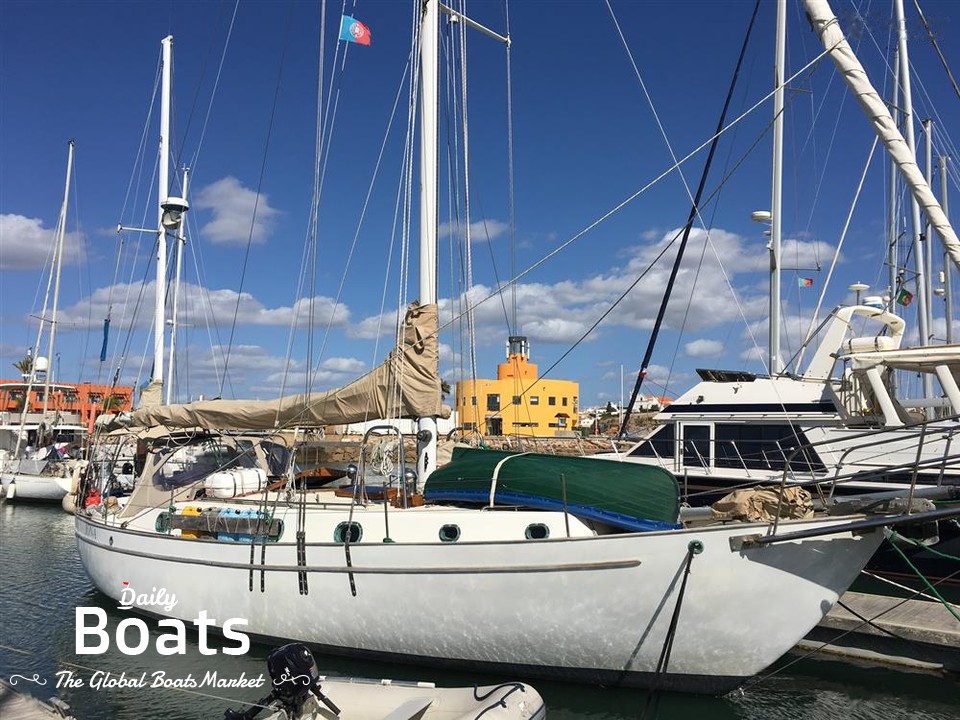
Everything You Need to Know About Double ender boats
Introduction.
If you're in the market for a new boat, you may have come across the term 'double ender.' But what exactly are a double ender boat? We'll explore everything you need to know about Double ender boats, from their history and uses to the different types available.
A double ender boat are simply a vessels with two pointed ends. This design dates back thousands of years and was used by early cultures for transportation and fishing. Today, double enders are still popular for both recreational and commercial purposes. Let's take a closer look at some of the advantages of these boats:
Double enders are extremely versatile. They can be used for sailing, powerboating, canoeing, and kayaking
They're also very stable, making them ideal for activities like fishing or diving. And because they have two pointed ends, they're able to travel in both directions without having to turn around.
When choosing a double ender boat, it's important to consider your needs. Are you looking for a vessel for recreation or commercial use? Do you want a sailboat or powerboat? Once you've answered these questions, you can start doing your research. There are many different types of double enders on the market, so it's important to test out a few before making your final decision.
What are Double ender boats
History of double ender boats.
The first Double ender boats were created in the early 1800s. They were designed for fishing and transportation purposes. The double ender boat allowed for more space on the deck and improved stability while underway.
In the early 1900s, double enders became popular among recreational boaters. They were often used for racing and cruising. Double enders also became popular among fishermen, as they provided a stable platform for fishing.
Today, Double ender boats are still used for both recreational and commercial purposes. They are popular among fishermen, cruisers, and racers alike. Double enders offer a unique experience on the water, and provide a stable and comfortable platform for any activity.
How are Double ender boats used
Double ender boats can be used for a variety of activities including fishing, cruising, racing, and transportation. They are often used by fishermen because of their stability while underway. Double enders are also popular among cruisers because they offer more space on the deck than traditional boats. Racers also enjoy double enders because of their stability and comfort while underway.
Advantages of Double ender boats
There are many advantages to owning a double ender boat including stability while underway, more space on the deck, and comfort while underway. Double enders are also easy to maneuver in tight spaces due to their unique hull design.

Types of Double ender boats
Sailboats are the most common type of double ender boat. They come in all shapes and sizes, from small one-person boats to large multi-person boats. Sailboats are typically used for recreation, racing, or transportation.
Advantages of sailboats include their ability to move in all directions, their lack of noise pollution, and their low maintenance costs. Disadvantages of sailboats include their reliance on wind power and their susceptibility to bad weather conditions
Powerboats are another type of double ender boat that is powered by an engine rather than by wind power. They are typically faster than sailboats and can be used in a wider variety of water conditions. However, powerboats also have some disadvantages, such as higher fuel costs and more maintenance requirements.
Canoes and kayaks
Canoes and kayaks are smaller, lighter versions of Double ender boats that are typically used for recreation or transportation in calm waters. Canoes and kayaks have many of the same advantages as larger Double ender boats, including their low cost, lack of noise pollution, and easy maneuverability. However, they also have some disadvantages, such as being less stable in rough waters and requiring more physical effort to paddle.
How to choose the right double ender boat
Consider your needs.
The first step in choosing the right double ender boat is to consider your needs. What will you be using the boat for? Fishing? Cruising? Racing? Once you know how you will be using the boat, you can begin to narrow down your options.
Do your research
After you have considered your needs, it is time to do your research. There are many different types and styles of Double ender boats available, so you will want to take some time to compare different models. Read online reviews, talk to friends or family who own boats, and visit boat dealerships to get a feel for what is available.
Test it out
Once you have done your research and narrowed down your choices, it is time for a test drive! If possible, try to borrow or rent a boat of the type you are considering before making a purchase. This will give you a chance to see how the boat handles and if it is a good fit for you.
A double ender boat are simply a vessels with two pointed ends. This design dates back thousands of years and was used by early cultures for transportation and fishing. Today, double enders are still popular for both recreational and commercial purposes.
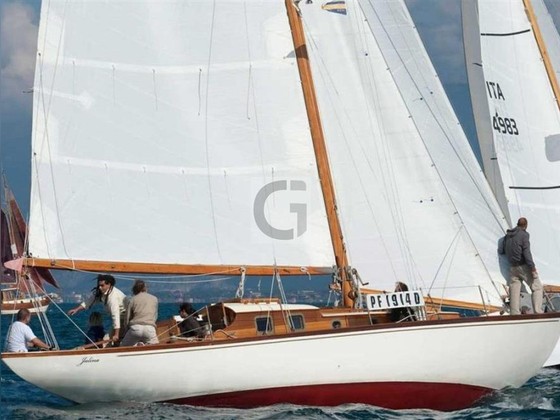
Double ender boats for sale

Lagoon Catamarans 440

Hallberg-Rassy Yachts 94

Finnsailer 29

McGruers 42

- Aluminum boats
- Center console boats
- Fishing boats
- Motor boats
- Narrow boats
- Speed boats
- Bowrider boats
- Cabin cruiser boats
- Cargo ships
- Charter boats
- Commercial boats
- Container ships
- Cruise ships
- Cruising boats
- Downeast boats
- Fishing trawlers
- Flats boats
- Floating homes
- Floating houses
- Hovercrafts
- Lobster boats
- Mega yachts
- Motorsailers
- Offshore boats
- Power catamarans
- Runabout boats
- Sailing catamarans
- Sailing yachts
- Sport fishing boats
- Superyachts
- Trailer sailers
- Walkaround boats
- Widebeam boats

- Forum Listing
- Marketplace
- Advanced Search
- All Topics Sailing
- General Sailing Discussions
- SailNet is a forum community dedicated to Sailing enthusiasts. Come join the discussion about sailing, modifications, classifieds, troubleshooting, repairs, reviews, maintenance, and more!
Pros and cons for a double ender/Canoe Stern
- Add to quote
I have started the long process of buying my first sailboat. I'm trying to get it right on the first try. Yeah, I know it will not be perfect but I would like to get something that I don't dread looking at 6 months down the road. I recently found a "Top 10 Favorite Affordable Bluewater Sailboats" list. I'm sure the author of this list has his own opinions but one thing that I noticed from the list is that a lot of the boats shared a common design, they were Double Enders or Canoe Sterns. Could I get some opinions from some of you with experience concerning these designs versus a wider stern? If there has already been a thread like this that one can refer me to, please do so. A search didn't show anything. Thank-you in advance for any helpful advise you can give me.
They look beautiful. But beyond that, I'm not sure there are really any advantages of a canoe stern/double-ender. Recall reading posts from Bob Perry asserting as much. A *huge* cone is the loss of massive amounts of space in the stern area below and a much tighter/smaller cockpit. Especially compared to modern designs that have a tendency to have a very huge stern beam and open areas of the cockpit to allow water to flow out if a wave hits ya. Canoe stern, well, I think you're relying on scuppers draining and/or downflooding the living spaces!
Thanks for the post.. You are dead on speaking of Bob Perry. This same website that I found the 10 affordable Bluewater Sailboats list on also had an interview with Bob Perry. He designed a few but still seemed to wonder why someone would want a boat to sail in reverse. In my opinion he mainly said it was a marketing issue. Having a "dry" , safe and stable boat would be among my top priorities. Once again, Thank-You.
Double enders have very small cockpits. They get pooped more often i.e. Waves over the back, the are old designs. There isnt much going for them as a cruiser.
Tell that to Gary Burton .
I am cruising with a double ender. Never been pooped so I'd love to see facts on that one Mark. Smaller cockpits, absolutely ... Just like you want in a sea going boat. Not nocking modern designs. Open transoms would drain fast, but the main reason for that design is to hold all the dock parties most of these boats do most of the time (Mark not included). Double enders are safe, secure and sensible sea boats. Best of all, they look good -- not like some motorboat wannabe ;-)
My friend has a canoe stern, and he was extolling the virtues of that design to me at some point. I, of course, promptly forgot what they were because his boat's WAY out of my financial and experiential leagues so the info didn't stick into my admittedly "Need-to-know" based brain. I'll probably talk to him today while we're out on the water and I'll ask him again. May have had something to do with comfort with following seas? Barry
bblument said: My friend has a canoe stern, and he was extolling the virtues of that design to me at some point. I, of course, promptly forgot what they were because his boat's WAY out of my financial and experiential leagues so the info didn't stick into my admittedly "Need-to-know" based brain. I'll probably talk to him today while we're out on the water and I'll ask him again. May have had something to do with comfort with following seas? Barry Click to expand...
A canoe stern is not just a canoe stern. Some of them do not have much volume aft, and might be pooped more easily than the ones with a wider behind. From reading "Yacht Design According to Perry", you'll learn that he tried giving the Valiant 40 a large a s s to ensure there was enough volume. So a Valiant probably wouldn't be pooped where a Westsail would? Other than that any boat can probably get pooped, I've certainly experienced a wave in the cockpit in confused seas in Norway.
I apologize in advance that this is quite long and I worte it for another purpose but it is a detailed discussion of double enders which starts with a bit of history. When you look at really old double enders (Egyptian passenger barges, Viking ship, canoes, Skerry traders) you see some things in common. As a broad generality, for their era, these vessels all tended to be quite light and fast and intended to be propelled at pretty high speeds with comparatively little power. The traditional (up until the late 19th century) double ender actually had very fine ends and a burdensome mid-section. This shape was evolved for speed and seaworthiness in low powered (low stability), low volume vessels. This fine-ended double ender was a great shape for rough sea conditions. In theory, when a boat is running before breaking waves its own wake can disturb the waves astern and cause them to break. These fine-ended double enders threw smaller wakes and so were less likely to cause waves too break on them from astern. If a wave did break, the wave did not collide with the flat surface of a transom. (That is also the same reason that the transoms on traditional boats had as much rake as they did.) That all works well for light weight working craft with minimal sources of power. As these boats became more burdensome, they began to have a different set of problems. One of the key problems with the more heavily loaded fine ended double enders were that they did not have as much reserve buoyancy as transom sterned boats and waves might not break in their wake but they would get pooped (flooded from astern by overtaking wave). The Roman and medieval cargo ships, which are well known to researchers, were all double enders below and above the waterline but light displacement they most certainly were not - the cogs, shuyts and fluyts of the Middle Ages and the Renaissance were capacious, slow, cargo carriers. The reasons that these ships, and most European fishing boats until recently, be they Norwegian, Scottish, Danish, Dutch, Spanish, Maltese or Greek, are double enders are twofold; One is that this type of stern is easy, reliable, and nearly as cheap to build in wood. Another reason for the early use of double ends is that these working vessels had/have to lie alongside each other in close proximity in artificial harbors. The double ender is less likely to suffer damage from boats alongside. In such circumstances you find double enders. Elsewhere, like the Breton coast of France or the East Coast of England, where the sea conditions are just as bad, but there are natural harbors, estuaries, etc. you find transom sterns and counter sterns. The transom stern gives more buoyancy aft and is better suited to a high displacement hull, while being nearly equally cheap to build. The counter stern gives a drier after deck (important in sailing ships, which were conned from the poop) and more space for handling sails (and nets, on fishing boats) It is at that point in the 1800's that Colin Archer comes along in the search for a way to make boats that would not cause waves to break but that would also have sufficient reserve buoyancy in the ends. When you study the lines of a Colin Archer design they were really amazing. These were not delicate boats by any stretch of the imagination. They were truly beefy. They had to be. They were rescue boats and pilot boats that had to be able to stand station in the worst the North Seas had to offer and still make a rendezvous. They needed to be able to sail in light air, and they had to be able to lie against a stranded ship and take the pounding while rescuing people and property. They earned a reputation for their seaworthiness and ability to withstand the worst nature had to offer. Archer was a theorist and was looking for a way to design powerful boats with powerful rigs that would still remain balanced. Archer also had a tremendous ability to model the lines of these heavy boats so that they had a fairness of line and fineness of water line that is not readily apparent at first glance. They are deceptive boats in many ways. For all of their weight they were reasonably easily driven boats. They were capable of spreading really huge sail plans or being snugged down to a handkerchief By all descriptions that I have ever read these were not easy boats to sail. These were not the “sailed by a man and a boy” fine ended double ender epitomized by boats like the Tancock Whalers popularized in the fisheries off of Nova Scotia. They took large crews and a lot of brute strength to sail and to some extent they also survived on the iron wills of their crew. Then along comes Atkins, who takes the Colin Archer rescue boats and adapts them into yachts. Atkins like Archer is a master of the carefully modeled hull form and in many ways his “Ingrid” is the definitive example of a successful Colin Archer type yacht. Comparatively fine yet buoyant and burdensome, the 'Ingrid's are a masterful example of the art of yacht design with the emphasis on art. I keep hearing people refer to these boats as fast. They are fast for what they are, but in a relative sense, even in heavy going, they are not fast when compared to more modern designs. They also reputedly have very comfortable motions in a seaway. I suspect that that is more a product of their round bottom, and wine glass sections more than their double ends. The 'Ingrid's and 'Eric's did wonders for instilling the idea that double ended yachts represent some kind of ideal for distance cruising. This notion of the ideal was further embedded by the ubiquitous Hanna Tahiti and Gulfweed Ketches. By the late 1960’s double enders began to be viewed as relics of the past. Well-modeled double enders are not easy to mould in fiberglass since there was often some tumblehome in the stern making it hard to removed them from a single part mould. It probably would have stayed like that if the character boat craze had not gotten started in the early 1970’s. At the time the whole character boat thing was hard to fathom. After decades, suddenly bowsprits and molded in plank seams were getting popular. (If you actually owned a wooden boat you went to great lengths to conceal the seams and make the topsides look “just like fiberglass” but suddenly fiberglass boats were being built showing 'seams'.) Emerging in the early days of that period of looking backwards, the Westsail 32 came on the scene. The Westsail 32 is a fiberglass version of the Atkins ‘Eric’ altered to supply more room down below and be easier to mold in glass. The Westsail pretty quickly became an icon for the “serious Blue water cruising boat”. Derided as heavy, slow and wet, with many were bought by posers and wannabes, in reality the Westsails have proven to be enduring boats with an admirable cruising record. What the Westsails and boats like them did was to bring a focus on the growing gap between “cruiser-racers” and purpose built offshore boats. It was about that time that a young Bob Perry happened on the scene. I have always believed that Bob’s goal in designing the Valiant 40 was to design a boat that bridged this gap. Seen today the Valiant 40 seems very solid and conservative but in its day the Valiant 40 was revolutionary. If you look at the sections and underbody waterlines of the Valiant, they were remarkably far more similar to the early Sparkman and Stephens designed IOR boats (like the Tartan 41) than to anything that Colin Archer designed. Obviously a bit more burdensome, the Valiant 40 dared to be a moderate displacement (for the time) boat with a fin keel/ spade rudder intended for serious offshore cruising. I also suspect form articles that I have seen over the years that the trunk cabin and canoe stern were chosen not for some inherent obvious sailing or seakeeping advantage but as a clear statement that the Valiant 40 was and is intended as a serious offshore boat. If you look carefully at the stern of a Valiant 40 it in no ways really resembles the traditional canoe stern chosen for low wave making and low drag. This is a very powerful stern consistent with the Valiant's more modern lines and underbody. Of course for every brilliant design idea there are a bunch of bone headed copies. Having drawn a few double enders in my day, I really think that they take more skill than any other hull form to get right. Poorly done they are awkward in appearance and offer few of the advantages with all of the disadvantages of a double ender. Perry got it right, (to my eye, perhaps more so on the 37 foot Esprit), but a lot of designers never did. Designers like Garden, Benford, and Crealock have designed many a fine double ender, but I think Bob Perry was there at the right time with a design that really understood the problem and looked good doing it. So back to the original question, “What are the advantages and disadvantages of a double ender?” If the stern is not carefully modeled and matched to the other properties of the design, there are not any inherent advantages to a double ender; none at all. Properly designed in the fine-ended model, they offer a lower resistance at slow speeds, less wave making and a cleaner wake less likely to cause waves to break astern. Properly modeled in canoe stern model, they offer a lot of reserve buoyancy in the ends with a minimum stern overhang for reduced hobby horsing. They also offer less corners for lines to foul on which was far more important in the days of Gaff Rigs with booms that over hung the transom. The disadvantage is that a double enders tend top have quite a bit less room aft for their length than a transom stern boat. This means a more cramped cockpit (or aft cabin). In terms of sailing performance, with modern rigs and underbodies it is harder to get a canoe stern boat to work with modern underbodies which are designed to surf and sometimes plane. This means that they are not suitable to today’s lighter faster design principles. Its not an issue if your interest is in a heavier, more burdensome, long range cruiser but if your goal is coastal cruising or performance offshore cruising, where speed becomes more important than carrying a lot of ‘stuff’ in a short sailing length, then a canoe stern might not make sense. Canoe stern boats can be a bit more expensive to manufacture in glass as they often require special molds to handle the tumblehome in the stern. From a sailing standpoint, most double endere give away some initial stability which translates to reduced sail carrying capability and with that, the need to reduce sail sooner. Unless long and narrow, they lack the 'bearing' to achieve decent reaching and motoring speeds without the stern squatting and greatly increasing drag and fuel consumption. But also there are practical issues with a canoe stern. In a practical sense, the pinchjed ends make it harder to carry a dinghy in davits or install the type of solar arrays that are becoming increasingly popular. The loss of volume aft, makes it more difficult to carry the weight of a full sized dinghy when davits are installed. The reduction in useful deck area and interior volume result in boats which are small for their length, and are the equivillent of perhaps a 15-20% smaller boat in terms of useful space and sailing ability. At this point in time, I view the most recent crop of double enders mostly as a fashion statement. Most of us, sail the boats that we bought because we like them. We like them for all kinds of reasons, not the least of which may simply be that we like the way they look. I think that today’s double enders often carry with them a variety of features that attract a certain kind of sailor (or someone who wants to be that type of sailor). But in the end, to me, in prioitizing the criteria for choosing a long range cruising boat, the most serious consideration needs to be the practical and functional aspects of the boat in question. Aesthetics may play a role, but if the plan is to go offshore for long periods of time, that role needs be secondary. And so from that point of view, I would consider a double end a liability rather than an asset. Respectfully Jeff
Jeff_H said: The reasons that these ships, and most European fishing boats until recently, be they Norwegian, Scottish, Danish, Dutch, Spanish, Maltese or Greek, are double enders are twofold; One is that this type of stern is easy, reliable, and nearly as cheap to build in wood. Click to expand...
Jeff_H said: Properly designed in the fine-ended model, they offer a lower resistance at slow speeds, less wave making and a cleaner wake less likely to cause waves to break astern. Click to expand...
RichH said: {in part} Pros • Heavy weight equates to MOMENTUM - good when bashing headlong into large waves. Cons • Due to large mass/weight, they do not accelerate well out a tack, especially in heavy seas - at least the ones with large powerful bow angles (less bow 'sharpness'). Click to expand...
smurphny said: The intuitive advantage of a double-ender or CCA era full keel boat is its diminished exposure of surface area to a following sea. Click to expand...
First off probably more circumnavigations have been made in "double enders" than any other hull form. The Valiant-40 followed by the Tayana-37 and 'their cousins' are still the all time leaders in this respect. Pros. • Because of the symmetrical hull form you can heel a canoe stern over onto its beam ends and have very little change in helm pressure - (good for less strain and wear & tear on the autohelm or wind vane steering.) • Most of the modern double enders (Perry, Harris et al designs) have quite adequate reserve buoyancy in the stern. • That pinched stern, mostly a stylistic form addition, cant be loaded with lots of extra weight. • Since most Double enders are cutter rigged you can meet and match wind and seastate conditions more easily than a sloop. • Since the masts on cutter rigged boats are located more closer to 40-50% LOA they can easily be sailed with 'just' a large genoa instead of reefing the main, and still 'point' reasonably well ... a good way to go tacking down wind, especially with the staysail on a clubfoot pulled out to the weather side. Cutters excel at beam reaching and broad reaching. Sloops are for 'pointing'; who the hell in their right mind intentionally goes 'pointing' in the tradewinds???? • Cockpits are quite small ... the small volume wont take on a lot of water weight and then plunge/squat and then struggle to recover from a boarding wave from astern. • Usually quite deep in the water hull forms ... they dont POUND, thus are more 'sea-kindly'. • VERY well behaved boats in F8 and above wind/wave conditions. • Immersion factor (how deep these boat sinks into the water when heavily loaded with stores, is surprisingly good) - 1200 to 1400 lb./inch of immersion. • Usually have immense stowage capacity already inbuilt. • Heavy weight equates to MOMENTUM - good when bashing headlong into large waves. Cons • Cant be easily docked stern-to nor with use of passerel type stern boarding ramps -- as is customarily done in the Med on seawalls, etc. •*Cockpits are small, ... makes for poor dockside entertainment centers. • Such boats can be extremely heavy weight; but, built to adequate scantlings and safety factors of a true 'blue water' design ... but were designed in an age when composite construction was not optimized, thus 'heavier' than 'modern'. • Usually quite deep in the water hull forms ... slow boats if sail plan not trimmed and tweaked to absolute perfection. • Cutter rigs sail plans are very difficult to optimize, tweak, etc.; the transition from sloop to cutter rig has a very high learning curve. Complexity of rig and sail plan is not 'easy' to learn, nor tweak/adjust for optimum performance output (virtually nothing is written on this subject, either) • Headsail/Staysail combo is a nightmare in varying wind strengths .... the interplay of headstay/forestay loading and the variable headstay/forestay wire stretch + sagging caused by different windstrengths ... is enough to make a grown man cry - requires more than backstay tension to 'tweak' for optimum performance output - complexity is incredible: backstay + running backstay (or intermediate shrouds) + independent forestay!!! tensions all need constant adjustment; with a sloop its usually 'just' simple backstay tension. • Below ~6-7 kts. a staysail flown under a topsail is detractive aerodynamically when on a close reach or above - IMO. • You reef 'back to front' on a cutter rig, because the combined CE is usually in the staysail - not really a con, unless you dont know this. • Usually low internal volume and narrow beam in comparison to more modern designs ... not good for 'entertaining' (but a real plus in a heavy seaway as grab-holds are ALWAYS close at hand.) • Folks who are terrorized of heeling probably should not own one. (My Ty37 'absolutely loves' 25-30° over .... but, Im a scow sailor where 25° of heel is 'the starting point') • Due to large mass/weight, they do not accelerate well out a tack, especially in heavy seas - at least the ones with large powerful bow angles (less bow 'sharpness'). • Massive heavy masts make them 'slow rollers' - generally are 'top heavy'. (Id love to put a Carbon stick on mine; but, I really like a slow rolling boat as I dont like power-puking into bilges looking for my loosened dental fillings ... ;-). ) These boats are generally 'sea-kindly'; no use being 'beat up' on a long passage and then have to rest-up for several day because of the 'beating and pounding you took' to get there 10% 'faster', especially when long distance cruising is mostly spent at anchor. Rx: That 'bustle' on a double ender is usually nothing but 'style' and that 'stern protrusion' really neither adds nor detracts from performance as its usually never IN the water (unless youre sailing stern-to all the time). If you realistically consider that most 'pinched stern' protuberances are just 'stylistic' then that extra 2 ft. should be deducted from your imaginary LOA when comparing to other designs ..... but what the hell, my double ended Perryboat is vastly 'prettier' and more 'eye pleasing' as well as 'more mannerly' than your average light-weight fat-assed sterned vomit comet. ;-) Just imagine a Valiant or Passport 40 built with a cored hull and a Carbon Fiber mast and built to modern lightweight optimized composite structure ..... would absolutely ROAR. OK, that pinched stern ... make it 'flippable' so you can open it and use it as a 'garage' for your dink.
Just a quick thought on some double-ender cockpits. On your boat, you'll spend most of your time in the cockpit, especially in warm climates. A small cockpit will be uncomfortable and crowded when entertaining guests. Some of those double-enders like the Westsail 32 have tiny cockpits and no comfortable back rests when you're sitting in the cockpit. I'd opt for a big cockpit with comfortable seating (long enough to sleep on), a good-sized table for dining (4 to 6 people) and high backrests for sitting comfortably and then work on modifying it to drain quickly if flooded. One can always add more or enlarge existing drains or improve the companionway to prevent downflooding, but there is not much you can do with a small uncomfortable cockpit (besides change boats!). Just my 2 centavos..
My biggest complaint about some double enders is their proclivity to hobby horse. I first noticed this when a friend purchased a 1930's Atkins Ingrid, a boat I'd always admired for her lovely lines. Not being a sailor at all, he asked me to teach him about the strings and things and some basic sailing stuff. As we got the sails up in Mamala Bay, we sheeted in and set off for Diamond Head. Sitting at the helm, I could not believe how uncomfortable the motion in the cockpit was. We eased the sheets and she settled down some, but there was still considerably more motion than I was used to on my transom boat (a 1909 Wm. Hand, gaff ketch). Over the years, in many anchorages throughout the would, I have noticed double enders hobby horsing at anchor. Some more than others, to be sure, but all, more than a wide stern, transom boat. Therefor, I would have to question the comfort, as a liveaboard boat, of some double enders versus a transom boat. Of course, some boats with transoms and long overhangs or that are fine in the stern underwater, will hobby horse as well, so it's not quite as cut and dry as double enders versus transom boats in the hobby horsing department. There are a lot of things to consider if one is seeking a good cruising boat that is also a good liveaboard. I know quite a few people with great looking sail boats, that sail well, but are generally less comfortable liveaboards than the boat would seem, just by looking a it.
Except that as a cruiser you spend so little time at sea and soooo much time on the hook with a drink in hand and friends in the cockpit... BTW, I'm not knocking Westsails. I think they're nice boats, but the lack of support for your back in the cockpit would drive me nuts.
Hi Mr. Bana, I know your not knocking Westies and good point about being on the hook with friends . But really I don't see the back support problem, we use those folding type chairs with the back rest .True there is no combing (I have seen some where they made them out of teak ) talk about cutting down the seating . I probably sound like a Westsail salesman , truth is these boats are only for a few . However they are a well kept secret as far as price . Look at the 32's the most expensive is only $59,500 . WESTSAIL - CRUISING BOATS FOR SALE
Reference was made in the movie Perfect Storm about a boat that was found still floating after the crew had abandoned it during the storm. This was supposed to have happened in real life. The boat in question was a Westsail 32..
I am fond of Double enders. I have to say my favourite is really about 3different boats... but all the same boat. The Morris Frances 26. Also known as the Victoria Frances and the Victoria 800.. depending cabin design. They came as a cramped flush deck, a boxy trunk cabin, and a full length Cabin. They were also one of the most seaworthy boats for 26 feet with the majority of her weight (51%) in the keel as ballest. They might get pooped easier due to their diminutive size, but they are hard to knock over and come up quickly if they do. A veteran of the Circumnavigation fleet
Jeff, let me just say thank-you for the brief but detailed history overview of the stern designs. It was very informative and a well worth read. I do have many factors to consider in my search to get it right. Cosmetic appearance is not that high on the list. Safety, stability are the first two. Once again, thanks - sam
Thanks for the post. Beautiful picture! Right now I'm still doing research on what I like Within a hundred miles of me there is a reasonably priced 1981 Hunter Cherubini. I have also looked at Hans Christian, Westsail 32 Pacific Seacraft Mariah 31. to name a few. The only ones that do not appeal to me are the ones with a pilot house, I prefer open cockpit. Once again, Thank-You!
In the hollywood movie Perfect Storm the sailboat they depicted was (is) a Westsail 32 named Satori , that still sails today . IMO they missed a good scene, Satori still floating at the end . But what really happened was she washed up on a beach . The only Westsail that was lost was the one they cut length wise in half so they could film inside !
Westsailforever said: The only Westsail that was lost was the one they cut length wise in half so they could film inside ! Click to expand...
Maybe it is just me.. but I consider Canoe Sterns as being different from Double Enders. IMHO a Double Ender needs to have an outboard rudder like a Westsail32, Ingrid, or a Frances 26.. and a Canoe stern is like a Herreshoff Rozinante with it's shorter keel length and under-slung rudder. I do not have much experience with Canoe sterns other than to note they are not really all that different in behavior than an older Full keeled CCA cruiser like my own Sea Sprite 23. They just have even more hull overhanging the water doing nothing. Double Enders in the Archer/Atkins vein tend to have a long full keel and a waterline length not much shorter than their deck length. these are generally very seaworthy boats and the stern tends to act much like a rear facing bow when in a following sea
The intuitive advantage of a double-ender or CCA era full keel boat is its diminished exposure of surface area to a following sea. Having breaking waves slip under the stern with minimal offset to COG seems to be a big advantage. The most challenging and tedious (to the helmsman) attitude of a sailboat IMO is in a heavy following sea. I would like to see actual comparison data in a following sea between a modern, wide, fin-keeled boat and a traditional deep keeled, narrow transom, overhung design. I really like the way waves slip under the stern of my old 60s design boat but have no experience on modern sailboats in the same situations. I have had powerboats with wide transoms that really got knocked around uncomfortably in a following sea if that's any indicator.
smurphny said: The intuitive advantage of a double-ender or CCA era full keel boat is its diminished exposure of surface area to a following sea. Having breaking waves slip under the stern with minimal offset to COG seems to be a big advantage. The most challenging and tedious (to the helmsman) attitude of a sailboat IMO is in a heavy following sea. I would like to see actual comparison data in a following sea between a modern, wide, fin-keeled boat and a traditional deep keeled, narrow transom, overhung design. I really like the way waves slip under the stern of my old 60s design boat but have no experience on modern sailboats in the same situations. I have had powerboats with wide transoms that really got knocked around uncomfortably in a following sea if that's any indicator. Click to expand...
Next to the female form, canoes, double enders are the most appealing shape I know of. I have a "collection" of canoes. A wide variety for a variety of uses. Amazing craft! Capable, efficient, comfortable... I am almost finished building a scale model of our Islander-28. One of Bob Perry's favorite designs. He has described it as a double ender. I consider it one, too. For me (and apparently, Bob) the double ender is defined at the waterline. Tundra Down's ends both come together at the waterline. Seems correct to me. That is where the boat is being a boat. The rest of the "platform" isn't about the hull's shape. By "hull" I am referring to the part of the boat that interacts directly with the water.
Attachments
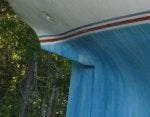
The comment re the islander 28 as being a double ender. MANY IOR boats of the 70's in reality are double enders. While they have a transom per say, the flat part is a foot or so above the WL, and if you look at JUST the WL, you will see a double ender with the upper part of the rudder being out of the water. Myself, while some double/canoe sterns are pretty, I prefer the look of the newer designs that are generally speaking, can be a bit faster due to planing ability down wind etc. BUT, ANY properly built boat can and should survive the end intended useage if the person is up to it. One thing not mentioned by the OP. ARE you sailing around the world? or are you sailing say puget sound/san juans up to the mid BC area east of Vancouver island, or some other what I would call reasonably protected area. A puget sound boat would be different than a world cruiser boat in how you want it designed. Here the BIG cockpit to entertain in, sit in etc would be better than a smaller cockpit boat. Even here, many like pilot house boats so they can sail in the drizzly winter months in the dry. I guess what I am saying, there is NOT a perfect boat per say. BUT, many perfect boats depending upon the how you use your boat. A westsail for weeknight racing, weekend cruising, needing to be somewhat speedy as you only have soo much time, does not work as well for me as one of the newer designed style boat. This is not to say a westsail is an improper boat for someone in a different useage. The boat design useage should match your end use! Marty
blt2ski said: The comment re the islander 28 as being a double ender. MANY IOR boats of the 70's in reality are double enders. While they have a transom per say, the flat part is a foot or so above the WL, and if you look at JUST the WL, you will see a double ender with the upper part of the rudder being out of the water. Myself, while some double/canoe sterns are pretty, I prefer the look of the newer designs that are generally speaking, can be a bit faster due to planing ability down wind etc. BUT, ANY properly built boat can and should survive the end intended useage if the person is up to it. Marty Click to expand...
there are 2 nonsuchs down here....one I beleive is from canada
basically pick your poison... I disagree and agree on many things said by those in the know here...in the end I always fall to the designers notes on said boat and then those with true experience on said boats versus whatever info you can get from "established sources"... the reality is all boats dont do everything perfect...and excell in certain circumstances and fall flat in others overall I would venture to guess that boat designs today perform better than older similar rivals...HOWEVER its not as extreme and fantastic and or great a difference as to render older designs bad or non offshore capable etc... anywhoo regarding waves, yes 10, 20, 30 foot waves can slip under you regardless of stern shape...its the ones that break that show you the difference between stern types and which shape is better, not to mention the speed they are travelling at and what your speed is. just read a couple of moitessiers book(havent we all) on how to handle big waves from behind...his notes on this type of sailing are golden standards to this day. anywhoo last tidbit I had an old wooden h28 with a nice flat transom inwards like many old designs...with an outboard hung rudder of course and a really nice long full keel I could most definetely fill the incredible lift and steadiness this type of transom offers in following seas...because its flat it offered a steady motion, slow lift...and not much wash, something which canoe sterns, some cca boats and some double enders dont have. while wet to windward, on a beam or broad reach and even ddw it was a dream to sail..."on rails"
- ?
- 176.4K members
Top Contributors this Month
- Electric Cars
- Electric Bikes
- Electric Boats
- EV Conversions
- Electric Flight
- Electric Transport
- Hydrogen Fuel Cell
- Readers’ Questions

Electric Candela hydrofoil boat sets world record by crossing Baltic Sea
- September 16, 2024
- One comment
- 2 minute read
- Joshua S. Hill
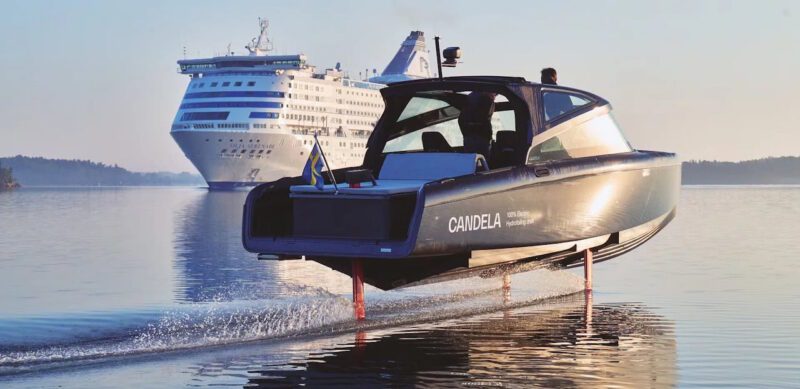
An all-electric hydrofoiling boat from Swedish company Candela has set two new world records by travelling between Stockholm and the Finnish autonomous region of Åland, marking the first time an electric boat has crossed the Baltic Sea.
Candela, which has developed a range of electric hydrofoil boats and ships, wanted to demonstrate that “that zero-emission sea travel is not only possible today, but that foiling electric ships and boats are so much cheaper to operate than fossil-fuelled vessels.”
The record-breaking journey was undertaken in the Candela C-8, a €330,000 ($A544,500) leisure craft, equipped with a battery from technology partner Polestar.
The journey covered 150 nautical miles from the port of Frihamn in Stockholm, Sweden, to Mariehamn, the capital and largest town of the Åland Islands, an autonomous region of Finland, with a charging stop in Kapellskär.
While charging along the trip was made mostly with existing charging infrastructure, a 40kW Kempower Movable Charger was needed in Kapellskär.
Leaving from Frihamn at 6am, the Candela C-8 made it to Mariehamn by lunchtime, and returned to Frihamn the same day.
YouTube : https://www.youtube.com/watch?v=6hFoRF_Q0CA
“The disadvantage of electric boats has been their short range, due to traditional boat hulls consuming so much energy,” said Gustav Hasselskog , the company’s CEO and founder.
“With our hydrofoil technology, we combine high speed and range, but you get so many other benefits. Flying over the Åland Sea in total silence and without slamming was absolutely magical.”
A gasoline-powered chase boat of similar size accompanied the Candela C-8 on the journey and had to be refuelled for a cost of €750, or around $A1,230. For comparison, the Candela C-8 consumed 213 kWh of electricity, at a cost of about €40-50 (around $A66-83).
“We actually had range anxiety, but not for the Candela,” said Gustav Hasselskog.
“The irony is that the photographer’s gasoline-powered chase boat had to refuel six times during the trip, while we only charged three times.
“We’re talking about 95% lower operating costs,” concluded Hasselskog. “This is a revolution that makes waterborne transöport competitive with land transport in terms of costs, which we will now demonstrate in public transport in Stockholm.”
Joshua S. Hill is a Melbourne-based journalist who has been writing about climate change, clean technology, and electric vehicles for over 15 years. He has been reporting on electric vehicles and clean technologies for Renew Economy and The Driven since 2012. His preferred mode of transport is his feet.
We are definitely in an age of disruption, as much as the bashers, critics and cynics like to deny it. Amazing, 1/25th the cost of their ICE partner boat! And quieter, cleaner and calmer too boot!
Input your search keywords and press Enter.
- Today's news
- Reviews and deals
- Climate change
- 2024 election
- Newsletters
- Fall allergies
- Health news
- Mental health
- Sexual health
- Family health
- So mini ways
- Unapologetically
- Buying guides
Entertainment
- How to Watch
- My watchlist
- Stock market
- Biden economy
- Personal finance
- Stocks: most active
- Stocks: gainers
- Stocks: losers
- Trending tickers
- World indices
- US Treasury bonds
- Top mutual funds
- Highest open interest
- Highest implied volatility
- Currency converter
- Basic materials
- Communication services
- Consumer cyclical
- Consumer defensive
- Financial services
- Industrials
- Real estate
- Mutual funds
- Credit cards
- Balance transfer cards
- Cash back cards
- Rewards cards
- Travel cards
- Online checking
- High-yield savings
- Money market
- Home equity loan
- Personal loans
- Student loans
- Options pit
- Fantasy football
- Pro Pick 'Em
- College Pick 'Em
- Fantasy baseball
- Fantasy hockey
- Fantasy basketball
- Download the app
- Daily fantasy
- Scores and schedules
- GameChannel
- World Baseball Classic
- Premier League
- CONCACAF League
- Champions League
- Motorsports
- Horse racing
New on Yahoo

- CA Privacy Notice
Starmer looks to Italy on how to stop migrant boats
Sir Keir Starmer has suggested he will study Italy's asylum processing deal with Albania as part of a "pragmatic" approach to tackling migrant boats crossing the English Channel.
Speaking to reporters, the prime minister said he had discussed the "concept" of Italy's deal during talks in Rome with Italian counterpart Giorgia Meloni.
Meloni said Sir Keir had shown "great interest" in the planned scheme, under which some migrants rescued in Italian waters will be sent to the Balkan country to have their asylum claims processed.
Sir Keir also said he was interested in Italy's model of paying north African countries to do more to stop boat crossings.
Starmer in Italy to discuss migration with PM Meloni
How many people cross the Channel in small boats?
He added that deals with Tunisia and Libya “appears to have had quite a profound effect” in helping Italy cut the number of migrant arrivals.
The Labour government has scrapped a Conservative plan to send asylum seekers on a one-way ticket to Rwanda, where they would only be able to apply for refugee status in the east African nation.
But it has indicated an interest in schemes under which migrants crossing the English Channel could have their applications to stay in the UK processed abroad.
Italy's right-wing government, led by Meloni since October 2022, is not a natural political ally for Labour leader Sir Keir, but he has expressed an interest in learning from its tactics to counter illegal migration.
Under its five-year deal with Albania, agreed last year, some migrants rescued by the Italian coastguard will be sent there to have their asylum claims processed in two centres funded and managed by Italy.
In a key difference with the Rwanda plan, those that succeed will come to Italy as refugees. Those whose applications are rejected will be detained in Albania until they can be returned to their home countries.
Only migrants from countries deemed safe by Italy - whose claims are more likely to be rejected - will be sent, whilst pregnant women, minors and other categories of vulnerable people will be excluded.
The scheme, which the Italian government says will cost €670m (£564m), was meant to start in August but has been delayed, with Meloni saying it will be "few weeks” before it gets going.
It has been criticised by some right groups, who have questioned how failed asylum claims could be properly appealed and argued it could leave people in legal limbo.
En route to Rome, Sir Keir said he was “interested” in learning about the scheme and later confirmed he had discussed it during his meeting with Meloni.
The prime minister also discussed the model with Albanian counterpart Edi Rama during a summit of European leaders in July, when he said he wanted to "look at what works".
Speaking at a press conference, Sir Keir said the impact of Italy's Albania deal was not yet clear because the scheme had yet to begin operating, but he had discussed "the concept of it" with Meloni.
It is not clear, however, how likely it is such a deal could be replicated.
Albania, which is seeking to bolster its longstanding application to join the EU, has suggested that such a deal is only with Italy, its closest ally in Europe.
'British pragmatism'
Sir Keir also underlined he was also interested in Italy's agreements with north African countries, which have emerged as important hubs for migrants attempting to make the journey to Europe.
Alongside the EU, Italy has granted Tunisia financial aid for education and energy projects in return for greater efforts to stop migrants crossing the Mediterranean.
It has an agreement with the UN-backed Libyan government, under which Italy trains and funds the coastguard to intercept migrant boats.
Both of those deals have proved controversial, attracting criticism from rights groups for the treatment of those stopped from crossing.
Sir Keir told reporters this work to stop arrivals "upstream" was a "more likely” factor than the Albania deal in explaining a 64% drop this year in the number of people crossing to Italy from Africa.
"Preventing people leaving their country in the first place is far better than trying to deal with those that have arrived in any of our countries, so I was very interested in that," he added.
"In a sense, today was a return - if you like - to British pragmatism.
"We are pragmatists first and foremost. When we see a challenge we discuss with our friends and allies the different approaches that are being taken [and] look at what works."
However, some Labour backbenchers have criticised their leader for seeking inspiration from Meloni's government.
Liverpool Riverside MP Kim Johnson called it "disturbing," whilst Nottingham East's Nadia Whittome said the UK should not be "taking lessons" from Italy.
Recommended Stories
Chemicals leaching from food packaging found in humans, new study shows. experts call for more safety regulations..
Human exposure to chemicals, including forever chemicals or PFAS, from food packaging is widespread, according to the study. Experts call it "concerning."
Cowboys DC Mike Zimmer, star Micah Parsons on different pages about defensive issues after Saints blowout loss
The Cowboys gave up six straight touchdown drives in their blowout loss to the Saints on Sunday.
UK's privacy watchdog takes credit for rise of 'consent or pay'
The UK's data protection watchdog claims a crack down on websites that don't ask for consent from visitors to track and profile their activity for ad targeting is bearing fruit. On Tuesday local time, the Information Commissioner's Office (ICO) announced it's issued a reprimand to Bonne Terre, the company behind Sky Betting and Gaming, for unlawfully processing people's information without their consent. Research has highlighted the myriad harms that data-driven tracking can pose to vulnerable individuals with addiction problems which may explain why the ICO's public reprimand has focused on a company in the gambling sector.
North London derby reaction, Wiso Vasquez & Amelia Lopez discuss MLS & is there a new face of the NWSL?
Christian and Alexis react to Arsenal’s big win in the North London Derby. Then Christian and Alexis welcome on Wiso Vasquez and Amelia Lopez to chat MLS. Later, Christian and Alexis talk Trinity Rodman’s case to be the new face of the NWSL.
2024 Chase Freedom bonus categories: Get 5% back on PayPal and pet purchases this quarter
Each quarter, Chase Freedom Flex cardholders get access to new 5% bonus categories. These are the current options and how you can start earning now.
OpenAI's new safety board has more power and no Sam Altman
This move comes with a notable shift: CEO Sam Altman is no longer part of the safety committee, marking a departure from the previous structure.
Up to 70% off Le Creuset — here's the biggest and best list of deals to shop now
Retailers like Nordstrom, Amazon, Macy's and more have slashed prices on the brand's most iconic pieces — including the coveted Dutch oven.
Man arrested, charged with stalking after allegedly harassing UConn star Paige Bueckers for months
A 40-year-old Oregon man is being charged with breach of peace, electronic stalking and harassment.
Oxo's 9 cup coffee maker is the most user-friendly machine I've ever tested
It doesn't get simpler than the one-button control on this sleek appliance. It's the best drip coffee maker we tested!
Wisconsin QB Tyler Van Dyke ruled out for season with ACL injury after leaving loss to Alabama early
Tyler Van Dyke went down on the first drive of Wisconsin's loss to Alabama on Saturday afternoon.
Haitian immigrants in Springfield, Ohio, say they fear for their safety amid Trump and Vance’s false claims
The Haitian community in Springfield, Ohio has reported concerns for their safety amid false claims spread by former President Donald Trump and Ohio Sen. JD Vance.
Women 60+ love this 'very hydrating' stem cell-infused moisturizer, down to $15
The collagen cream uses skin-loving ingredients and innovative plant derivatives to give skin a more radiant, youthful appearance.
This rich-mom-style sweatshirt 'rivals Lululemon' — it's just $28 (over 45% off)
'Flattering fit and so comfy': Get this on-trend pullover for a fourth of what its splurgier counterpart costs.
Microsoft Copilot: Everything you need to know about Microsoft's AI
Copilot is Microsoft's take on productivity-boosting generative AI, and it continues to grow and expand with Microsoft's AI ambitions. Today, there are around a dozen Copilot-branded products powering various capabilities in Microsoft software and services, like summarizations in Microsoft Outlook and transcriptions in Microsoft Teams. In this post, we explain the many Microsoft Copilots available and what they do, and the differences between the premium and free editions.
New Yahoo News/YouGov poll: 8% of Americans say Taylor Swift’s endorsement makes them more likely to vote for Kamala Harris
Swift is unlikely to transform Trump voters into Harris voters, or vice versa. But she could convince some non-voters to turn out for Harris.
'The CliffsNotes of air frying': This No. 1 bestselling cheat sheet is down to $10
It takes the guesswork out of preparing 120+ types of food and even has a magnet so you can stick it to the fridge.
Commentary: 3 charts Kamala Harris ought to memorize
Voters have a dismal outlook for income gains and purchasing power. And it's not just inflation that bothers them.
Texas QB Quinn Ewers 'questionable' for game vs. Louisiana-Monroe, says coach Steve Sarkisian
Texas quarterback Quinn Ewers may miss Week 3's matchup with Louisiana-Monroe after suffering an abdominal injury versus UTSA.
Jennifer Lopez and Ben Affleck's 'affectionate' weekend reunion prompts questions around divorce. Here's what's going on.
Jennifer Lopez and Ben Affleck take their kids out to lunch, nearly one month after she filed for divorce. So, what does this mean for their relationship?
Amazon October Prime Day 2024: Early deals and everything to know about the Big Deal Days sale
The biggest shopping event of the fall kicks off next month. Here are all the details, along with stellar sales you can score right now.
- Site search Search

- School Tools:
- Best of Hawaii:
- Best of Hawaii

Police open unattended death investigation after body found near Waianae
- Updated 2 hrs ago
Weather Alert
Coastal flood statement until tue 6:00 pm hst.

- Copy article link
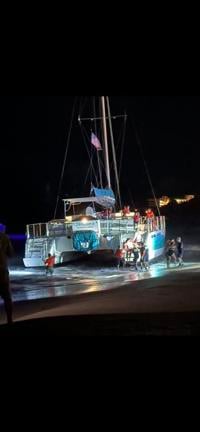
A Teralani Sunset Sail boat ran aground near Whalers Village on Maui Tuesday night. Four people were hospitalized after the incident, which occurred around 7 p.m.
Two hospitalized after boat runs aground near Ka'anapali's Whalers Village
- By Carly Yoshida, Matthew Nuttle, and 'A'ali'i Dukelow
- Sep 11, 2024
- Sep 11, 2024 Updated Sep 12, 2024
Four people were injured and two of them were hospitalized after a boat accident last night near Whalers Village in Ka'anapali.
KA'ANAPALI, Hawai'i (Island News) -- Four people were injured and two of them were hospitalized following a boat accident Tuesday night near Whalers Village in Ka'anapali.
The Teralani catamaran, part of the popular Teralani Sunset Sail tour, ran aground in shallow waters around 7 p.m. A distress call prompted a swift response from the Maui Fire Department (MFD), who successfully evacuated all passengers by 8:30 p.m.
The scene was later turned over to the Department of Land and Natural Resources (DLNR) for further investigation.
According to a spokesperson from the Teralani Tour Company, the cause of the grounding was due to “bad timing,” saying that swells were increasing at the time making it difficult to navigate in the “jam-packed” shoreline and there was nowhere to dock.
Teralani Tour Company contacted the US Coast Guard (USCG), Maui Police, and DLNR as soon as the boat became stuck.
The vessel was hosting a dinner cruise with 53 people on board at the time of the incident. It is unclear if the four injured were passengers or crew members -- and there is no word on their condition.
Visitor Wendy Mckenzie of Seattle, Washington said her morning tour with the company was rescheduled because of the incident.
"They were very kind about it, the company, we've toured with them many times and they have a great crew," Mckenzie said.
"Their biggest concern is always safety and that's why they canceled our tour this morning, because they said they wanted to make sure everything was safe, so that's how I feel. Safety is their number one concern."
However, others are not as forgiving as Mckenzie, with some calling on the state to revoke the company's permit.
A representative from the charter business told Island News their workers complete extensive training, earning a coast guard license, as well as a lifeguard certification.

Shop and support Lahaina Businesses at Kokua for Maui on Friday
- By Jeremiah Estrada
Do you have a story idea? Email news tips to [email protected]
Carly Yoshida
Weather Anchor
Carly Yoshida was born and raised on Hawai’i Island where she graduated from Kealakehe High School. Carly is a former Miss Hawaii’s Outstanding Teen 2016 as well as Miss Kona Coffee 2020 and 2021.
- Author email
Get email notifications on {{subject}} daily!
{{description}}
Email notifications are only sent once a day, and only if there are new matching items.
Followed notifications
Please log in to use this feature.
Matthew Nuttle
Digital Content Manager
Matthew has been the digital content manager for KITV4 since September 2021. Matthew is a prolific writer, editor, and self-described "newsie" who's worked in television markets in Oklahoma, California, and Hawaii.
- Author facebook
'A'ali'i Dukelow
'A'ali'i is a reporter with KITV. He was born and raised on the island of Maui and graduated from the University of Southern California with a bachelor's degree in Journalism.
- Author twitter
More From KITV 4 Island News

Suspect arrested after hours-long standoff in Kailua
- Updated Aug 29, 2023

Newly-released recordings change Lahaina fire timeline
- Updated Dec 31, 2023

Waikiki pavilions cleared out to make way for new vendors
- Updated Dec 9, 2021

Bill in legislature aims to give rebates for electric mopeds and e-bikes
- Updated Jun 10, 2022

ICYMI: 4 stories from around Hawaii that you Need to Know from KITV4
- Jun 15, 2022

Uncle Bo's expanding on Oahu with fourth restaurant in Waikiki
- Updated Apr 14, 2023
Recommended for you
- Israel-Gaza War
- War in Ukraine
- US Election
- US & Canada
- UK Politics
- N. Ireland Politics
- Scotland Politics
- Wales Politics
- Latin America
- Middle East
- In Pictures
- BBC InDepth
- Executive Lounge
- Technology of Business
- Women at the Helm
- Future of Business
- Science & Health
- Artificial Intelligence
- AI v the Mind
- Film & TV
- Art & Design
- Entertainment News
- Arts in Motion
- Destinations
- Australia and Pacific
- Caribbean & Bermuda
- Central America
- North America
- South America
- World’s Table
- Culture & Experiences
- The SpeciaList
- Natural Wonders
- Weather & Science
- Climate Solutions
- Sustainable Business
- Green Living
Ex-police chief to lead efforts to tackle small boats

Former police chief Martin Hewitt has been appointed to lead the UK's new Border Security Command, which will focus on tackling small boat crossings.
As chairman of the National Police Chiefs' Council (NPCC), Mr Hewitt previously coordinated action by UK police forces on issues including terrorism and organised crime.
He will join Sir Keir Starmer on a visit to Rome on Monday, where the prime minister will meet his Italian counterpart Giorgia Meloni to learn from her country's approach to tackling illegal migration.
Italy has recently seen a dramatic fall in the number of migrants making the dangerous crossing from north Africa.
Reducing the number of people crossing the Channel from France in small boats is one of the major challenges facing the new Labour government.
Over the weekend eight people died attempting the crossing .
The Border Security Command will bring together intelligence agencies, police and border force officials to tackle the smuggling gangs behind small boat crossings.
Mr Hewitt led the NPCC between 2019 and 2023 and previously served as an assistant commissioner in the Metropolitan Police.
Downing Street said his experience coordinating the work of police, government and other agencies, including responding to major securing threats and managing the UK's response to the Covid pandemic, was "key to his appointment".
Prime Minister Sir Keir Starmer said: "No more gimmicks. This government will tackle the smuggling gangs who trade the lives of men, women and children across borders.
"Martin Hewitt’s unique expertise will lead a new era of international enforcement to dismantle these networks, protect our shores and bring order to the asylum system."
Mr Hewitt said: "I am under no illusions of the challenges that lie ahead, but I am determined to face them head-on.
“For too long, the criminal gangs who smuggle people through Europe have abused our borders in the name of profit, and they are responsible for the deaths of scores of vulnerable, innocent people."

During their visit to Rome, Sir Keir and Mr Hewitt will tour Italy's National Coordination Centre for Migration to see how the country responds to illegal migration and discuss future cooperation.
Over the weekend, Sir Keir said he was "interested" in Italy's migration deal with Albania, under which migrants rescued at sea will be sent to the Balkan country while their asylum claims are processed.
Asked whether he would consider pursuing a similar agreement, Sir Keir said: "Let's see. It's in the early days, I'm interested in how that works, I think everybody else is."
Reception centres in Albania are due to open later this year, after some delays.
After winning power, Labour scrapped the previous Conservative government's plan to send some asylum seekers to Rwanda from the UK.
Under the Italian agreement, migrants will still be able to apply for asylum in Italy while they are in Albania. If refused, they will face deportation.
This differs from the now-abandoned Rwanda scheme, where asylum seekers would not have been allowed to return to the UK if their claim was accepted and would instead have been able to stay in Rwanda.
A Conservative Party spokesman said: "Keir Starmer has absolutely no plan to stop the boats, and that’s why he’s now resorting to trying to copy others."
He said Labour had "scrapped this country’s deterrent to illegal immigration and signalled to the vile people smuggling gangs they were not willing to take the serious action needed to stop the boats".
Starmer to discuss migrant boat crossings with Meloni in Italy
Italy prepares to open controversial migrant centre in albania.
Frontex, the EU’s border force, has calculated a 64% drop this year in those making the crossing from North Africa to Italy.
Central to the fall in crossings to Italy are financial deals struck with Tunisia and Libya – where most people depart from for Europe.
The EU has given Tunisia funding to boost border security, while Italy has supplied patrol vessels and given the government money to support small companies and invest in education and renewable energy.
Italian Prime Minister Meloni, who leads a right-wing coalition in Italy, was a close ally of Sir Keir's Conservative predecessor Rishi Sunak.
Sir Keir's visit comes as he seeks a wider "reset" of relations with Europe after Brexit, and follows meetings with German Chancellor Olaf Scholz and French President Emmanuel Macron.
Sir Keir Starmer promises 'pragmatism' on small boats amid hints government could look to Albania
Italy's plan to process migrants in Albania has come in for criticism from human rights campaigners. But Sir Keir Starmer says some of the other work of the country's government has been successful in reducing boat crossings.
Political reporter @NifS
Monday 16 September 2024 15:07, UK

The prime minister has said the UK has moved "from a government of gimmicks to a government of pragmatism" as he attempts to tackle the small boat crisis.
Sir Keir Starmer is in Rome to hold talks with his Italian counterpart Giorgia Meloni about a range of issues, including irregular migration and her controversial plans to process asylum seekers in Albania .
Politics live: Starmer in Italy to learn from 'dramatic reductions' in asylum
Ahead of the meeting, he said her efforts had led to "dramatic reductions" of boat arrivals - around 60% - and he "wanted to understand how that came about".
But pushed on whether he would be seeking to replicate the Albania scheme, which has caused concern among human rights campaigners, Sir Keir insisted his focus was still on "taking down the gangs that run this vile trade".

Keep up with all the latest news from the UK and around the world by following Sky News
"We discussed the Albania arrangement, which is not up and running yet... therefore we don't yet know the outcome of it," he said.
"We discussed the concept of it, along with the prevention piece as well, because the numbers here, as I've said, have gone down quite significantly. That's actually not attributable, of course, to the Albania scheme because that hasn't started.
"That, in my view, is more likely attributable to the work that the prime minister has done upstream... with some of the countries where migrants are coming from."
He added: "I've always made the argument that preventing people leaving their country in the first place is far better than trying to deal with those that have arrived in any of our countries. So I was very interested in that.
"In a sense today was a return... to British pragmatism. We are pragmatists first and foremost, when we see a challenge, we discuss with our friends and allies the different approaches that are being taken, look at what works, and that's the approach that we've taken today - and it's been a very productive day."
The Albania scheme has been compared by some to the previous Conservative government's Rwanda deportation plan , which Labour scrapped days after it entered office.
But the main difference is those granted asylum after processing in Albania would then be allowed to live in Italy, instead of remaining in the third country.
Please use Chrome browser for a more accessible video player

Pointing to his predecessor's plans, the prime minister said: "We've moved from a government of gimmicks to a government of pragmatism, and that means that I'm utterly focused on what I think is the most likely deterrent and effective way of dealing with unlawful migration, and that is to take down the gangs that are running this vile trade.
"Of course it's a problem when we've got people arriving into the UK who are arriving unlawfully across the Channel or any other routes. And of course, every government has the responsibility of making sure our borders are secure.
"But rather than a gimmick which, as you know, cost £700m to persuade four volunteers to go to Rwanda, we have gone down the road of pragmatism already."

Sir Keir said his government would instead focus on the work of its new Border Security Command - whose new chief was confirmed last night as former National Police Chiefs' Council chair Martin Hewitt - as well as sending people back to their countries of origin if they are not entitled to be in the UK and doing "upstream" work in the countries people are travelling from.
"That's what this is about," he said. "It's about the politics of pragmatism. The British are very good at pragmatism. It's what we've been known for over the years, which is seeing a problem and actually rolling up our sleeves and thinking through which is the most effective way to deal with it.
"Under the last government, in my view, we had a gimmick that didn't work, and cost an absolute fortune. And we're not interested in that."
Be the first to get Breaking News
Install the Sky News app for free

Sir Keir's visit is the latest in a series of trips around Europe as he seeks to reset relations with the EU post-Brexit, calling it a "new era".
It also comes after another 1,000 asylum seekers arrived in the UK after making the dangerous crossing over the weekend, with eight people dying in the Channel on Saturday night after their boat crashed into rocks off the coast of France.
Campaigners said the deaths were an "avoidable tragedy", and Amnesty International UK repeated calls for the government to create more safe and legal routes for asylum seekers to come to the UK.
A spokesperson for the group said: "The government should be trying to restore the UK's battered reputation on refugee issues by repairing an asylum system that's been deliberately sabotaged by successive home secretaries stretching back years."
But earlier, a Number 10 spokesperson said there were no plans to introduce more legal asylum routes to the UK.
Related Topics
- Sir Keir Starmer

IMAGES
VIDEO
COMMENTS
Browse a wide selection of multi-hull sailboats, including catamarans and trimarans, from various brands and models. Find your dream boat by price, length, year, location and more.
Learn about different types of sailboats with two masts, such as ketch, yawl, and brigantine, and see pictures and prices of used models. Find out the benefits and drawbacks of buying a used boat with two masts and how to choose the best one for your needs.
Find out which catamaran and multihull models won the European Yacht of the Year Awards in 2024. Read the reviews and comparisons of the nominees, including Outremer 52, Neel 52, HH44, Nautitech ...
Find new and used catamarans and trimarans from various manufacturers and models. Compare prices, features, specifications and photos of multi-hull boats for sale on boats.com.
These sailboats have a minimum total sail area of 624 square feet, a maximum total sail area of 3,630 square feet and an average of 968 square feet. Boat Trader currently has 199 multi-hull sailboats for sale, including 76 new vessels and 123 used and custom yachts listed by both individual owners and professional boat dealers mainly in United ...
This web page reviews the best two and three hulled yachts for cruising, but none of them are small or have three hulls. It covers the features, prices and performance of various models from 37-43ft, such as Excess 11 and Lagoon 42.
Learn about the different types of two-mast sailboats, such as yawl, ketch, schooner, and brig. Find out the characteristics, advantages, and disadvantages of each type and how they are used by sailors.
Learn the names and features of five common types of two-masted sailboats: ketch, schooner, yawl, brig, and brigantine. Find out how to recognize them by their sail design, rigging configuration, and performance.
WITH THE SHORT, almost 6-foot headroom house, the interior of a Frances could feel much larger than you'd expect on a 26-foot boat. This is a custom WEST-system boat built in New Zealand. The Aft Head arrangement for the Frances with one seaberth and a permanent double.
Learn about the different types of two masted sailing boats, their origins, features and advantages. Find out how to distinguish between yawl, schooner, ketch and brigantine based on their mast positions and sail shapes.
Five Ocean-Going Sailboats With Two Masts. Some of the most reputable boat builders in the world favor ketch and yawl rigs. Some popular sailboats with two masts used nowadays include the Nicholson 38, the Bayfield 40, the Amel Super Maramu, the Hinckley Bermuda 40, and the Bowman 46. Let's look at each model.
CAROL is a small, simple and seaworthy pocket cruiser designed by Chuck Paine in 1979. She has a double-ended hull, a powerful rig and a minimalist interior for two persons.
A list of the most popular production sailboats of all time, ranked by readers' votes. Find out the features, history and design of each boat, from the Moore 24 to the Nor'Sea 27.
A list of affordable and seaworthy sailboats for serious voyaging, from Island Packet 35 to Prout Snowgoose 37. Find out the pros and cons of these boats, their prices and availability, and how they perform in the trade winds.
LaLa is the first Sakonnet 23, a double-ended sailboat designed by Joel White and built by Joe Norton III. It is a classic wooden boat that has been featured in many publications and has a small-scale model based on it.
A used double-ender sail boat on TheYachtMarket.com ranges in price from £29,900 GBP to £1,390,000 GBP with an average price of £364,000 GBP. Factors including the condition, age, model and specification will affect the price of a double-ender. Used Sail Double-ender for sale from around the world. Search our full range of used Double-ender ...
For some reason double enders were seen as safer offshore boats. This probably came from the Colin Archer lifeboat tradition. But there were all sorts of strange theories as to why the double ender was the best hull form for offshore. "The stern parts the following seas.". I call this the "Moses effect".
A builder shares his experience of building and sailing a Caledonia Yawl II, a double-ended beach boat with a sail-and-oar rig. The article includes details of the design, construction, and performance of the boat, as well as tips and lessons learned.
Learn about the history, uses, and advantages of double ender boats, which have two pointed ends and can travel in both directions. Find out the different types of double enders, such as sailboats, powerboats, canoes, and kayaks.
This fine-ended double ender was a great shape for rough sea conditions. In theory, when a boat is running before breaking waves its own wake can disturb the waves astern and cause them to break. These fine-ended double enders threw smaller wakes and so were less likely to cause waves too break on them from astern.
How much do dual console boats cost? Dual Console boats for sale on Boat Trader are listed at a swath of prices from a reasonable $11,945 on the most reasonably-priced watercraft all the way up to $874,150 for the most extravagant types. Models with the greatest power can hold motors up to a tremendous 2,400 horsepower, while the most compact ...
10-22-2010, 06:33 AM. Re: Small open Scandinavian double-enders. Paul, JII is basically a slightly narrower version of the Arctic Tern, the Ness boat came first then it was slightly modified to be the JII, same length. The JII was modified to be 6 strakes and slightly broader beam, about 2", to be a little less tender.
An all-electric hydrofoiling boat from Swedish company Candela has set two new world records by travelling between Stockholm and the Finnish autonomous region of Åland, marking the first time an electric boat has crossed the Baltic Sea. Candela, which has developed a range of electric hydrofoil ...
Sir Keir Starmer has suggested he will study Italy's asylum processing deal with Albania as part of a "pragmatic" approach to tackling migrant boats crossing the English Channel. Speaking to ...
A Teralani Sunset Sail boat ran aground near Whalers Village on Maui Tuesday night. Four people were hospitalized after the incident, which occurred around 7 p.m.
Former police chief Martin Hewitt has been appointed to lead the UK's new Border Security Command, which will focus on tackling small boat crossings.
Sir Keir Starmer promises 'pragmatism' on small boats amid hints government could look to Albania . Italy's plan to process migrants in Albania has come in for criticism from human rights campaigners.
The same day, 14 boats carrying 801 migrants reached Britain. RELATED COVERAGE Moroccan authorities stop migration attempt into Spanish enclave of Ceuta. Germany begins conducting checks at all its land borders. At least 8 people have died trying to cross the English Channel. The number of migrants arriving in Italy by boat in the first half of ...